A conic sectionA curve obtained from the intersection of a right circular cone and a plane. is a curve obtained from the intersection of a right circular cone and a plane. The conic sections are the parabola, circle, ellipse, and hyperbola.
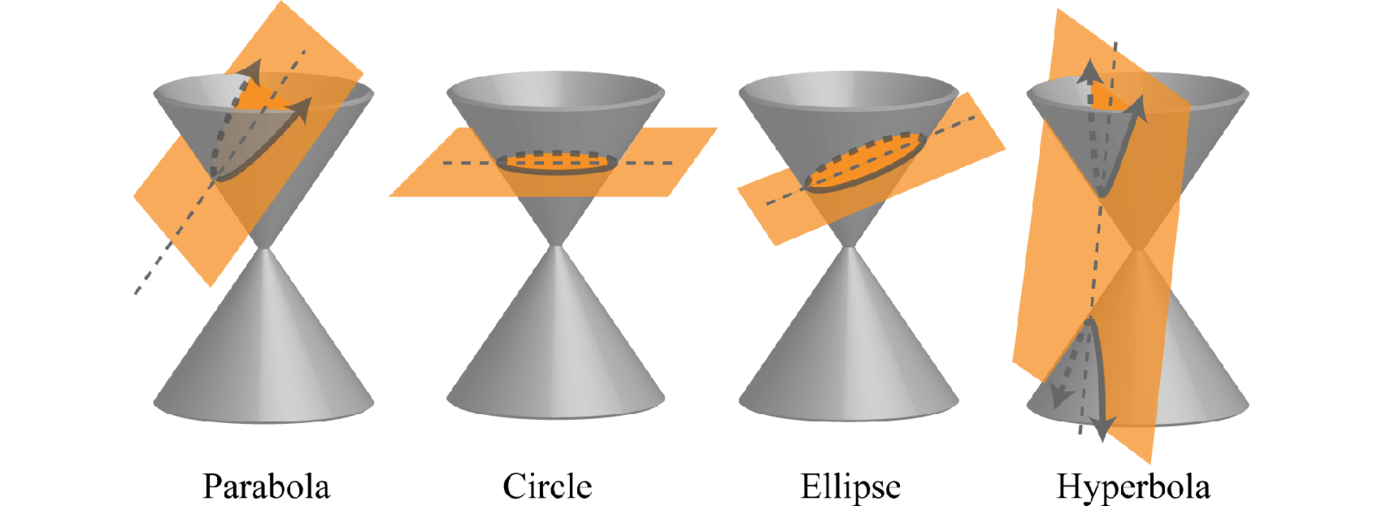
The goal is to sketch these graphs on a rectangular coordinate plane.
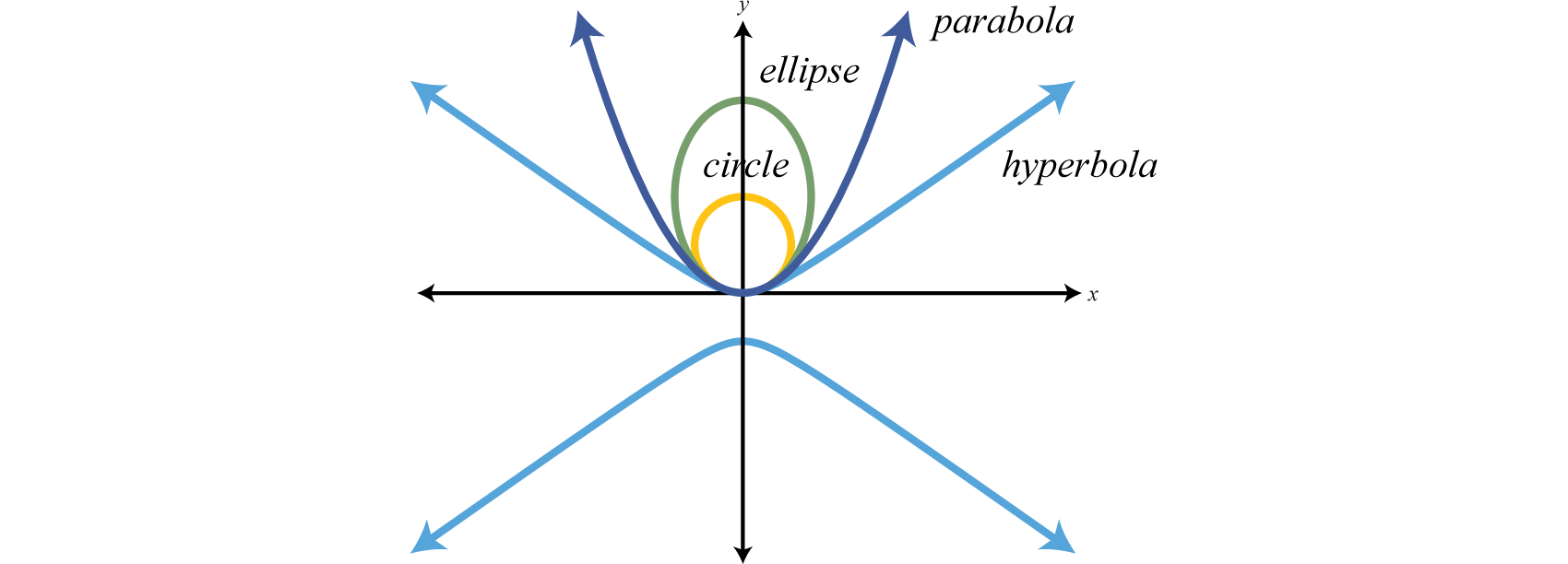
We begin with a review of the distance formulaGiven two points and , the distance d between them is given by .. Given two points and in a rectangular coordinate plane, the distance d between them is given by the distance formula,
Furthermore, the point that bisects the line segment formed by these two points is called the midpointGiven two points and , the midpoint is an ordered pair given by and is given by the formula,
The midpoint is an ordered pair formed by the average of the x-values and the average of the y-values.
Given and calculate the distance and midpoint between them.
Solution:
In this case, we will use the formulas with the following points:
It is a good practice to include the formula in its general form before substituting values for the variables; this improves readability and reduces the probability of making errors.
Next determine the midpoint.
Plotting these points on a graph we have,
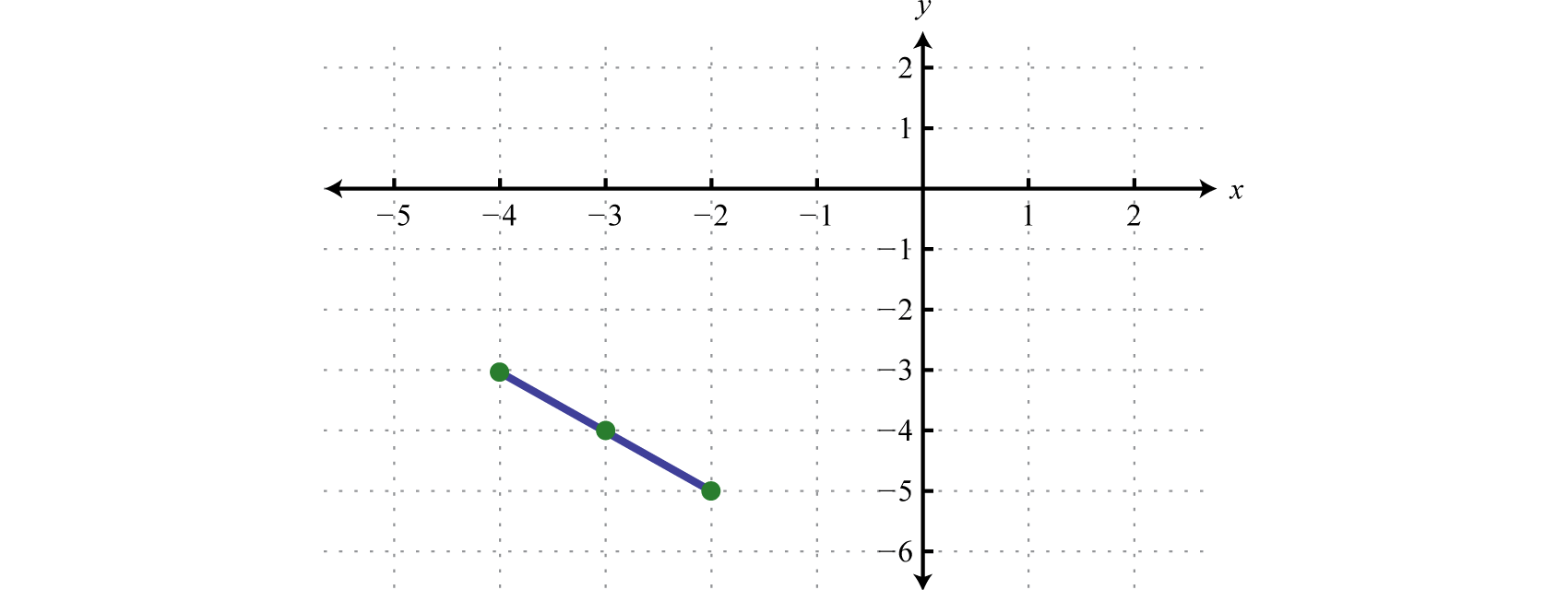
Answer: Distance: units; midpoint:
The diameter of a circle is defined by the two points and Determine the radius of the circle and use it to calculate its area.
Solution:
Find the diameter using the distance formula.
Recall that the radius of a circle is one-half of the circle’s diameter. Therefore, if units, then
The area of a circle is given by the formula and we have
Area is measured in square units.
Answer: Radius: units; area: square units
Try this! Given and calculate the distance and midpoint between them.
Answer: Distance: units; midpoint:
A parabolaThe set of points in a plane equidistant from a given line, called the directrix, and a point not on the line, called the focus. is the set of points in a plane equidistant from a given line, called the directrix, and a point not on the line, called the focus. In other words, if given a line L the directrix, and a point F the focus, then is a point on the parabola if the shortest distance from it to the focus and from it to the line is equal as pictured below:

The vertex of the parabola is the point where the shortest distance to the directrix is at a minimum. In addition, a parabola is formed by the intersection of a cone with an oblique plane that is parallel to the side of the cone:

Recall that the graph of a quadratic function, a polynomial function of degree 2, is parabolic. We can write the equation of a parabola in general formThe equation of a parabola written in the form or , where a, b, and c are real numbers and or we can write the equation of a parabola in standard formThe equation of a parabola written in the form or :
Here a, b, and c are real numbers, Both forms are useful in determining the general shape of the graph. However, in this section we will focus on obtaining standard form, which is often called vertex formThe equation of a parabola written in standard form is often called vertex form. In this form the vertex is apparent: . Given a quadratic function in standard form, the vertex is To see that this is the case, consider graphing using transformations.
Use these translations to sketch the graph,
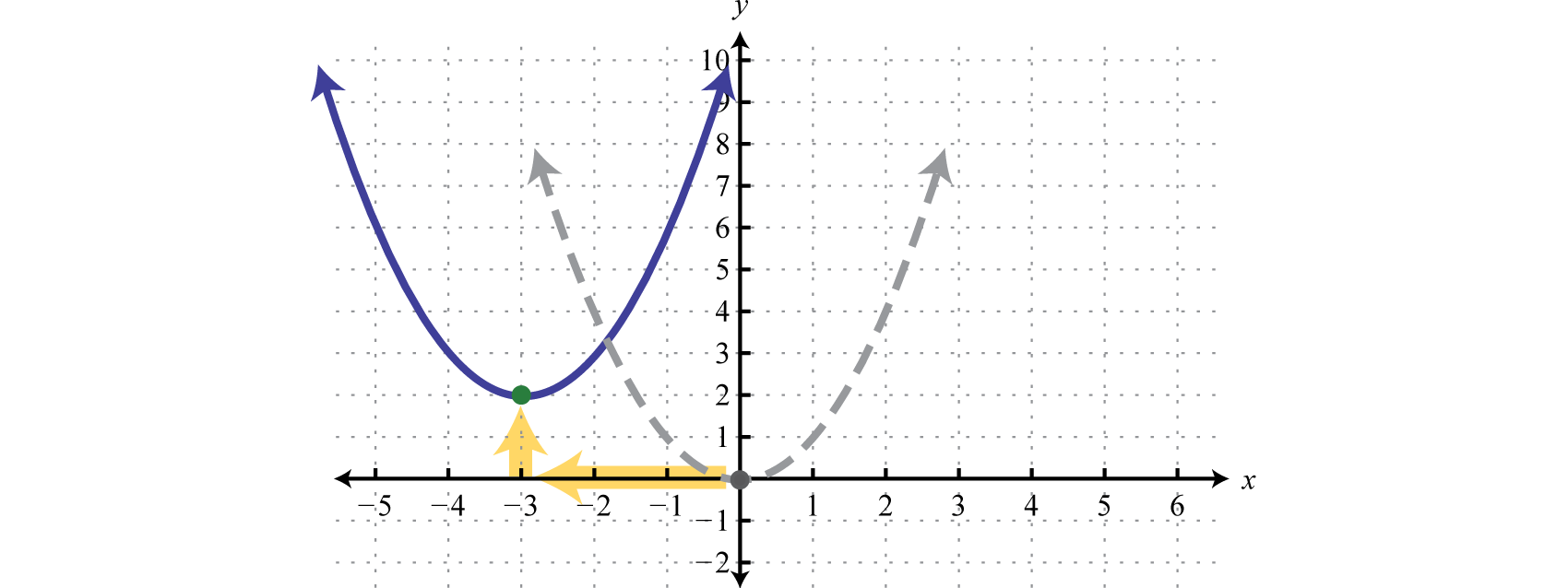
Here we can see that the vertex is This can be determined directly from the equation in standard form,
Written in this form we can see that the vertex is However, the equation is typically not given in standard form. Transforming general form to standard form, by completing the square, is the main process by which we will sketch all of the conic sections.
Rewrite the equation in standard form and determine the vertex of its graph:
Solution:
Begin by making room for the constant term that completes the square.
The idea is to add and subtract the value that completes the square, , and then factor. In this case, add and subtract
Adding and subtracting the same value within an expression does not change it. Doing so is equivalent to adding 0. Once the equation is in this form, we can easily determine the vertex.
Here we have a translation to the right 4 units and down 1 unit. Hence, h = 4 and k = −1.
Answer: ; vertex:
If there is a leading coefficient other than 1, then begin by factoring out that leading coefficient from the first two terms of the trinomial.
Rewrite the equation in standard form and determine the vertex of the graph:
Solution:
Since , factor this out of the first two terms in order to complete the square. Leave room inside the parentheses to add and subtract the value that completes the square.
Now use −6 to determine the value that completes the square. In this case, . Add and subtract 9 and factor as follows:
In this form, we can easily determine the vertex.
Here h = 3 and k = 2.
Answer: ; vertex:
Make use of both general form and standard form when sketching the graph of a parabola.
Graph:
Solution:
From the previous example we have two equivalent forms of this equation,
Recall that if the leading coefficient the parabola opens upward and if the parabola opens downward. In this case, and we conclude the parabola opens downward. Use general form to determine the y-intercept. When we can see that the y-intercept is From the equation in standard form, we can see that the vertex is To find the x-intercept we could use either form. In this case, we will use standard form to determine the x-values where ,
Here or and therefore the x-intercepts are and Use this information to sketch the graph.
Answer:
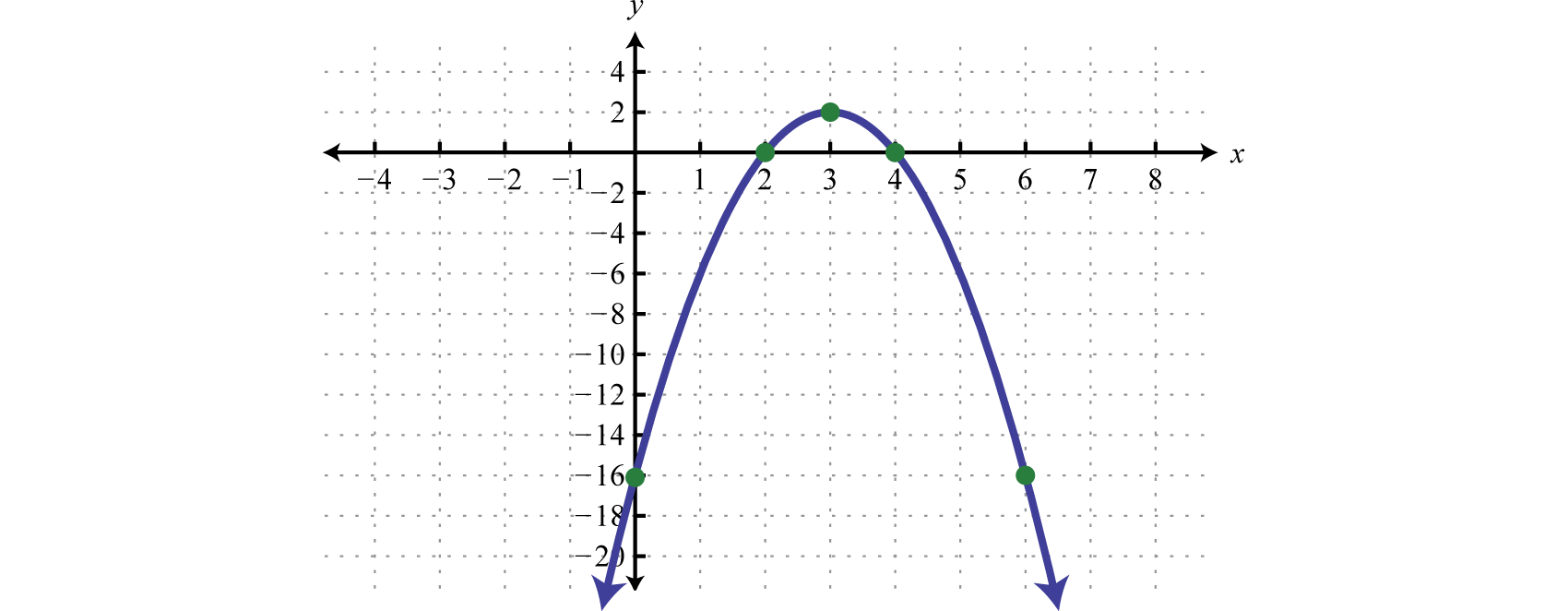
So far we have been sketching parabolas that open upward or downward because these graphs represent functions. At this point we extend our study to include parabolas that open right or left. If we take the equation that defines the parabola in the previous example,
and switch the x and y values we obtain
This produces a new graph with symmetry about the line
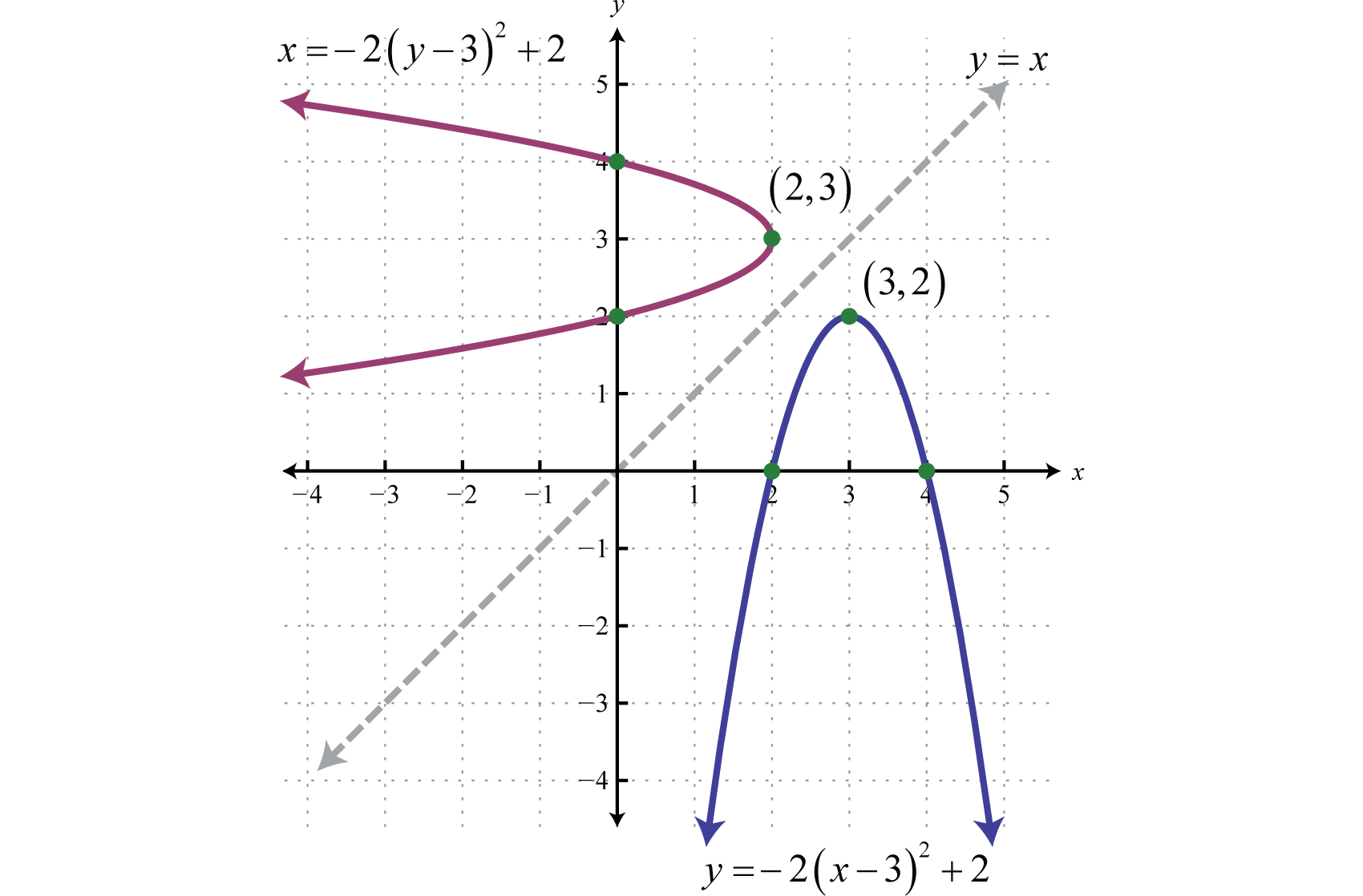
Note that the resulting graph is not a function. However, it does have the same general parabolic shape that opens left. We can recognize equations of parabolas that open left or right by noticing that they are quadratic in y instead of x. Graphing parabolas that open left or right is similar to graphing parabolas that open upward and downward. In general, we have

In all cases, the vertex is Take care to note the placement of h and k in each equation.
Graph:
Solution:
Because the coefficient of is positive, , we conclude that the graph is a parabola that opens to the right. Furthermore, when it is clear that and therefore the x-intercept is Complete the square to obtain standard form. Here we will add and subtract
Therefore,
From this we can see that the vertex Next use standard form to find the y-intercepts by setting
The y-intercepts are and Use this information to sketch the graph.
Answer:
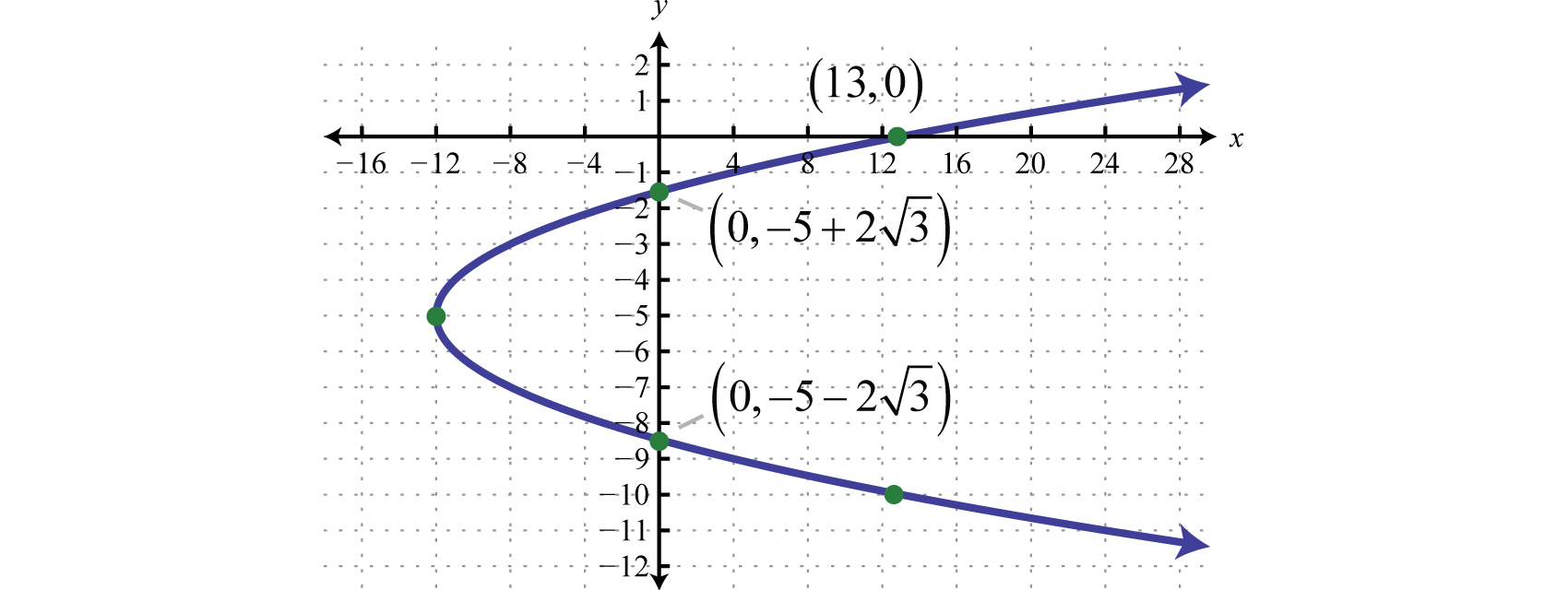
Graph:
Solution:
Because the coefficient of is , we conclude that the graph is a parabola that opens to the left. Furthermore, when it is clear that and therefore the x-intercept is Begin by factoring out the leading coefficient as follows:
Here we will add and subtract
Therefore, from vertex form, , we can see that the vertex is Because the vertex is at and the parabola opens to the left, we can conclude that there are no y-intercepts. Since we only have two points, choose some y-values and find the corresponding x-values.
Answer:

Calculate the distance and midpoint between the given two points.
and
and
and
and
and
and
and
and
and
and
and
and
and
and
and
and
Determine the area of a circle whose diameter is defined by the given two points.
and
and
and
and
and
and
Determine the perimeter of the triangle given the coordinates of the vertices.
, , and
, , and
, , and
, , and
Find a so that the distance d between the points is equal to the given quantity.
and ; units
and ; units
and ; units
and ; units
Graph. Be sure to find the vertex and all intercepts.
Rewrite in standard form and give the vertex.
Rewrite in standard form and graph. Be sure to find the vertex and all intercepts.
Research and discuss real-world applications that involve a parabola.
Do all parabolas have x-intercepts? Explain.
Do all parabolas have y-intercepts? Explain.
Make up your own parabola that opens left or right, write it in general form, and graph it.
Distance: 10 units; midpoint:
Distance: units; midpoint:
Distance: units; midpoint:
Distance: units; midpoint:
Distance: units; midpoint:
Distance: units; midpoint:
Distance: units; midpoint:
Distance: units; midpoint:
square units
square units
square units
units
12 units
−2, 6
2, 4
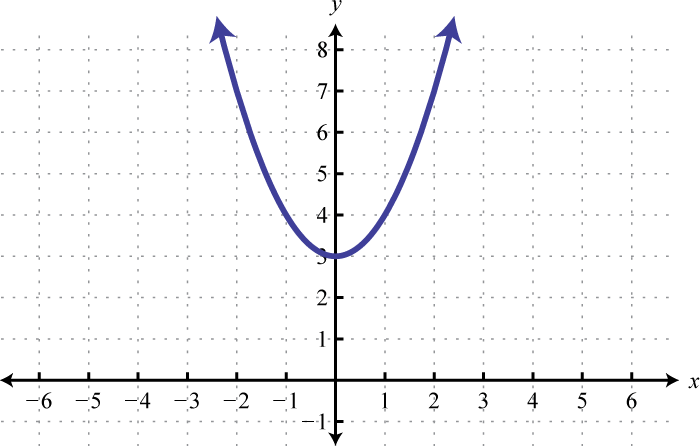
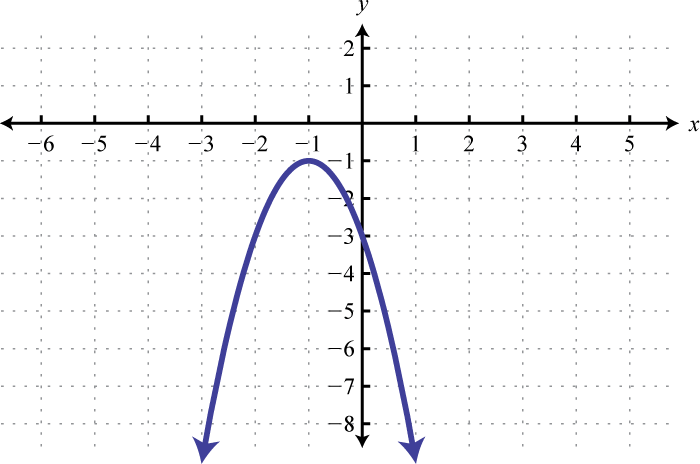
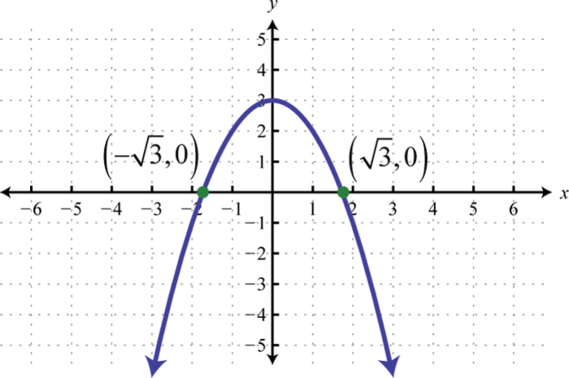
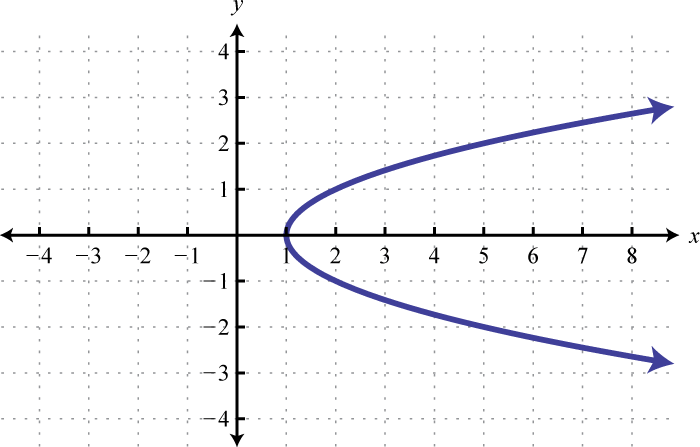


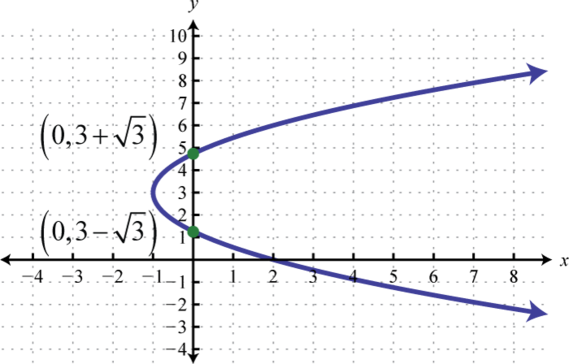
; vertex:
; vertex:
; vertex:
; vertex:
; vertex:
; vertex:
; vertex:
;
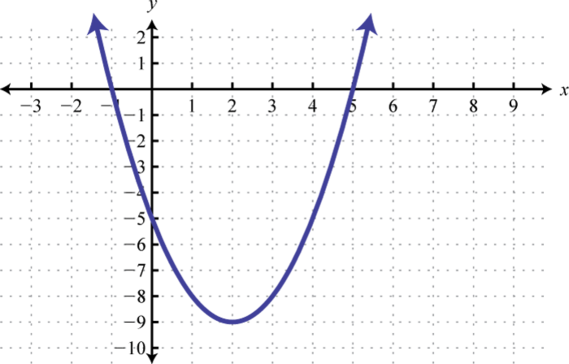
;
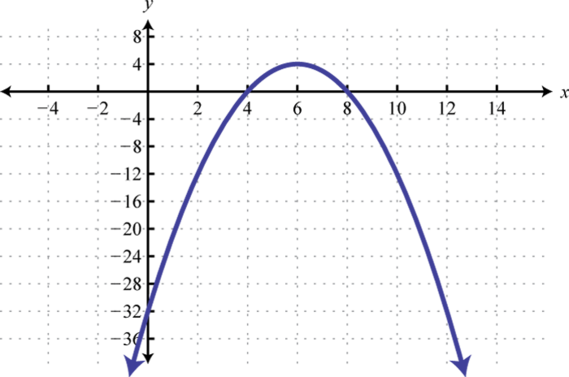
;
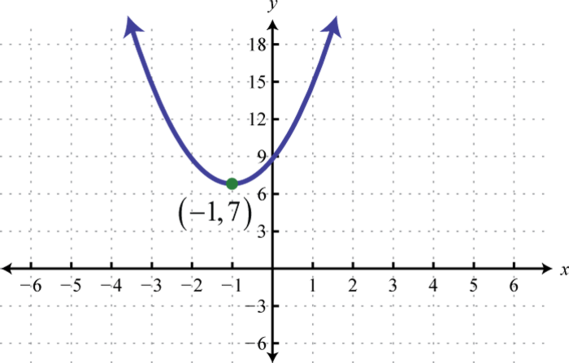
;
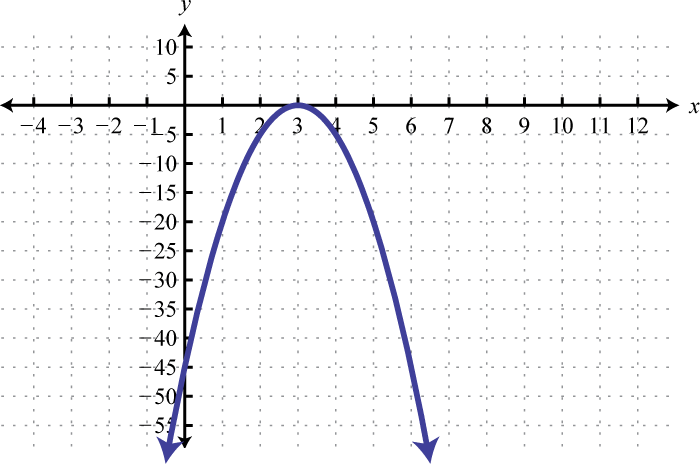
;
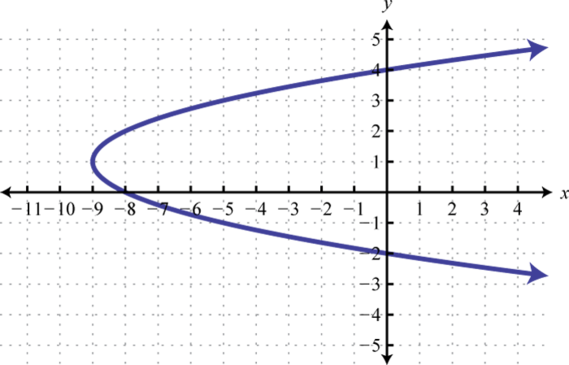
;
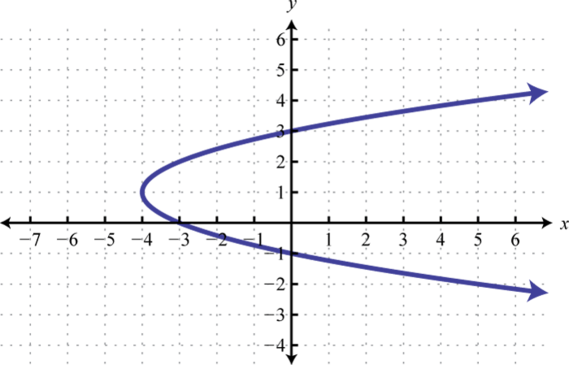
;
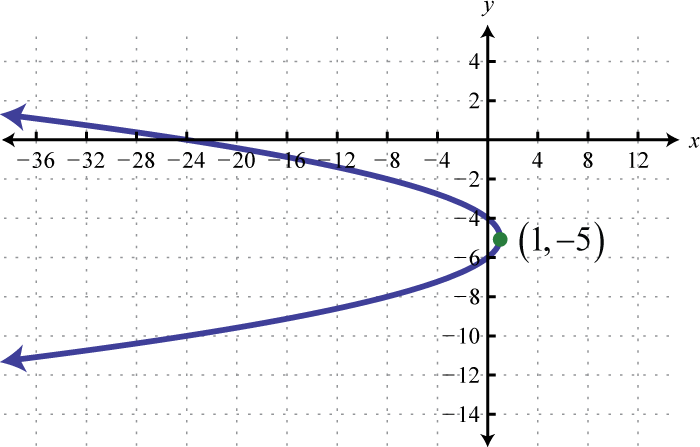
;
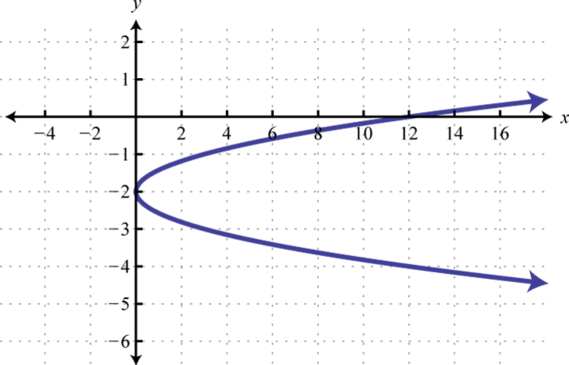
;
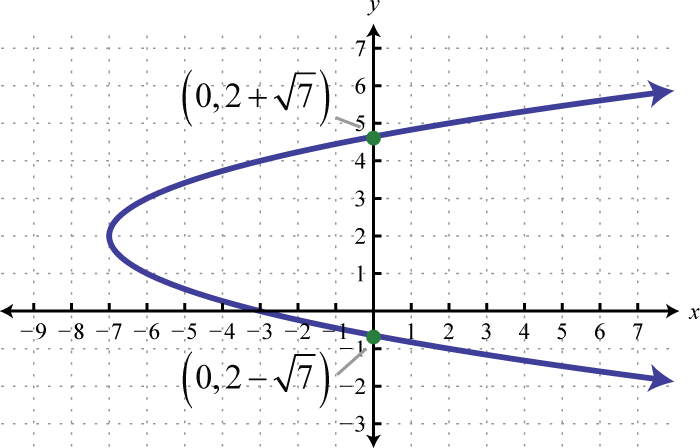
;
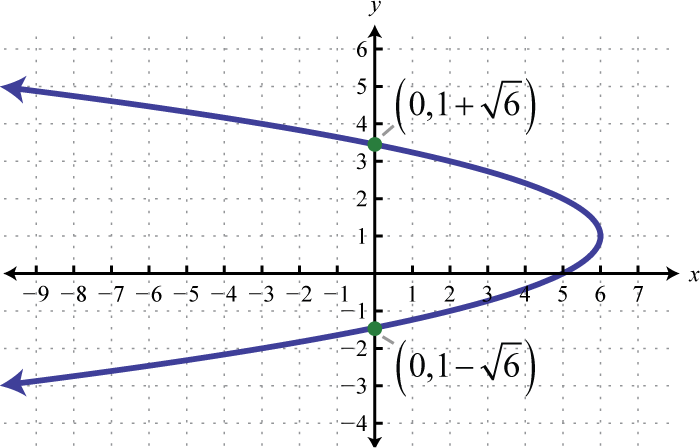
;
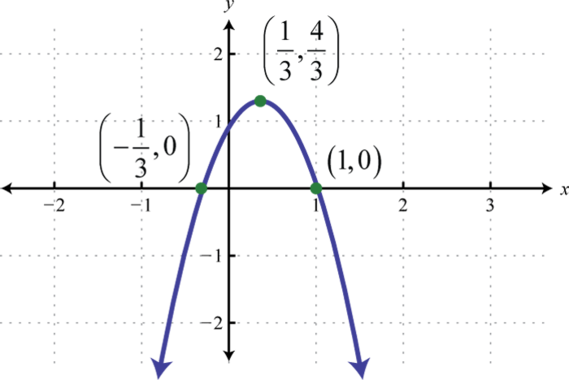
;
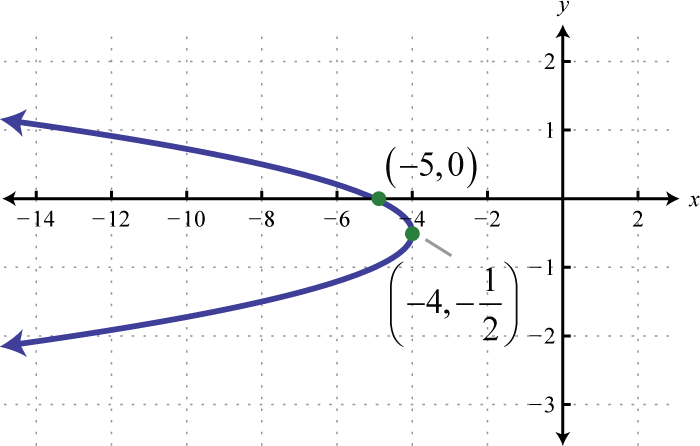
;
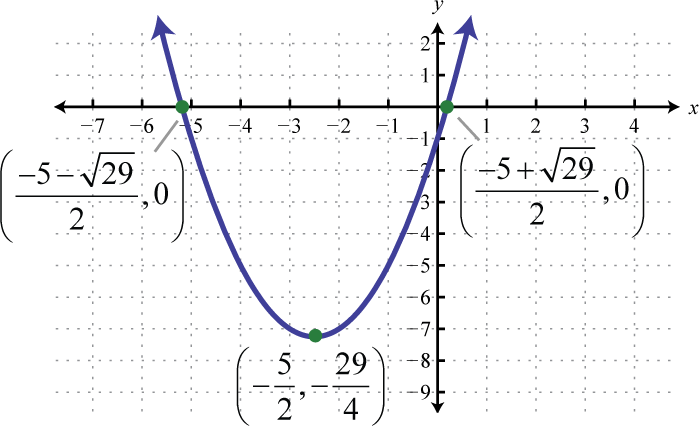
;

Answer may vary
Answer may vary
A circleA circle is the set of points in a plane that lie a fixed distance from a given point, called the center. is the set of points in a plane that lie a fixed distance, called the radiusThe fixed distance from the center of a circle to any point on the circle., from any point, called the center. The diameterThe length of a line segment passing through the center of a circle whose endpoints are on the circle. is the length of a line segment passing through the center whose endpoints are on the circle. In addition, a circle can be formed by the intersection of a cone and a plane that is perpendicular to the axis of the cone:

In a rectangular coordinate plane, where the center of a circle with radius r is , we have

Calculate the distance between and using the distance formula,
Squaring both sides leads us to the equation of a circle in standard formThe equation of a circle written in the form where is the center and r is the radius.,
In this form, the center and radius are apparent. For example, given the equation we have,
In this case, the center is and More examples follow:
Equation |
Center |
Radius |
|---|---|---|
The graph of a circle is completely determined by its center and radius.
Graph:
Solution:
Written in this form we can see that the center is and that the radius units. From the center mark points 4 units up and down as well as 4 units left and right.
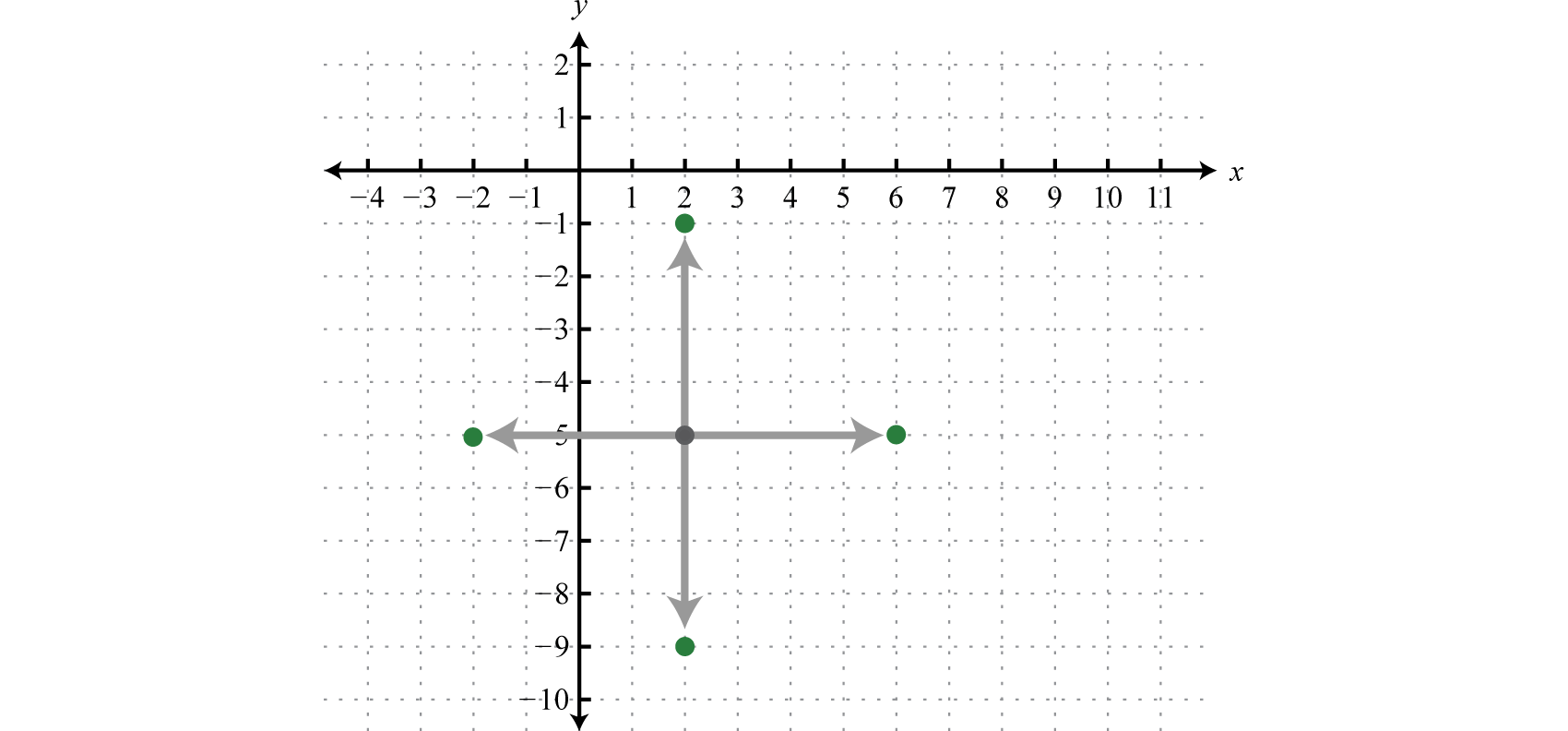
Then draw in the circle through these four points.
Answer:

As with any graph, we are interested in finding the x- and y-intercepts.
Find the intercepts:
Solution:
To find the y-intercepts set :
For this equation, we can solve by extracting square roots.
Therefore, the y-intercepts are and To find the x-intercepts set :
And because the solutions are complex we conclude that there are no real x-intercepts. Note that this does make sense given the graph.
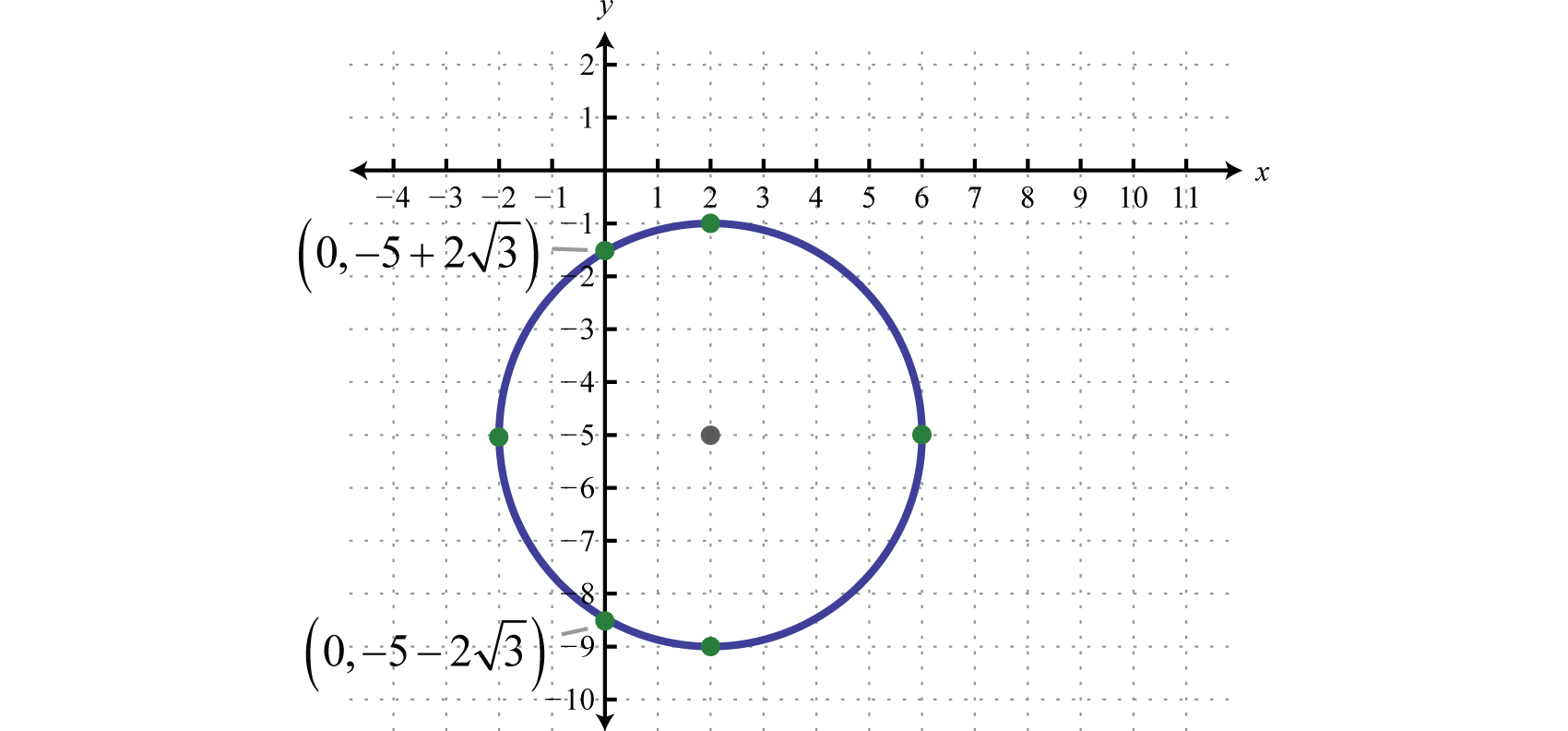
Answer: x-intercepts: none; y-intercepts: and
Given the center and radius of a circle, we can find its equation.
Graph the circle with radius units centered at Give its equation in standard form and determine the intercepts.
Solution:
Given that the center is and the radius is we sketch the graph as follows:
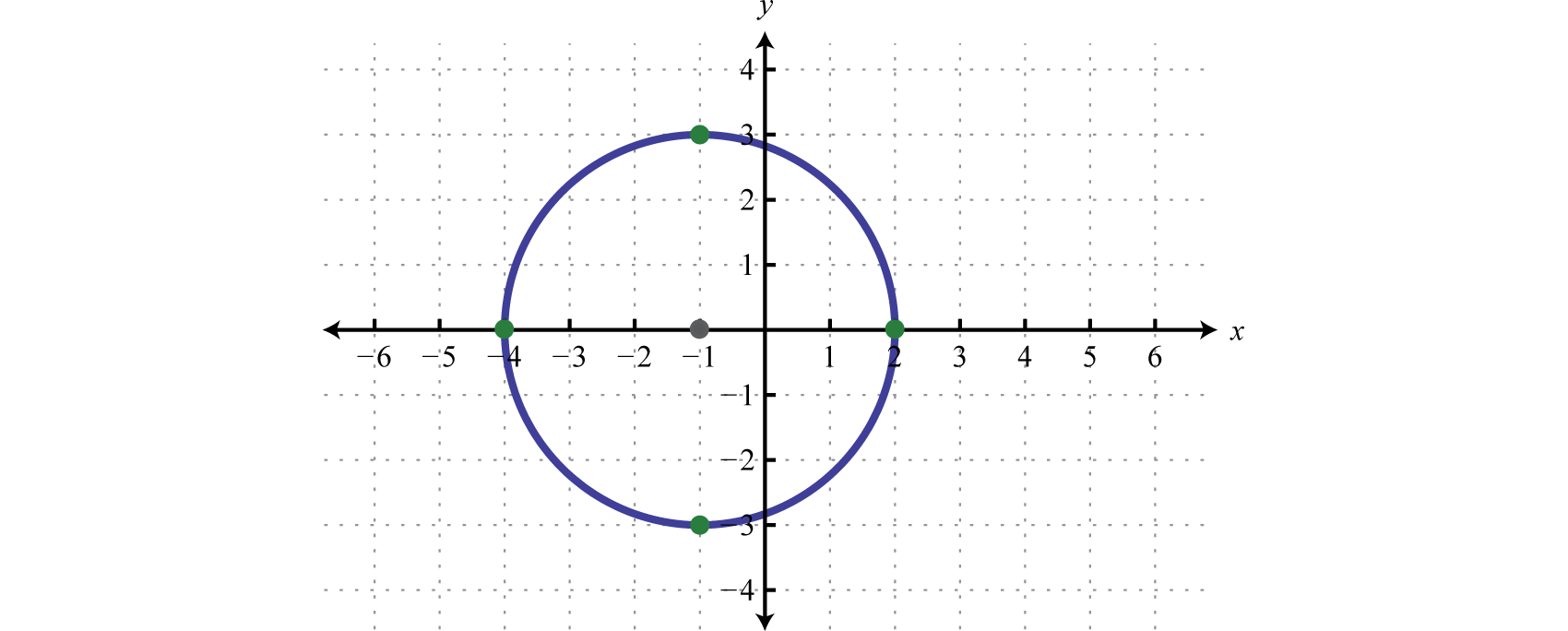
Substitute h, k, and r to find the equation in standard form. Since and we have,
The equation of the circle is , use this to determine the y-intercepts.
Therefore, the y-intercepts are and To find the x-intercepts algebraically, set and solve for x; this is left for the reader as an exercise.

Answer: Equation: ; y-intercepts: and ; x-intercepts: and
Of particular importance is the unit circleThe circle centered at the origin with radius 1; its equation is ,
Or,
In this form, it should be clear that the center is and that the radius is 1 unit. Furthermore, if we solve for y we obtain two functions:
The function defined by is the top half of the circle and the function defined by is the bottom half of the unit circle:
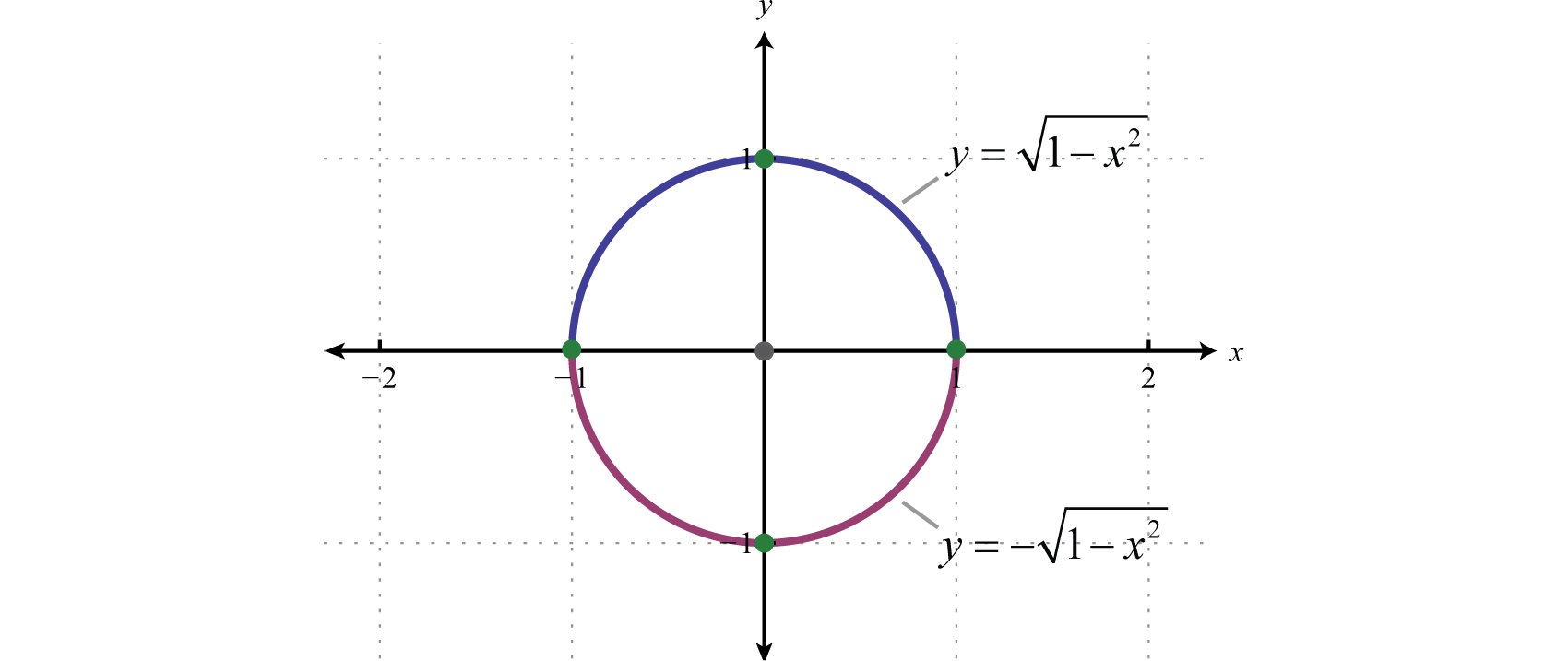
We have seen that the graph of a circle is completely determined by the center and radius which can be read from its equation in standard form. However, the equation is not always given in standard form. The equation of a circle in general formThe equation of a circle written in the form follows:
Here c, d, and e are real numbers. The steps for graphing a circle given its equation in general form follow.
Graph:
Solution:
Begin by rewriting the equation in standard form.
Step 1: Group the terms with the same variables and move the constant to the right side. In this case, subtract 13 on both sides and group the terms involving x and the terms involving y as follows.
Step 2: Complete the square for each grouping. The idea is to add the value that completes the square, , to both sides for both groupings, and then factor. For the terms involving x use and for the terms involving y use
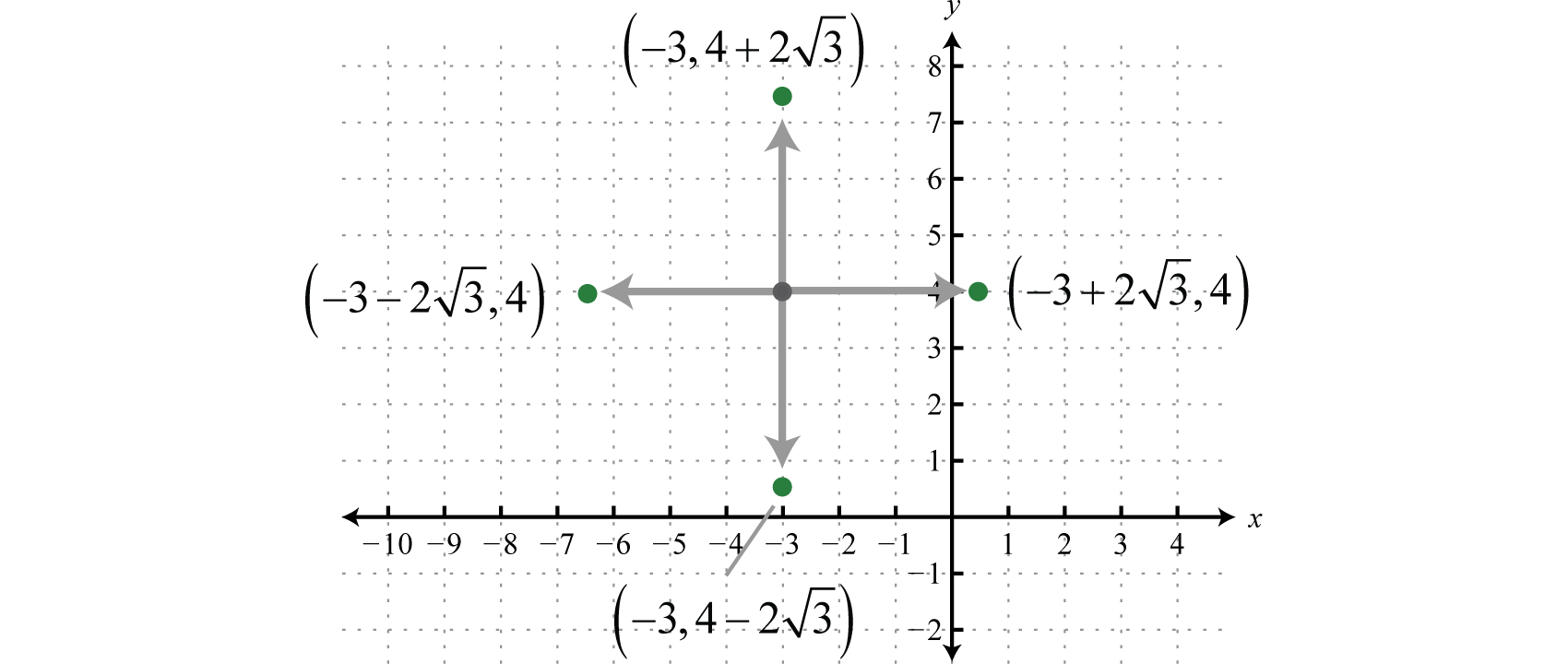
Answer:

Determine the center and radius:
Solution:
We can obtain the general form by first dividing both sides by 4.
Now that we have the general form for a circle, where both terms of degree two have a leading coefficient of 1, we can use the steps for rewriting it in standard form. Begin by adding to both sides and group variables that are the same.
Next complete the square for both groupings. Use for the first grouping and for the second grouping.
Answer: Center: ; radius:
In summary, to convert from standard form to general form we multiply, and to convert from general form to standard form we complete the square.

Determine the center and radius given the equation of a circle in standard form.
Determine the standard form for the equation of the circle given its center and radius.
Center with radius
Center with radius
Center with radius
Center with radius
Center with radius
Center with radius
Graph.
Find the x- and y-intercepts.
Find the equation of the circle.
Circle with center passing through
Circle with center passing through
Circle whose diameter is defined by and
Circle whose diameter is defined by and
Circle with center and area square units.
Circle with center and circumference square units.
Find the area of the circle with equation
Find the circumference of the circle with equation
Rewrite in standard form and graph.
Given a circle in general form, determine the intercepts.
Determine the area of the circle whose equation is
Determine the area of the circle whose equation is
Determine the circumference of a circle whose equation is
Determine the circumference of a circle whose equation is
Find general form of the equation of a circle centered at passing through
Find general form of the equation of a circle centered at passing through
Given the graph of a circle, determine its equation in general form.

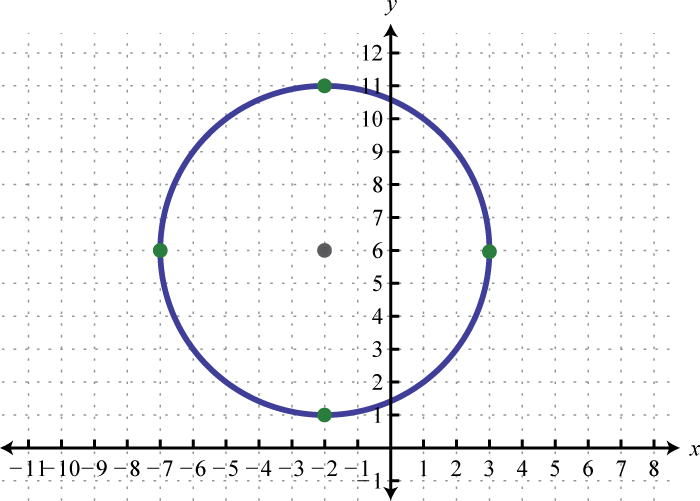
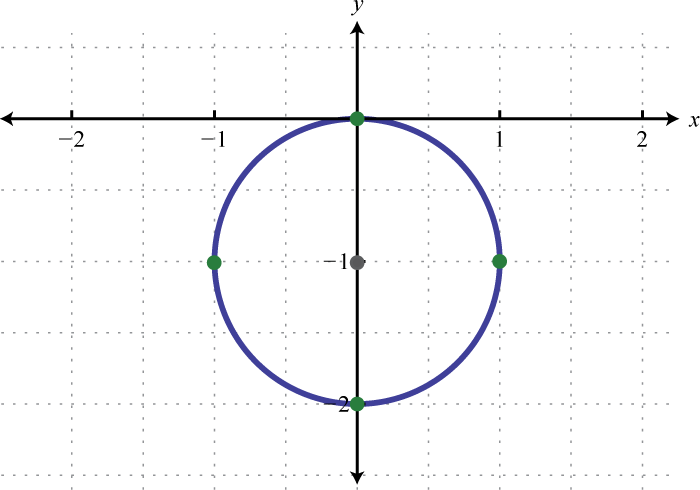
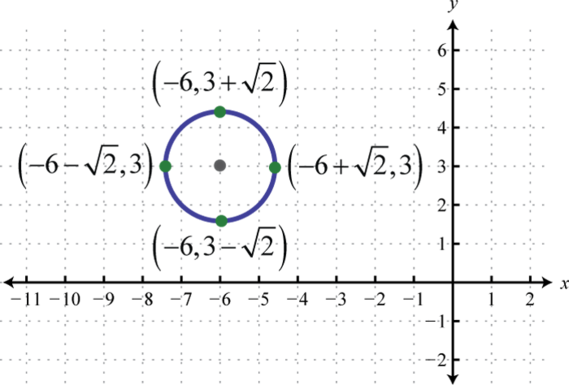
Is the center of a circle part of the graph? Explain.
Make up your own circle, write it in general form, and graph it.
Explain how we can tell the difference between the equation of a parabola in general form and the equation of a circle in general form. Give an example.
Do all circles have intercepts? What are the possible numbers of intercepts? Illustrate your explanation with graphs.
Center: ; radius:
Center: ; radius:
Center: ; radius:
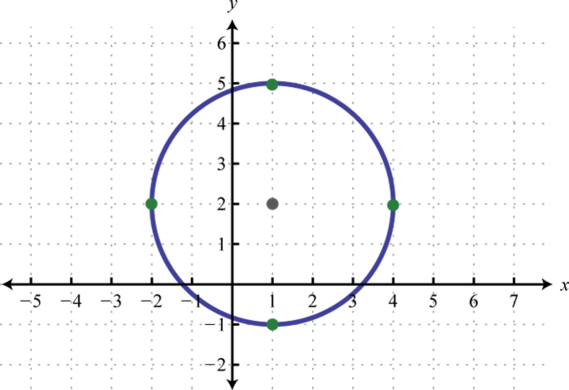




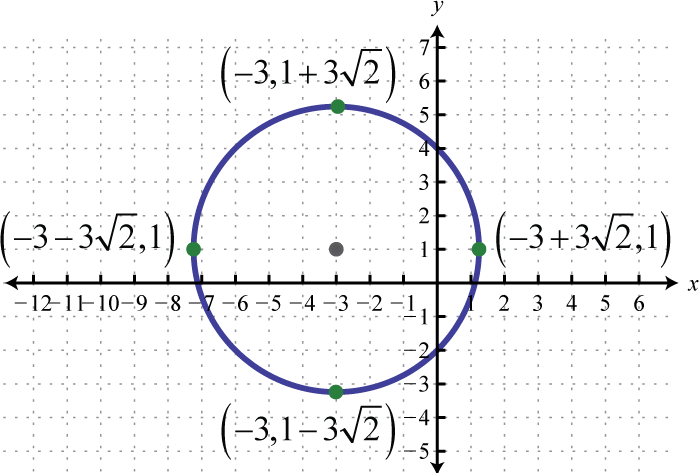
x-intercepts: ; y-intercepts:
x-intercepts: none; y-intercepts: ,
x-intercepts: ; y-intercepts:
x-intercepts: none; y-intercepts: none
square units
;
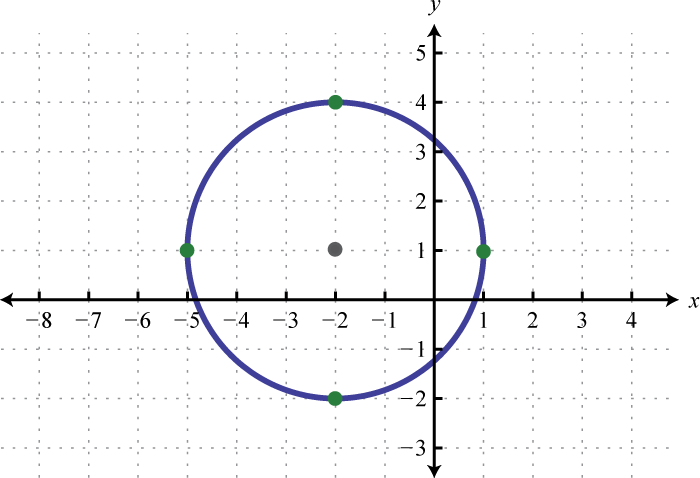
;
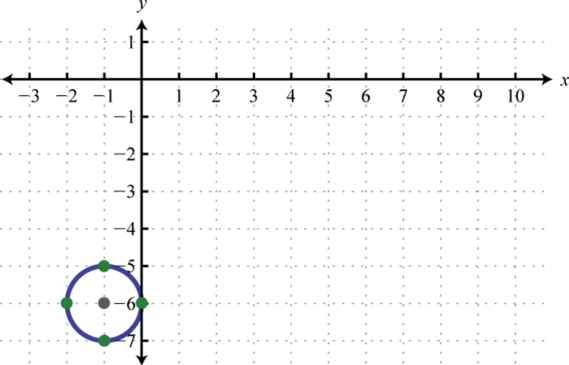
;

;

;
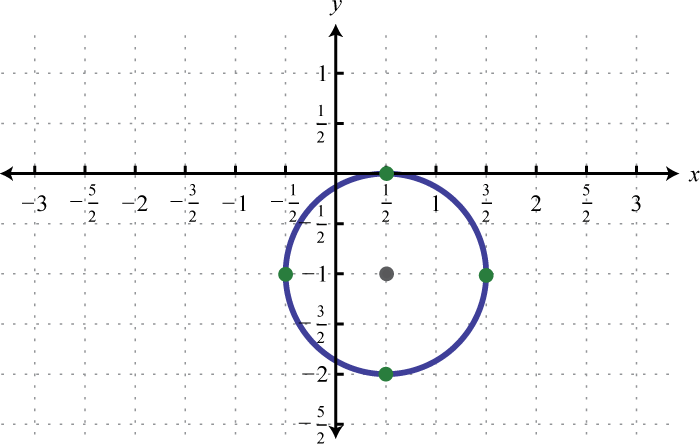
;
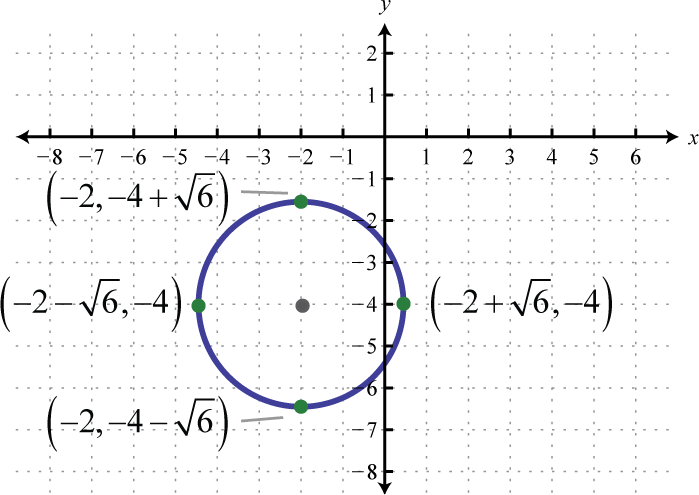
;

;

;
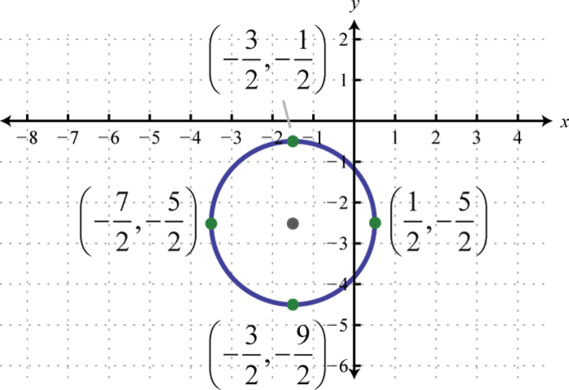
x-intercepts: , ; y-intercepts: none
x-intercepts: ; y-intercepts: ,
x-intercepts: , ; y-intercepts:
square units
units
Answer may vary
Answer may vary
An ellipseThe set of points in a plane whose distances from two fixed points have a sum that is equal to a positive constant. is the set of points in a plane whose distances from two fixed points, called foci, have a sum that is equal to a positive constant. In other words, if points and are the foci (plural of focus) and is some given positive constant then is a point on the ellipse if as pictured below:

In addition, an ellipse can be formed by the intersection of a cone with an oblique plane that is not parallel to the side of the cone and does not intersect the base of the cone. Points on this oval shape where the distance between them is at a maximum are called verticesPoints on the ellipse that mark the endpoints of the major axis. and define the major axisThe line segment through the center of an ellipse defined by two points on the ellipse where the distance between them is a maximum.. The center of an ellipse is the midpoint between the vertices. The minor axisThe line segment through the center of an ellipse defined by two points on the ellipse where the distance between them is a minimum. is the line segment through the center of an ellipse defined by two points on the ellipse where the distance between them is at a minimum. The endpoints of the minor axis are called co-verticesPoints on the ellipse that mark the endpoints of the minor axis..
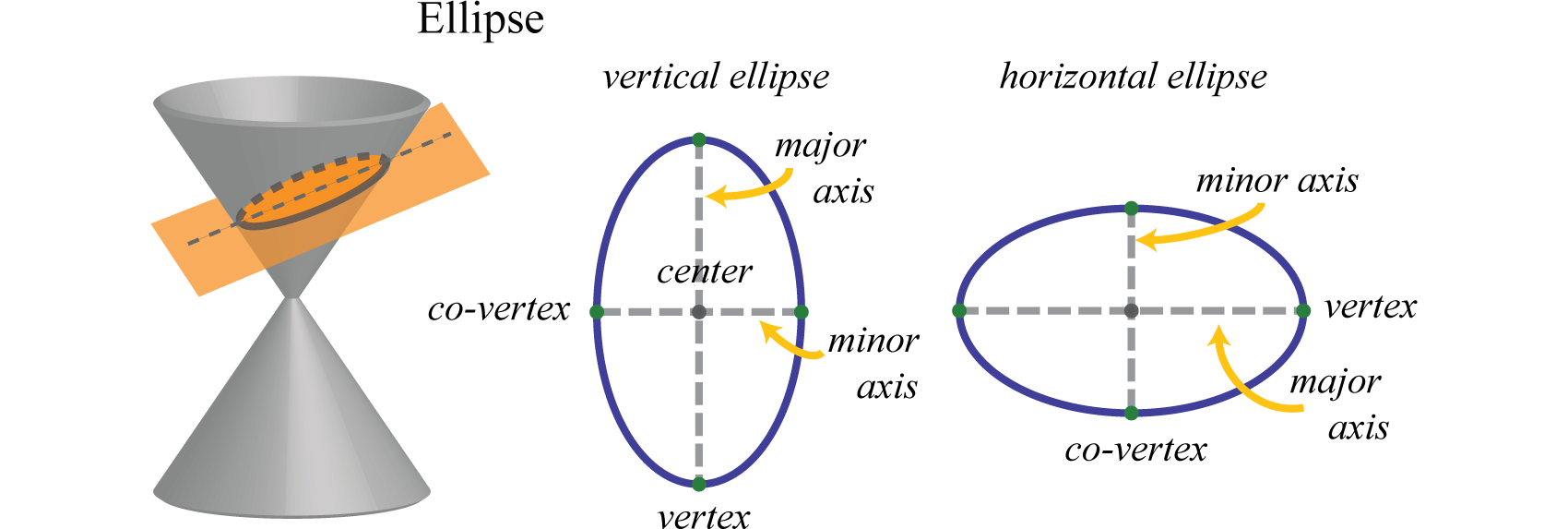
If the major axis of an ellipse is parallel to the x-axis in a rectangular coordinate plane, we say that the ellipse is horizontal. If the major axis is parallel to the y-axis, we say that the ellipse is vertical. In this section, we are only concerned with sketching these two types of ellipses. However, the ellipse has many real-world applications and further research on this rich subject is encouraged. In a rectangular coordinate plane, where the center of a horizontal ellipse is , we have

As pictured where a, one-half of the length of the major axis, is called the major radiusOne-half of the length of the major axis.. And b, one-half of the length of the minor axis, is called the minor radiusOne-half of the length of the minor axis.. The equation of an ellipse in standard formThe equation of an ellipse written in the form The center is and the larger of a and b is the major radius and the smaller is the minor radius. follows:
The vertices are and and the orientation depends on a and b. If , then the ellipse is horizontal as shown above and if , then the ellipse is vertical and b becomes the major radius. What do you think happens when ?
Equation |
Center |
a |
b |
Orientation |
|---|---|---|---|---|
Vertical |
||||
Vertical |
||||
Vertical |
||||
Horizontal |
The graph of an ellipse is completely determined by its center, orientation, major radius, and minor radius, all of which can be determined from its equation written in standard from.
Graph:
Solution:
Written in this form we can see that the center of the ellipse is , , and From the center mark points 2 units to the left and right and 5 units up and down.
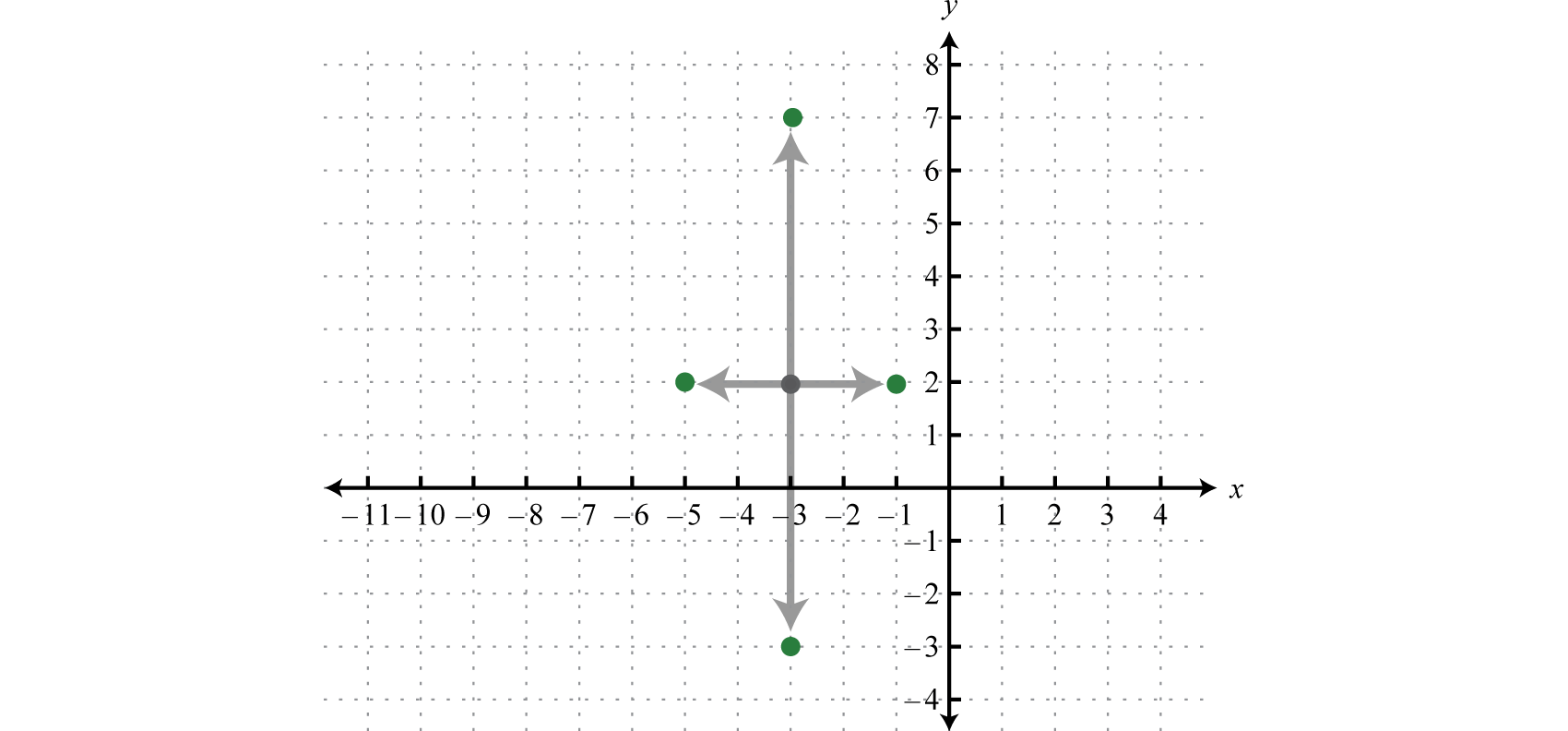
Then draw an ellipse through these four points.
Answer:
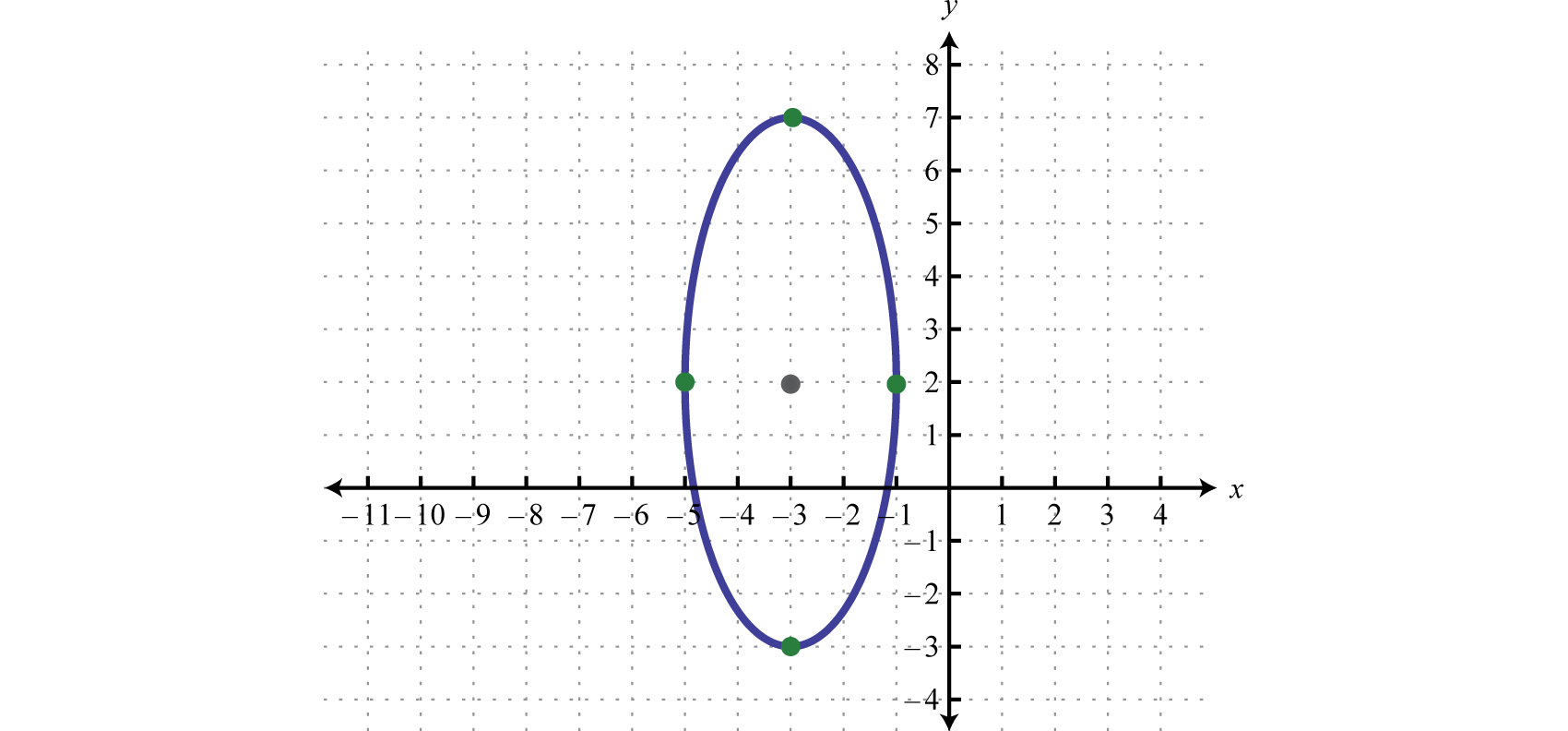
As with any graph, we are interested in finding the x- and y-intercepts.
Find the intercepts:
Solution:
To find the x-intercepts set :
At this point we extract the root by applying the square root property.
Setting and solving for y leads to complex solutions, therefore, there are no y-intercepts. This is left as an exercise.
Answer: x-intercepts: ; y-intercepts: none.
Unlike a circle, standard form for an ellipse requires a 1 on one side of its equation.
Graph and label the intercepts:
Solution:
To obtain standard form, with 1 on the right side, divide both sides by 9.
Therefore, the center of the ellipse is , , and The graph follows:

To find the intercepts we can use the standard form :
x-intercepts set |
y-intercepts set |
|---|---|
Therefore the x-intercept is and the y-intercepts are and
Answer:
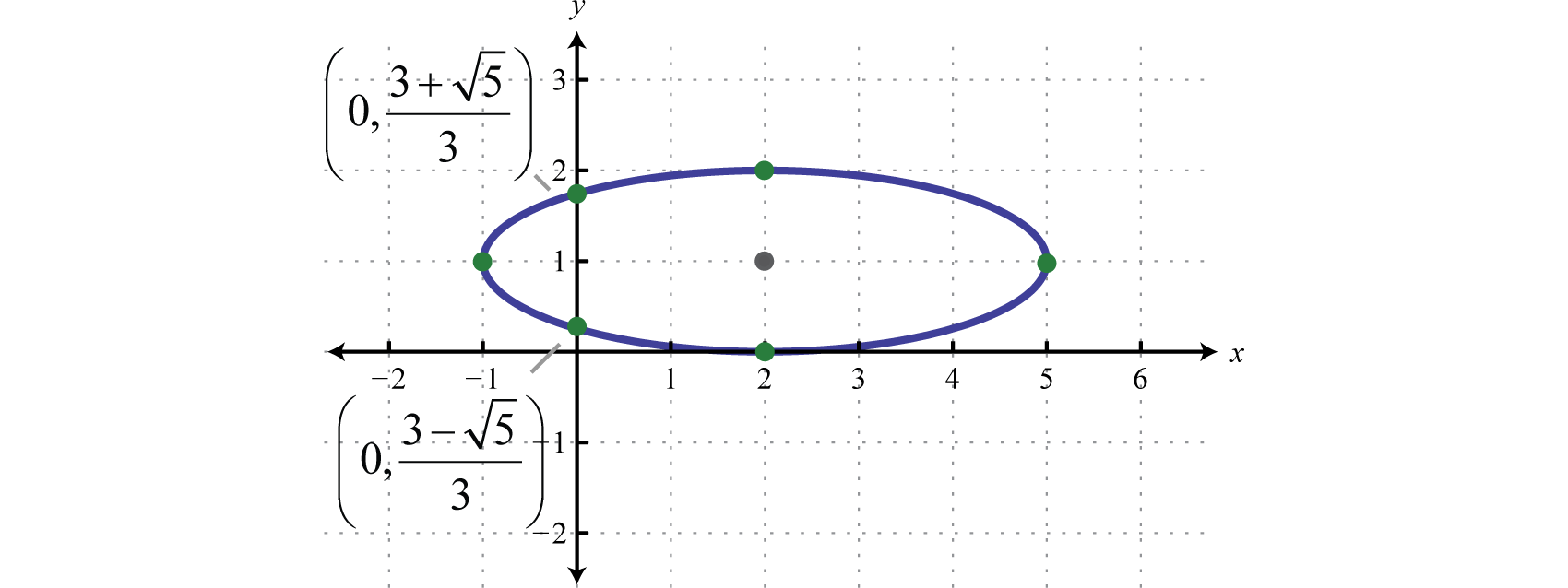
Consider the ellipse centered at the origin,
Given this equation we can write,
In this form, it is clear that the center is , , and Furthermore, if we solve for y we obtain two functions:
The function defined by is the top half of the ellipse and the function defined by is the bottom half.
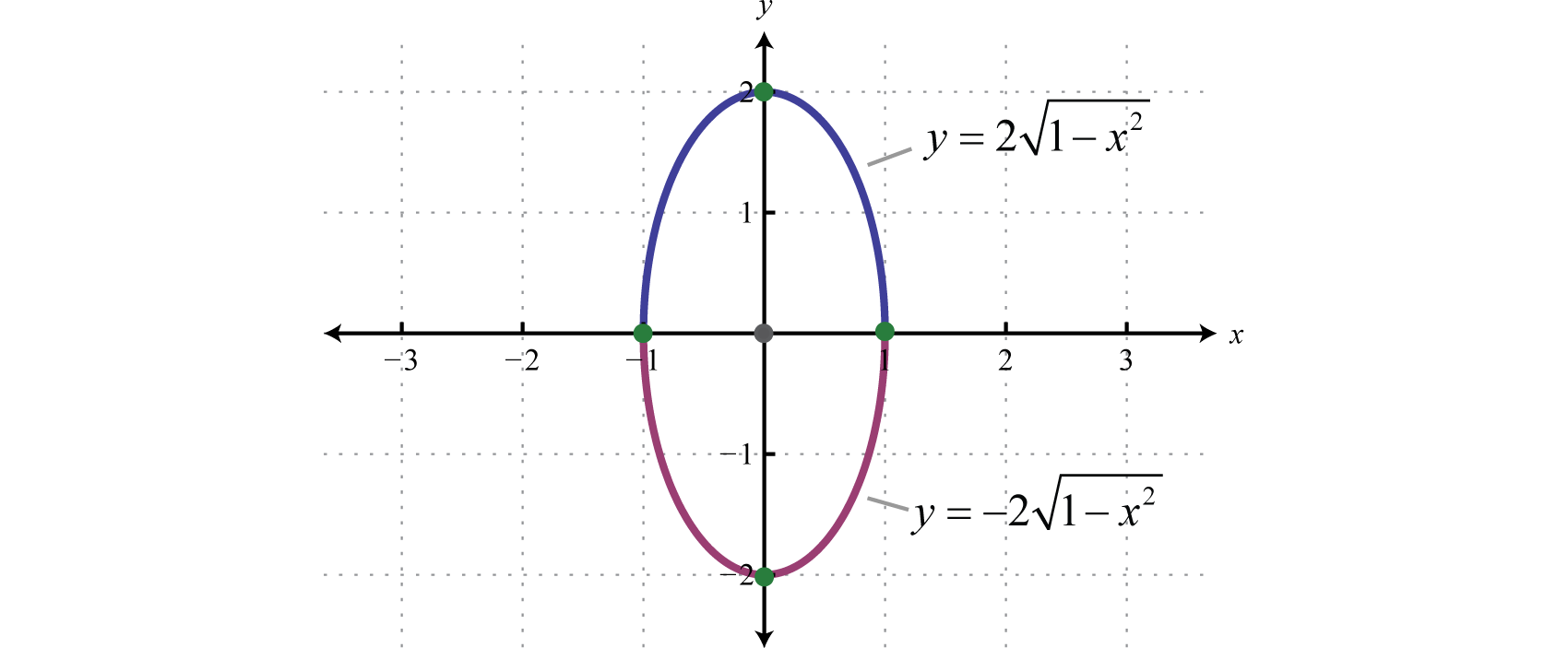
We have seen that the graph of an ellipse is completely determined by its center, orientation, major radius, and minor radius; which can be read from its equation in standard form. However, the equation is not always given in standard form. The equation of an ellipse in general formThe equation of an ellipse written in the form where follows,
where The steps for graphing an ellipse given its equation in general form are outlined in the following example.
Graph:
Solution:
Begin by rewriting the equation in standard form.
Step 1: Group the terms with the same variables and move the constant to the right side. Factor so that the leading coefficient of each grouping is 1.
Step 2: Complete the square for each grouping. In this case, for the terms involving x use and for the terms involving y use The factor in front of the grouping affects the value used to balance the equation on the right side:
Because of the distributive property, adding 16 inside of the first grouping is equivalent to adding Similarly, adding 25 inside of the second grouping is equivalent to adding Now factor and then divide to obtain 1 on the right side.
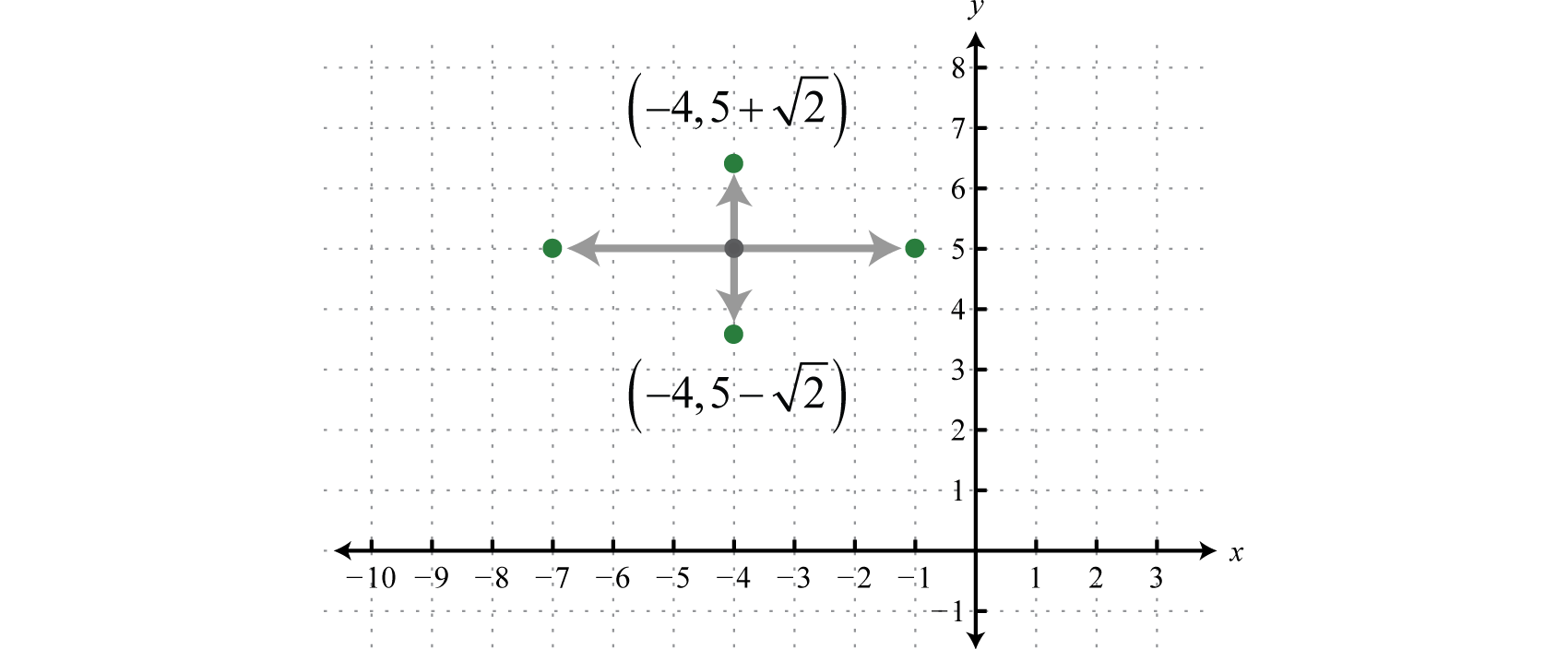
Answer:
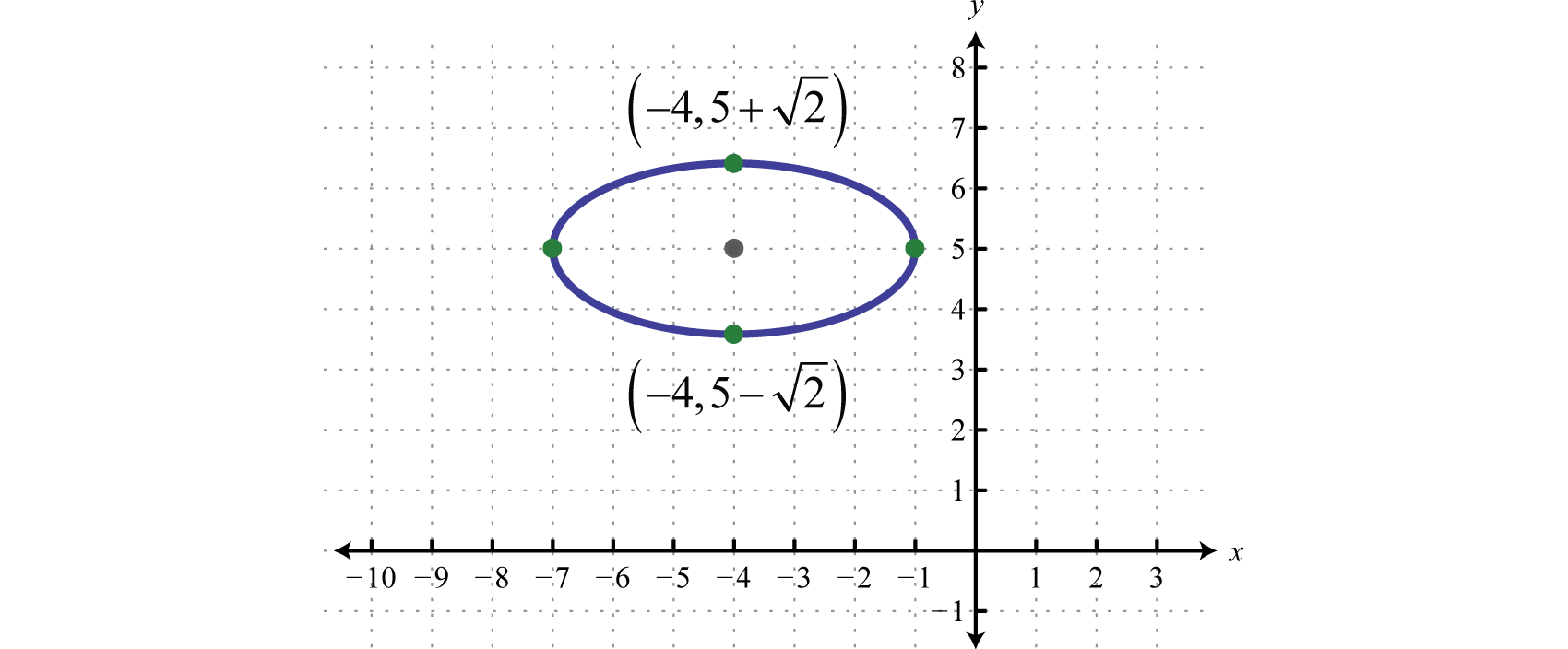
Determine the center of the ellipse as well as the lengths of the major and minor axes:
Solution:
In this example, we only need to complete the square for the terms involving x.
Use for the first grouping to be balanced by on the right side.
Here, the center is , , and Because b is larger than a, the length of the major axis is 2b and the length of the minor axis is 2a.
Answer: Center: ; major axis: units; minor axis: units.
Given the equation of an ellipse in standard form, determine its center, orientation, major radius, and minor radius.
Determine the standard form for the equation of an ellipse given the following information.
Center with and
Center with and
Center with and
Center with and
Center with and
Center with and
Graph.
Find the x- and y-intercepts.
Find the equation of the ellipse.
Ellipse with vertices and
Ellipse whose major axis has vertices and and minor axis has vertices and
Ellipse whose major axis has vertices and and minor axis has a length of 4 units.
Ellipse whose major axis has vertices and and minor axis has a length of 2 units.
Rewrite in standard form and graph.
Given general form determine the intercepts.
Determine the area of the ellipse. (The area of an ellipse is given by the formula , where a and b are the lengths of the major radius and the minor radius.)
Given the graph of an ellipse, determine its equation in general form.
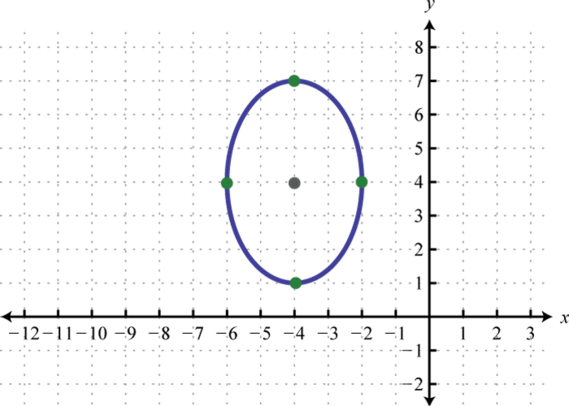
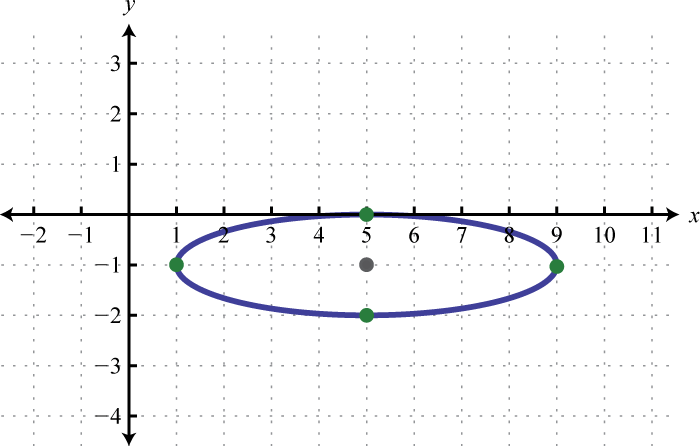
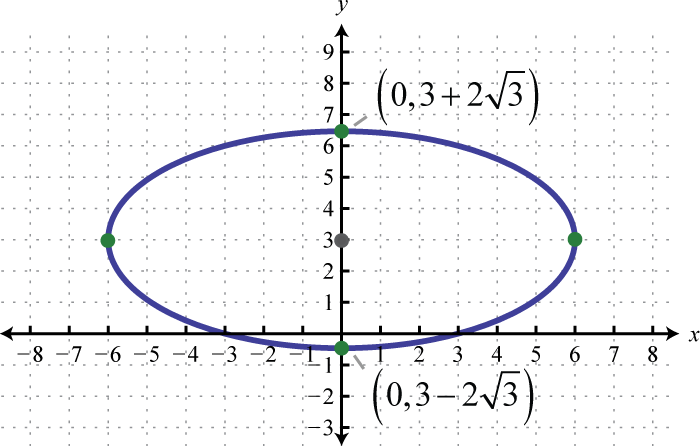
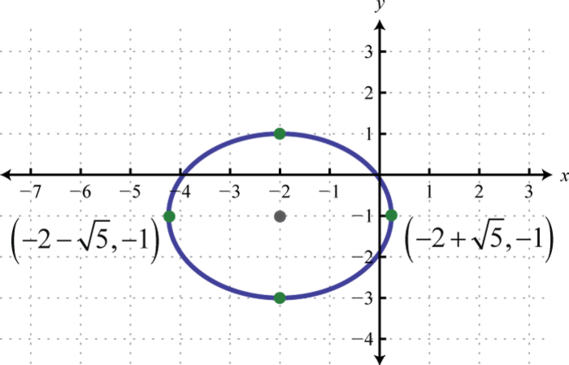
Explain why a circle can be thought of as a very special ellipse.
Make up your own equation of an ellipse, write it in general form and graph it.
Do all ellipses have intercepts? What are the possible numbers of intercepts for an ellipse? Explain.
Research and discuss real-world examples of ellipses.
Center: ; orientation: vertical; major radius: 7 units; minor radius: 2 units; ;
Center: ; orientation: horizontal; major radius: units; minor radius: 1 unit; ;
Center: ; orientation: horizontal; major radius: 3 units; minor radius: 2 units; ;
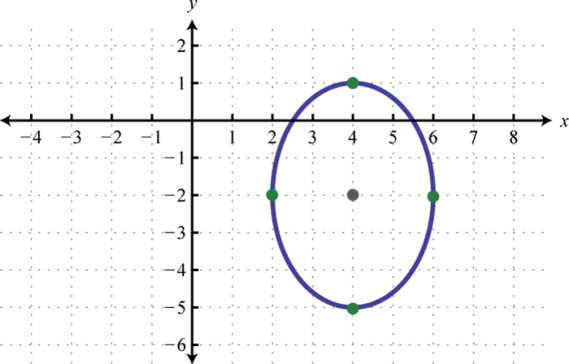
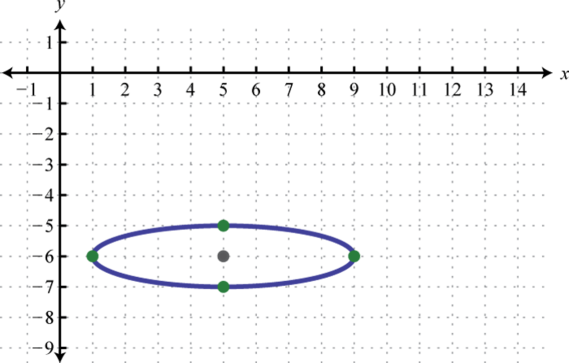
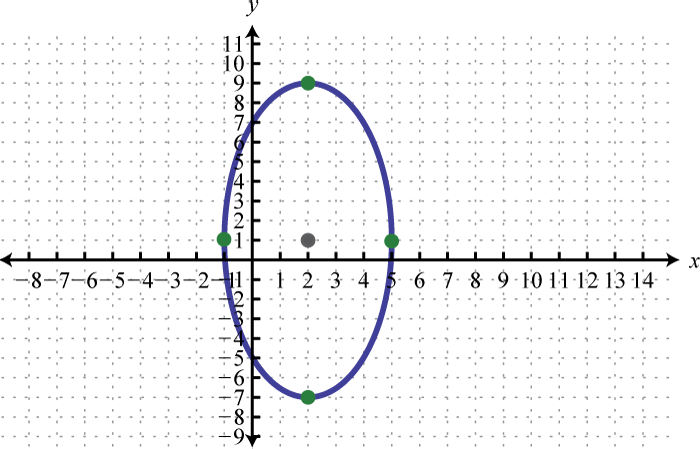

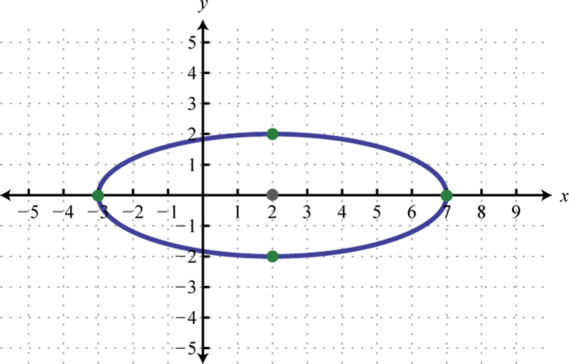

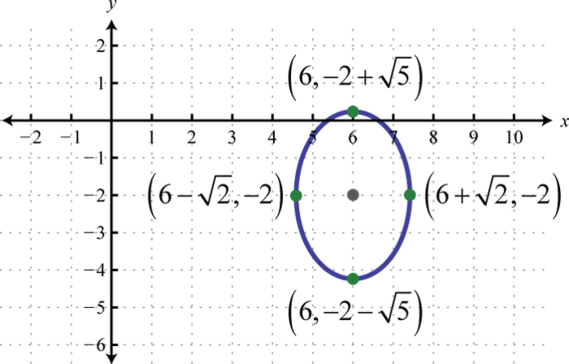
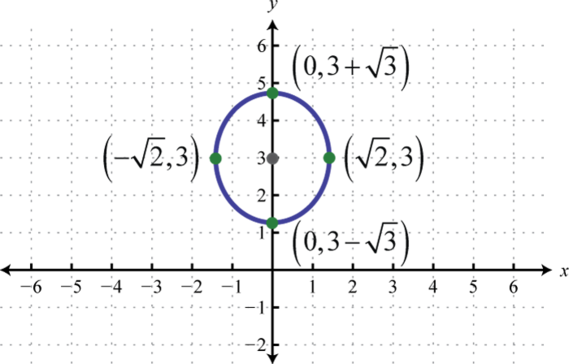
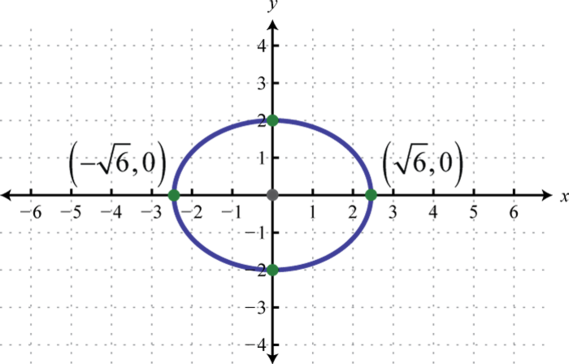
x-intercepts: ; y-intercepts: none
x-intercepts: ; y-intercepts:
x-intercepts: none; y-intercepts:
x-intercepts: ; y-intercepts:
;
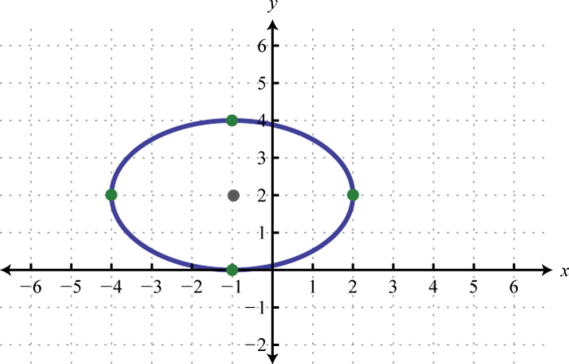
;
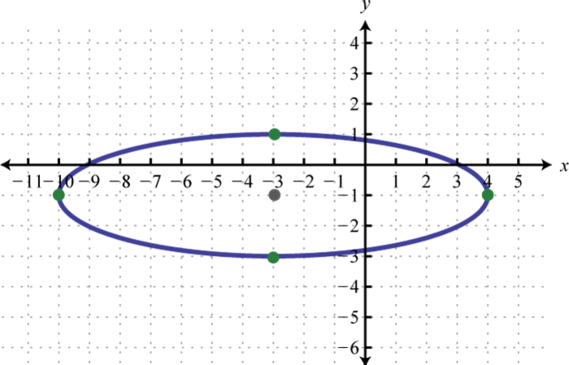
;
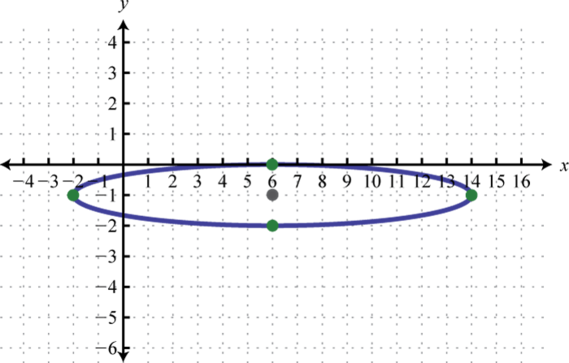
;
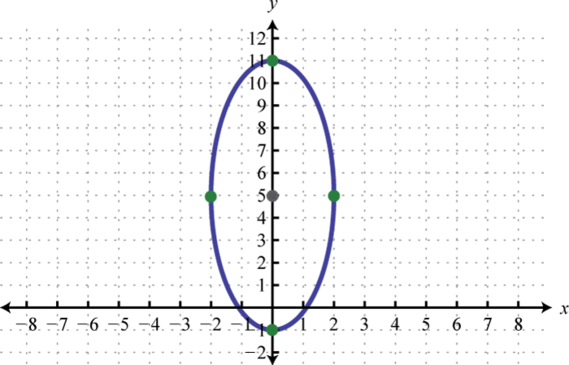
;

;
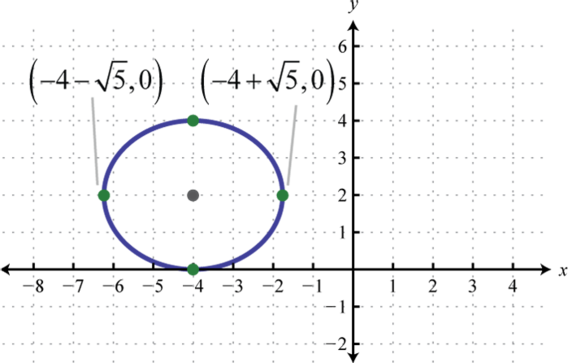
;
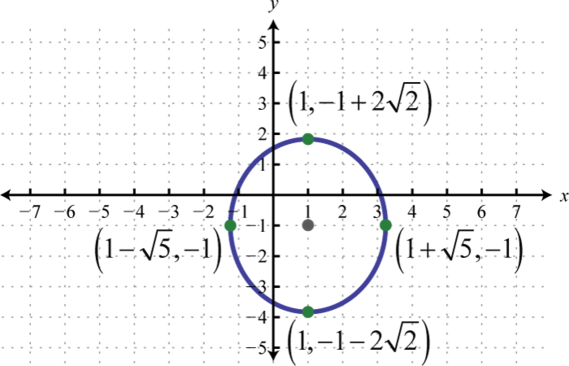
;
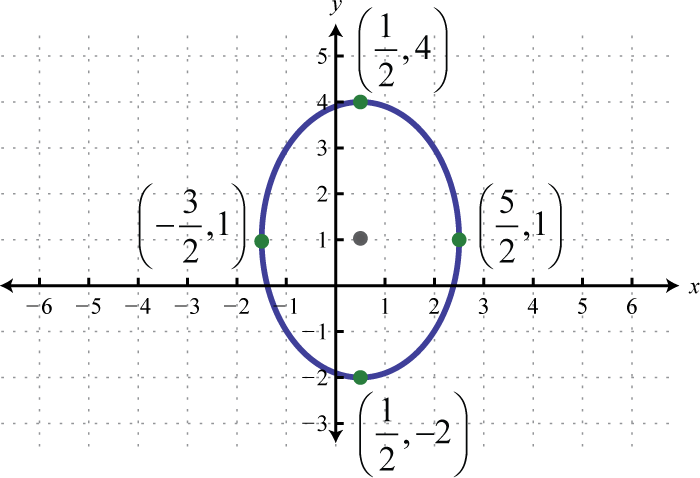
;
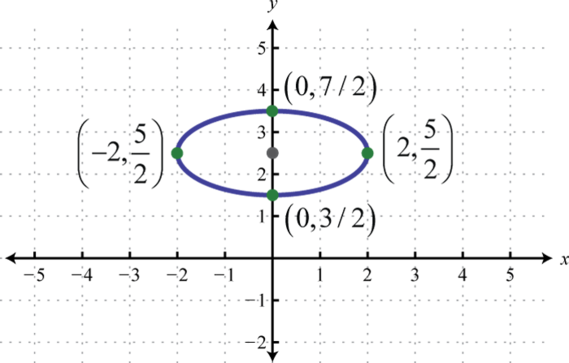
x-intercepts: none; y-intercepts:
x-intercepts: ; y-intercepts:
x-intercepts: ; y-intercepts: none
square units
square units
Answer may vary
Answer may vary
A hyperbolaThe set of points in a plane whose distances from two fixed points, called foci, has an absolute difference that is equal to a positive constant. is the set of points in a plane whose distances from two fixed points, called foci, has an absolute difference that is equal to a positive constant. In other words, if points and are the foci and is some given positive constant then is a point on the hyperbola if as pictured below:

In addition, a hyperbola is formed by the intersection of a cone with an oblique plane that intersects the base. It consists of two separate curves, called branchesThe two separate curves of a hyperbola.. Points on the separate branches of the graph where the distance is at a minimum are called vertices.Points on the separate branches of a hyperbola where the distance is a minimum. The midpoint between a hyperbola’s vertices is its center. Unlike a parabola, a hyperbola is asymptotic to certain lines drawn through the center. In this section, we will focus on graphing hyperbolas that open left and right or upward and downward.
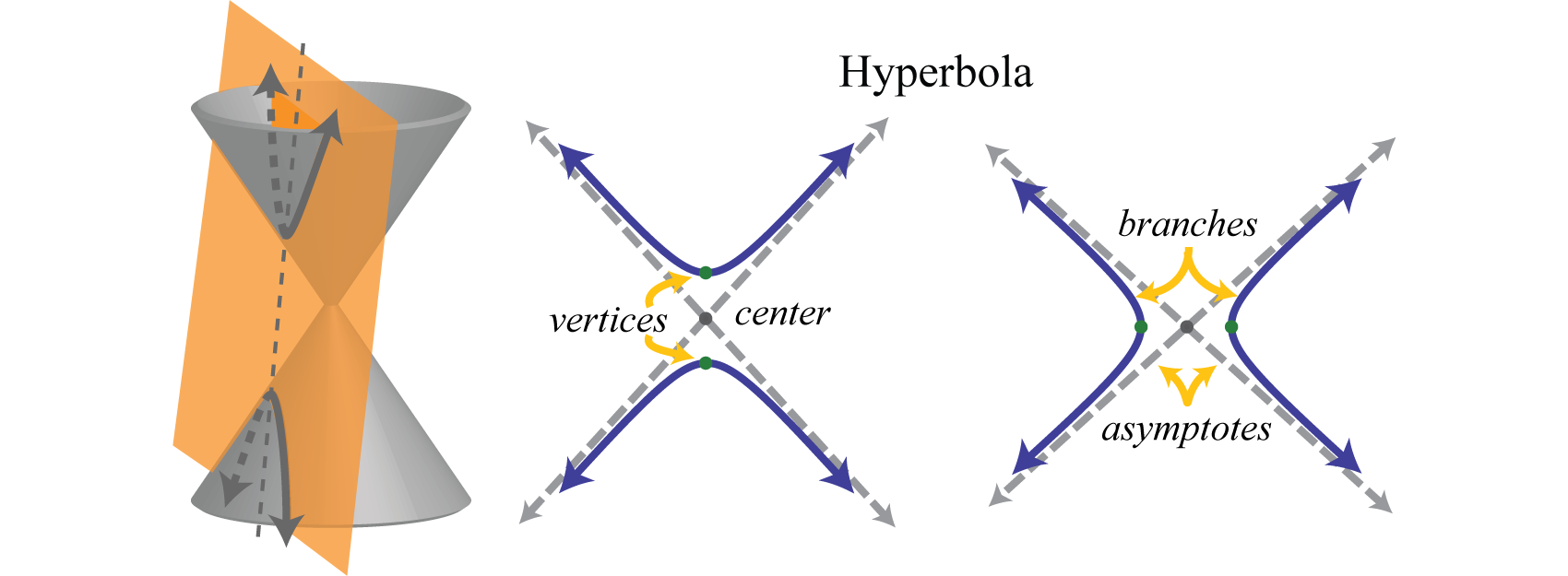
The asymptotes are drawn dashed as they are not part of the graph; they simply indicate the end behavior of the graph. The equation of a hyperbola opening left and right in standard formThe equation of a hyperbola written in the form The center is , a defines the transverse axis, and b defines the conjugate axis. follows:

Here the center is and the vertices are The equation of a hyperbola opening upward and downward in standard formThe equation of a hyperbola written in the form The center is , b defines the transverse axis, and a defines the conjugate axis. follows:
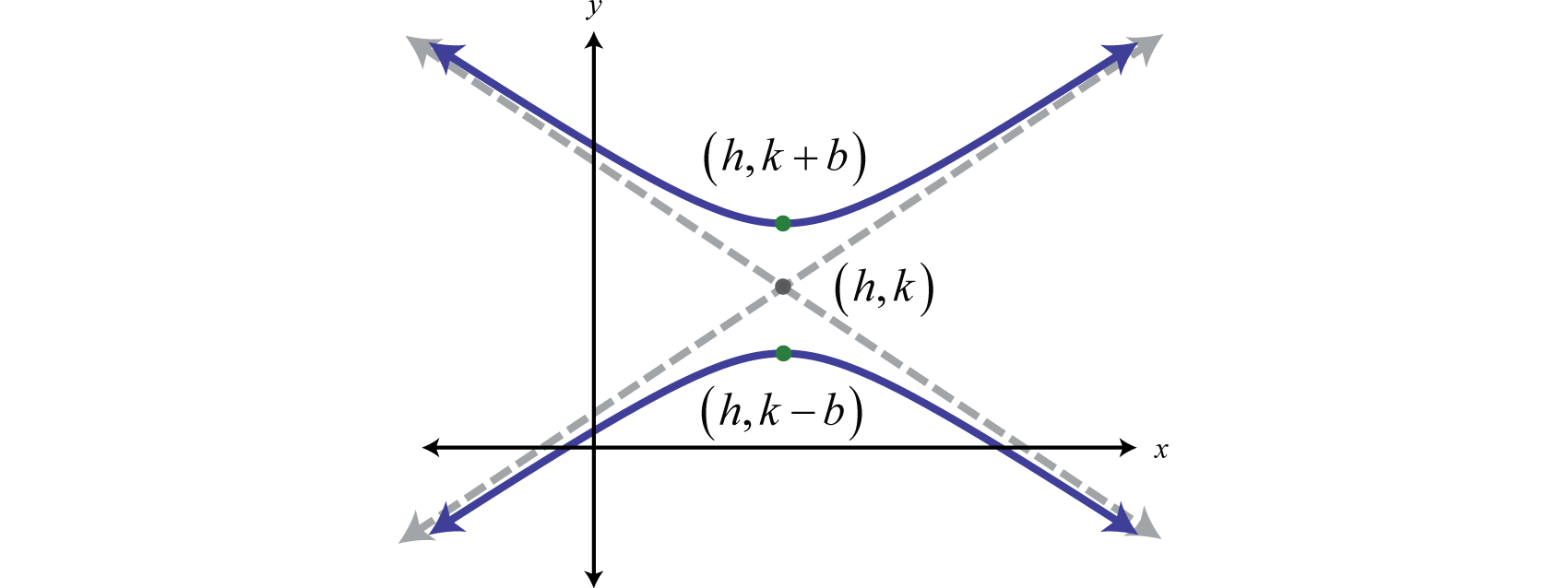
Here the center is and the vertices are
The asymptotes are essential for determining the shape of any hyperbola. Given standard form, the asymptotes are lines passing through the center with slope To easily sketch the asymptotes we make use of two special line segments through the center using a and b. Given any hyperbola, the transverse axisThe line segment formed by the vertices of a hyperbola. is the line segment formed by its vertices. The conjugate axisA line segment through the center of a hyperbola that is perpendicular to the transverse axis. is the line segment through the center perpendicular to the transverse axis as pictured below:
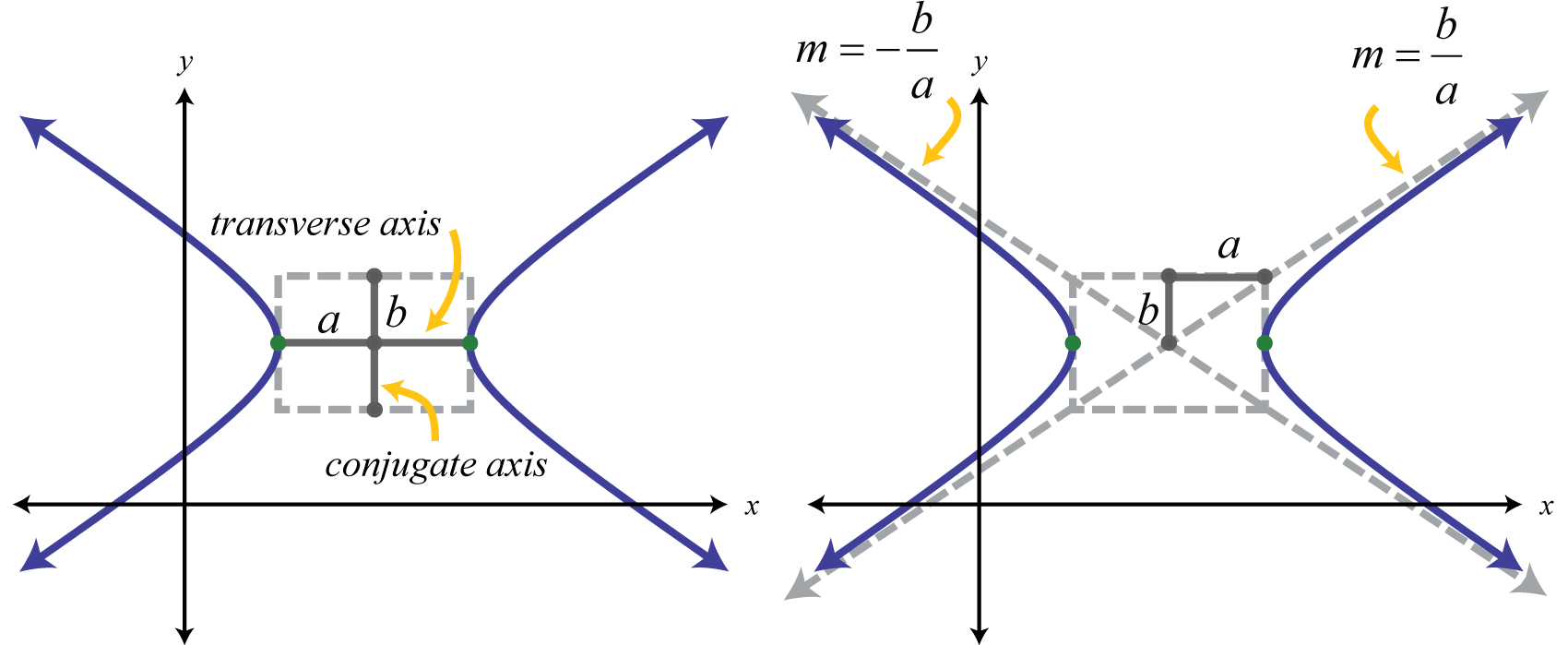
The rectangle defined by the transverse and conjugate axes is called the fundamental rectangleThe rectangle formed using the endpoints of a hyperbolas, transverse and conjugate axes.. The lines through the corners of this rectangle have slopes These lines are the asymptotes that define the shape of the hyperbola. Therefore, given standard form, many of the properties of a hyperbola are apparent.
Equation |
Center |
a |
b |
Opens |
|---|---|---|---|---|
Left and right |
||||
Upward and downward |
||||
Upward and downward |
||||
Left and right |
The graph of a hyperbola is completely determined by its center, vertices, and asymptotes.
Graph:
Solution:
In this case, the expression involving x has a positive leading coefficient; therefore, the hyperbola opens left and right. Here and From the center , mark points 3 units left and right as well as 2 units up and down. Connect these points with a rectangle as follows:
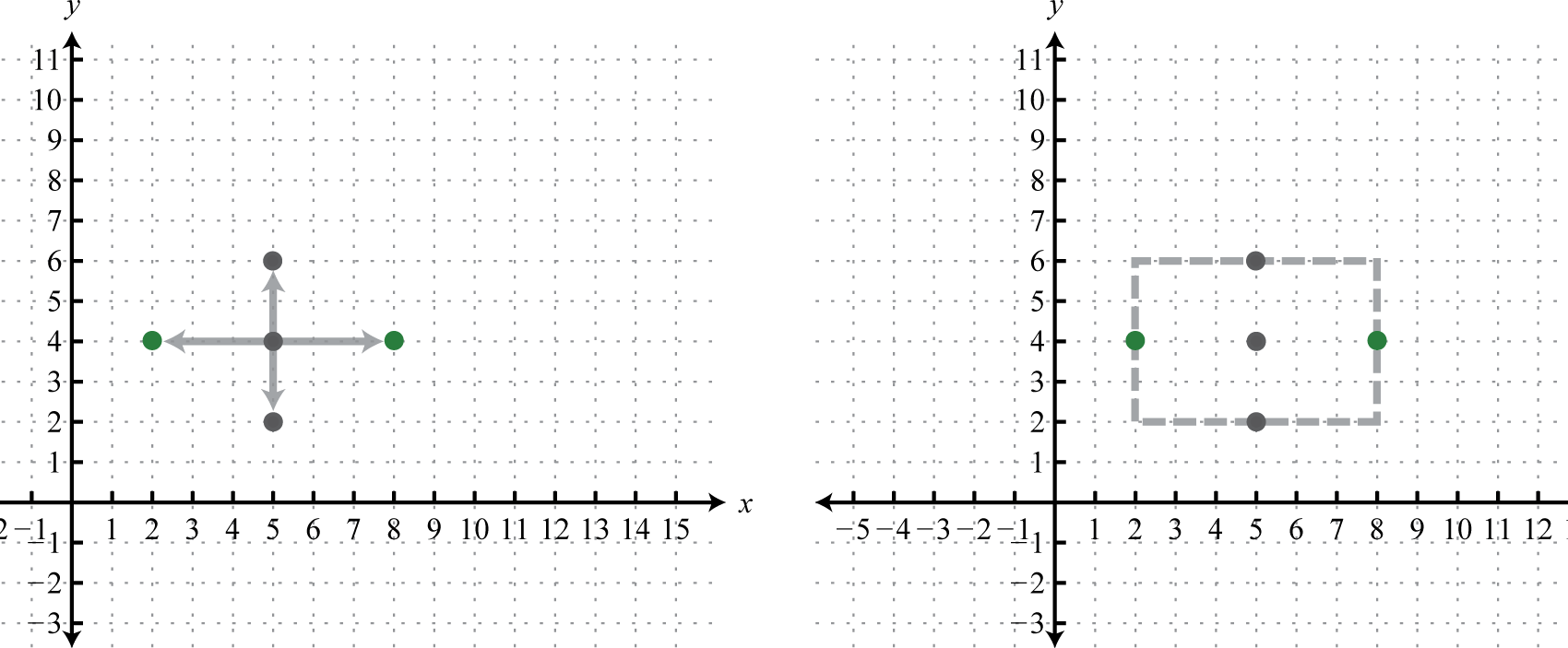
The lines through the corners of this rectangle define the asymptotes.
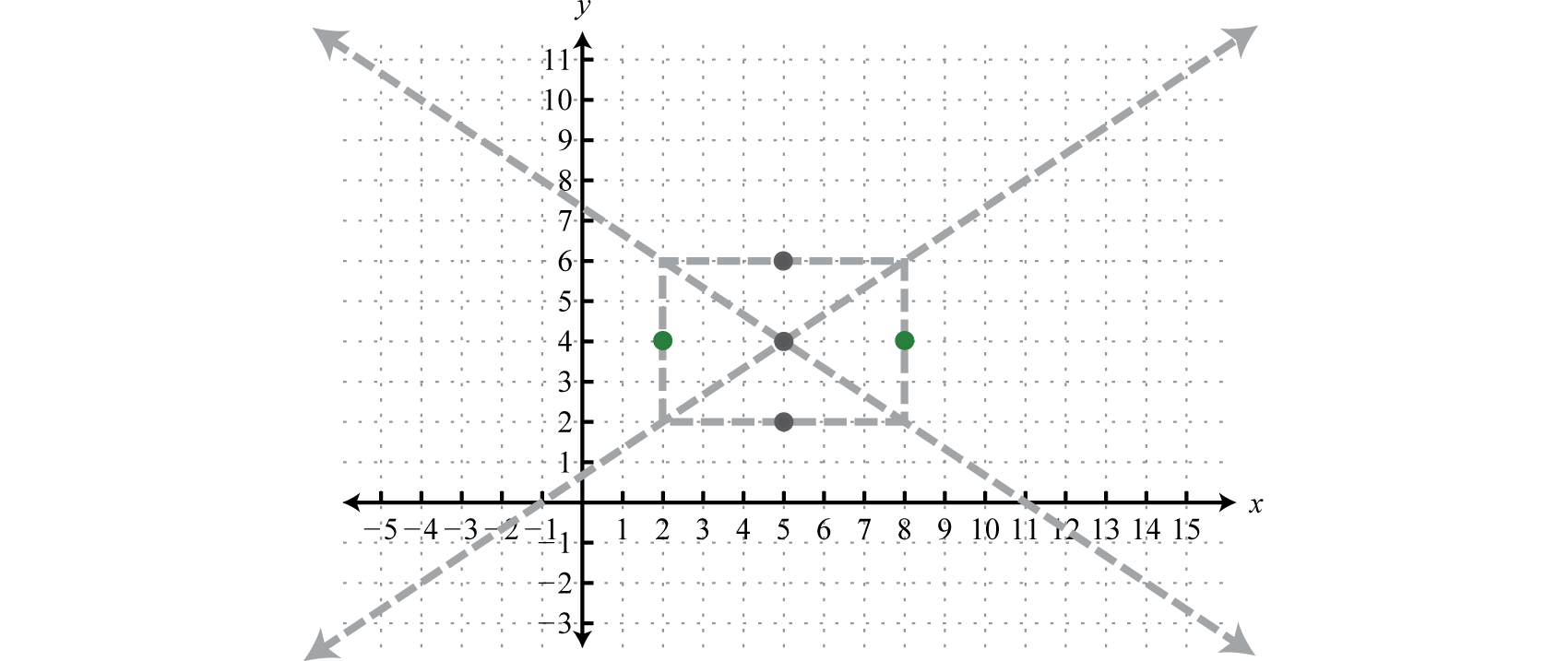
Use these dashed lines as a guide to graph the hyperbola opening left and right passing through the vertices.
Answer:
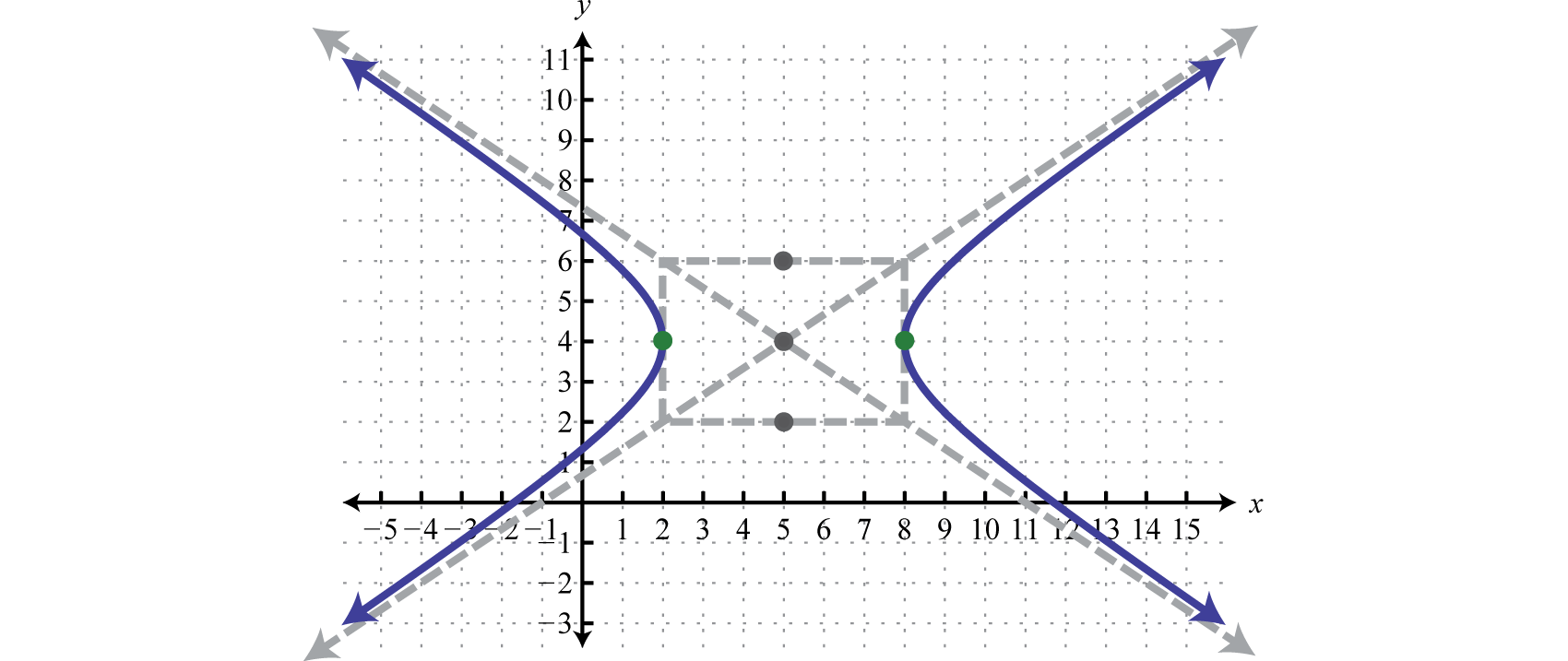
Graph:
Solution:
In this case, the expression involving y has a positive leading coefficient; therefore, the hyperbola opens upward and downward. Here and From the center mark points 6 units left and right as well as 2 units up and down. Connect these points with a rectangle. The lines through the corners of this rectangle define the asymptotes.

Use these dashed lines as a guide to graph the hyperbola opening upward and downward passing through the vertices.
Answer:
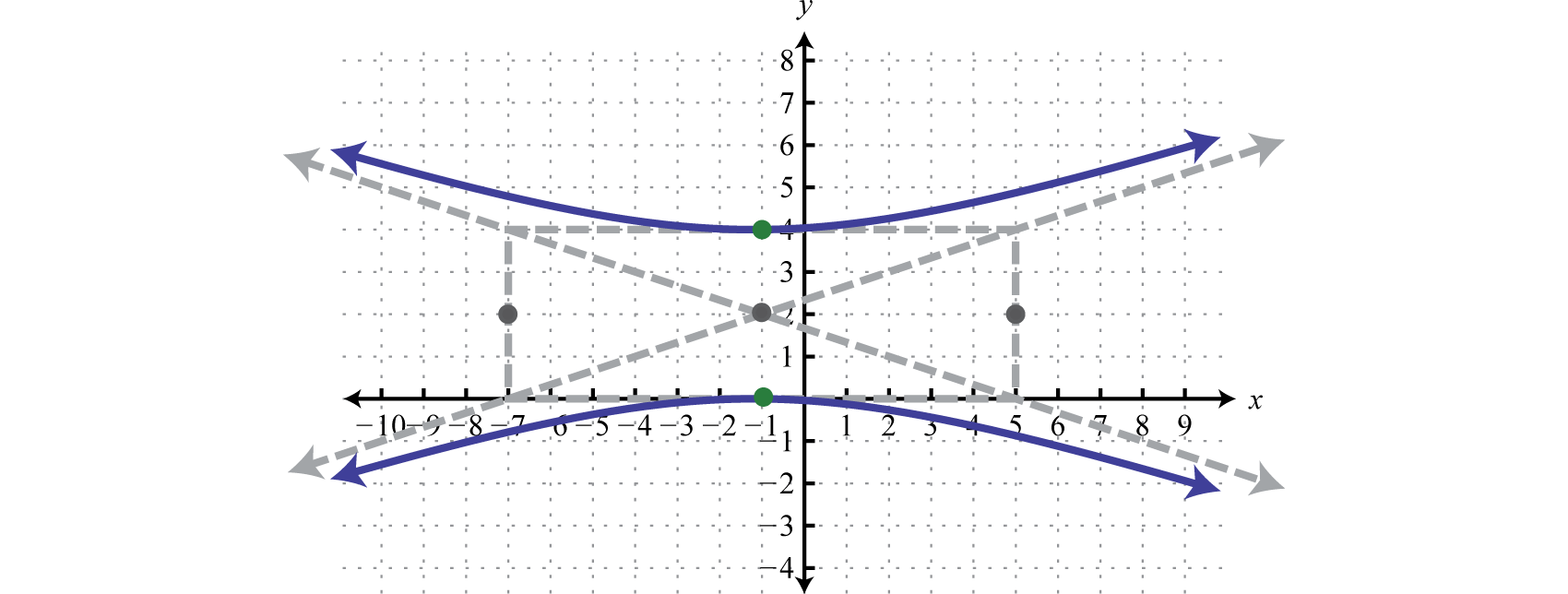
Note: When given a hyperbola opening upward and downward, as in the previous example, it is a common error to interchange the values for the center, h and k. This is the case because the quantity involving the variable y usually appears first in standard form. Take care to ensure that the y-value of the center comes from the quantity involving the variable y and that the x-value of the center is obtained from the quantity involving the variable x.
As with any graph, we are interested in finding the x- and y-intercepts.
Find the intercepts:
Solution:
To find the x-intercepts set and solve for x.
Therefore there is only one x-intercept, To find the y-intercept set and solve for y.
Therefore there are two y-intercepts, and Take a moment to compare these to the sketch of the graph in the previous example.
Answer: x-intercept: ; y-intercepts: and
Consider the hyperbola centered at the origin,
Standard form requires one side to be equal to 1. In this case, we can obtain standard form by dividing both sides by 45.
This can be written as follows:
In this form, it is clear that the center is , , and The graph follows.
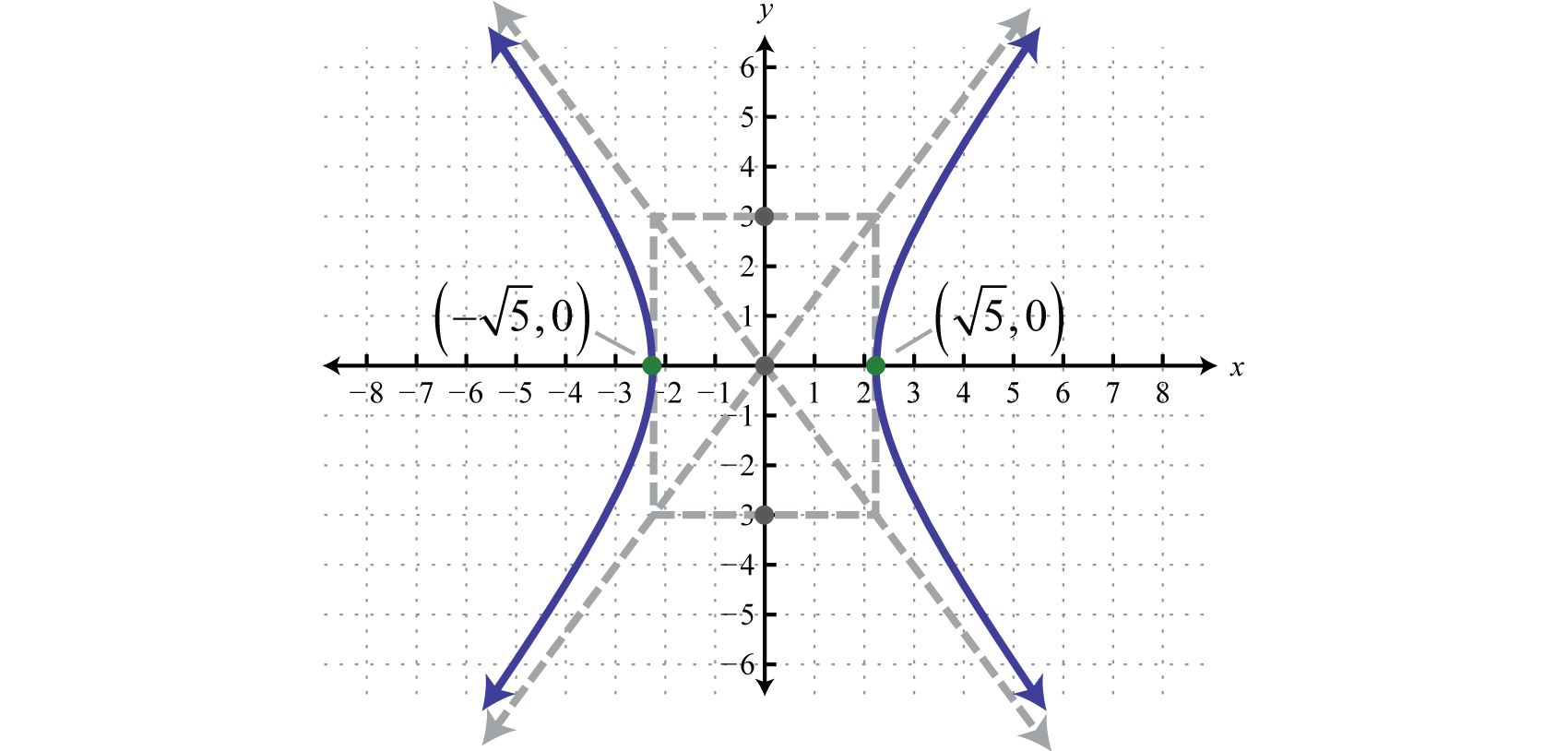
We have seen that the graph of a hyperbola is completely determined by its center, vertices, and asymptotes; which can be read from its equation in standard form. However, the equation is not always given in standard form. The equation of a hyperbola in general formThe equation of a hyperbola written in the form or where follows:
where The steps for graphing a hyperbola given its equation in general form are outlined in the following example.
Graph:
Solution:
Begin by rewriting the equation in standard form.
Step 1: Group the terms with the same variables and move the constant to the right side. Factor so that the leading coefficient of each grouping is 1.
Step 2: Complete the square for each grouping. In this case, for the terms involving x use and for the terms involving y use The factor in front of each grouping affects the value used to balance the equation on the right,
Because of the distributive property, adding 16 inside of the first grouping is equivalent to adding Similarly, adding 9 inside of the second grouping is equivalent to adding Now factor and then divide to obtain 1 on the right side.
Answer:
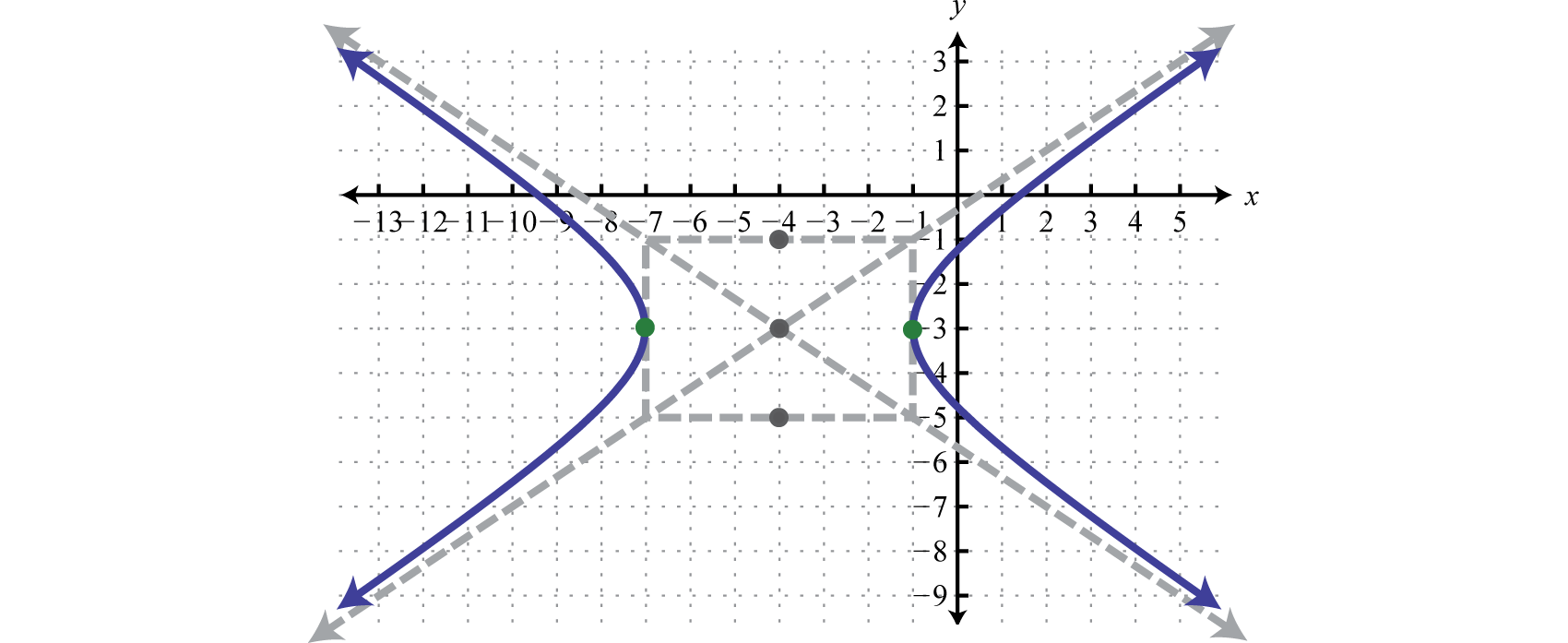
In this section, the challenge is to identify a conic section given its equation in general form. To distinguish between the conic sections, use the exponents and coefficients. If the equation is quadratic in only one variable and linear in the other, then its graph will be a parabola.
Parabola: |
|
|
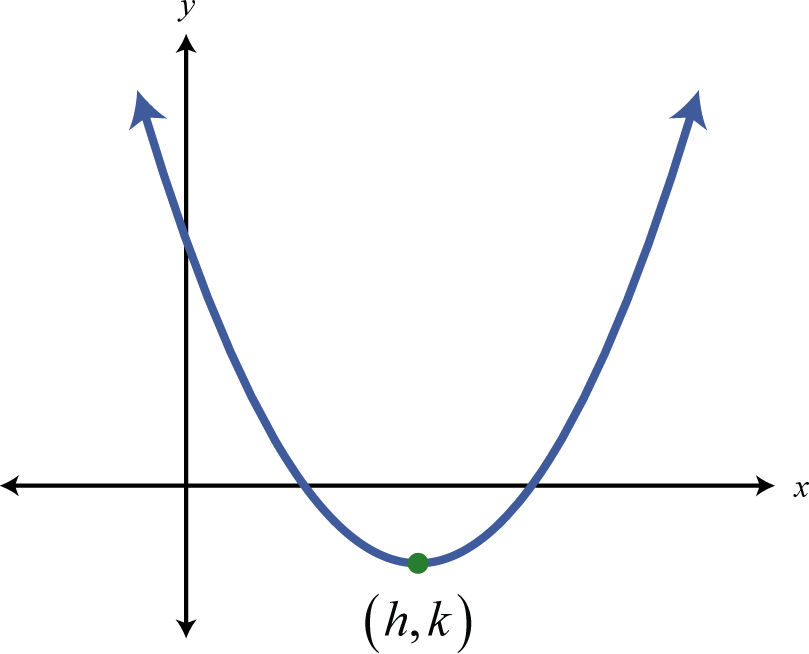
|
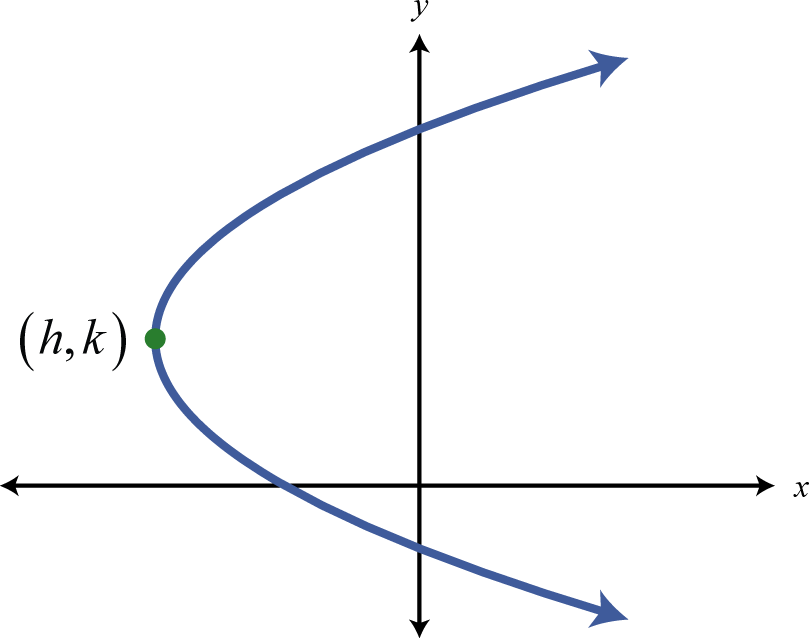
|
Parabola: |
|
|
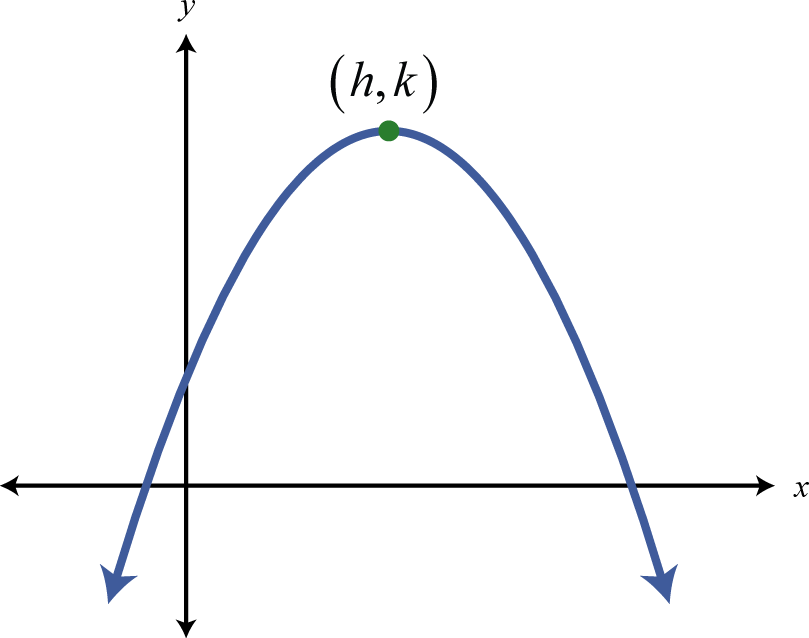
|

|
If the equation is quadratic in both variables, where the coefficients of the squared terms are the same, then its graph will be a circle.
Circle: |
|
|---|---|
|
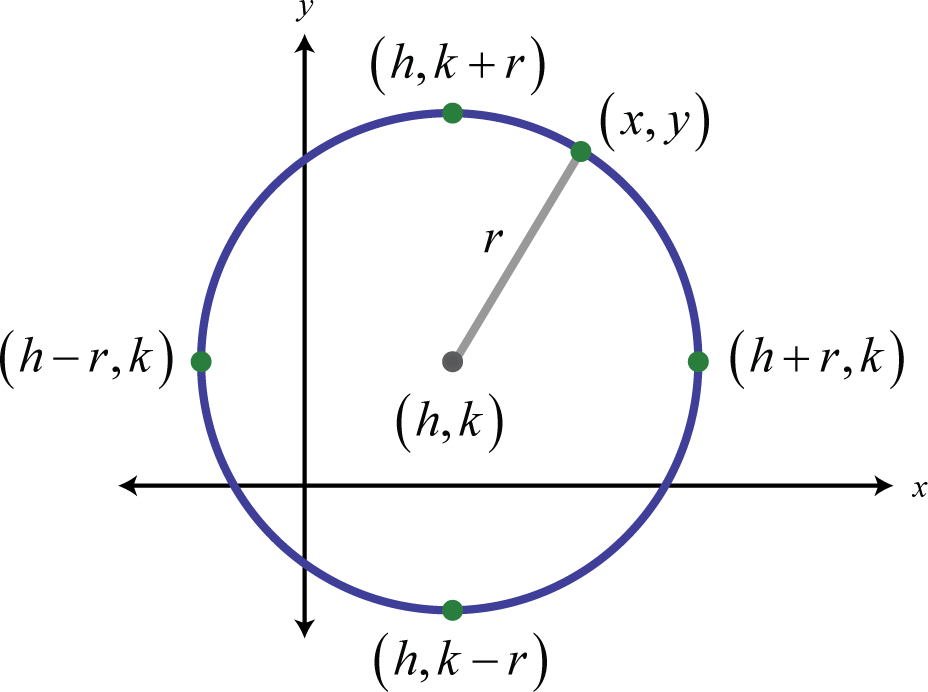
|
If the equation is quadratic in both variables where the coefficients of the squared terms are different but have the same sign, then its graph will be an ellipse.
Ellipse: and |
|
|
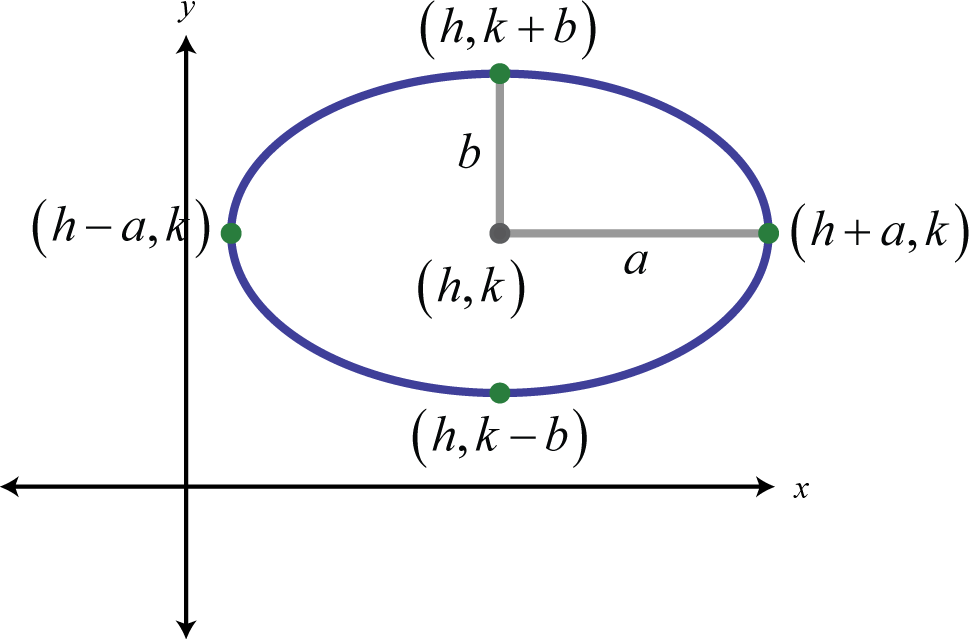
|
If the equation is quadratic in both variables where the coefficients of the squared terms have different signs, then its graph will be a hyperbola.
Hyperbola: and |
|
|

|
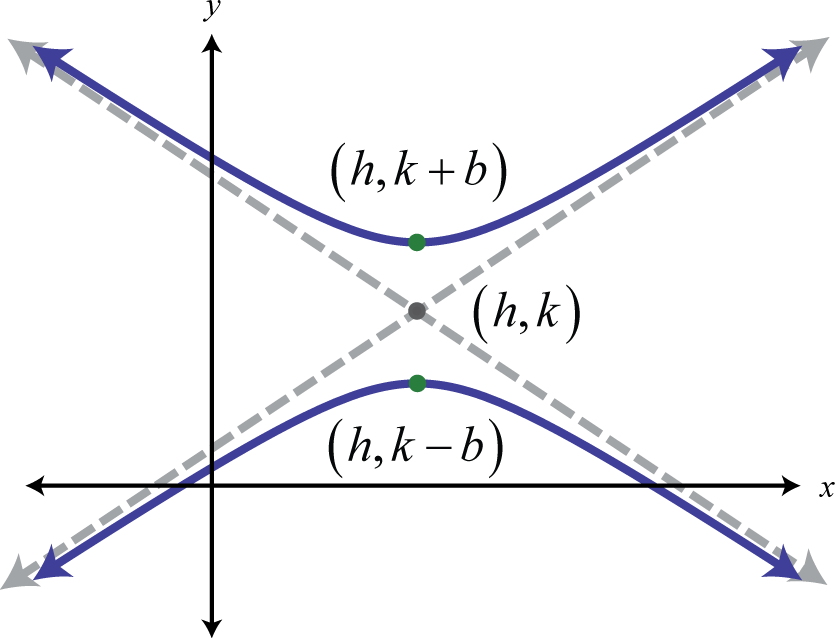
|
Identify the graph of each equation as a parabola, circle, ellipse, or hyperbola.
Solution:
The equation is quadratic in both x and y where the leading coefficients for both variables is the same, 4.
This is an equation of a circle centered at the origin with radius 1/2.
The equation is quadratic in both x and y where the leading coefficients for both variables have different signs.
This is an equation of a hyperbola opening left and right centered at the origin.
The equation is quadratic in y only.
This is an equation of a parabola opening right with vertex
Answer:
Given the equation of a hyperbola in standard form, determine its center, which way the graph opens, and the vertices.
Determine the standard form for the equation of a hyperbola given the following information.
Center , , , opens left and right.
Center , , , opens up and down.
Center , , , opens up and down.
Center , , , opens left and right.
Center , , ,opens up and down.
Center , , , opens left and right.
Graph.
Find the x- and y-intercepts.
Find the equation of the hyperbola with vertices and a conjugate axis that measures 12 units.
Find the equation of the hyperbola with vertices and and a conjugate axis that measures 6 units.
Rewrite in standard form and graph.
Given the general form, determine the intercepts.
Find the equations of the asymptotes to the given hyperbola.
Given the graph of a hyperbola, determine its equation in general form.
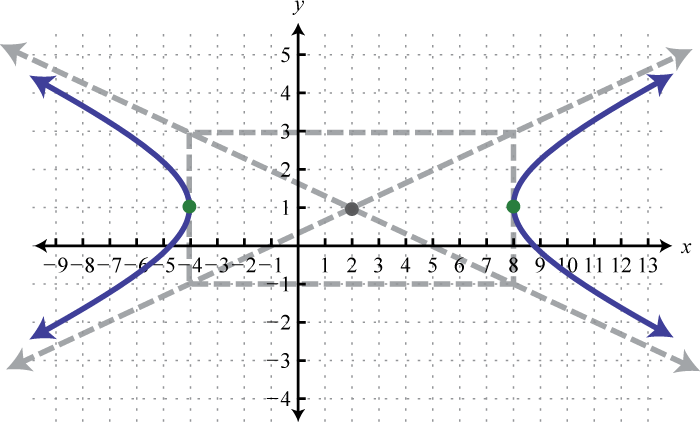
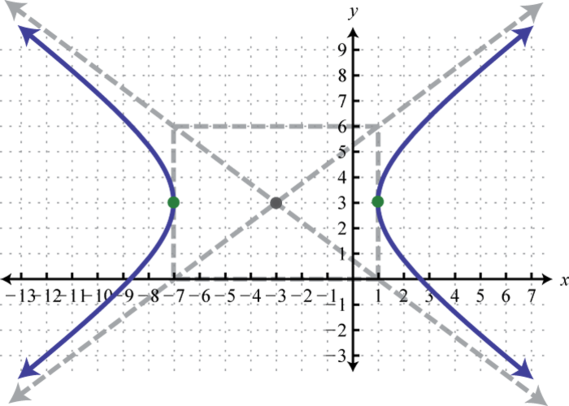
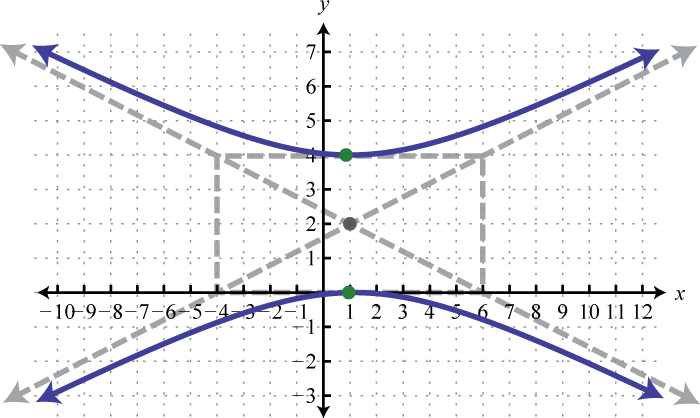
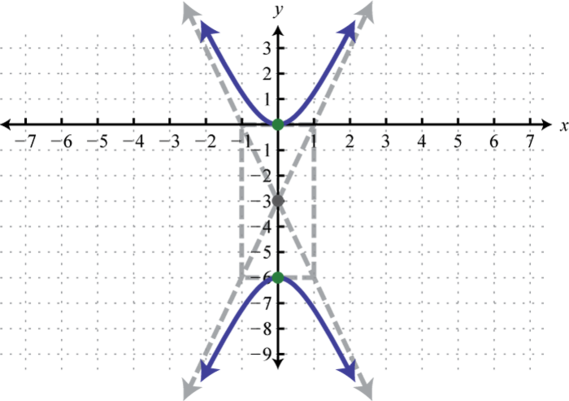
Identify the following as the equation of a line, parabola, circle, ellipse, or hyperbola.
Identify the conic sections and rewrite in standard form.
Develop a formula for the equations of the asymptotes of a hyperbola. Share it along with an example on the discussion board.
Make up your own equation of a hyperbola, write it in general form, and graph it.
Do all hyperbolas have intercepts? What are the possible numbers of intercepts for a hyperbola? Explain.
Research and discuss real-world examples of hyperbolas.
Center: ; ; ; opens left and right; vertices: ,
Center: ; , ; opens upward and downward; vertices: ,
Center: ; , ; opens upward and downward; vertices: ,
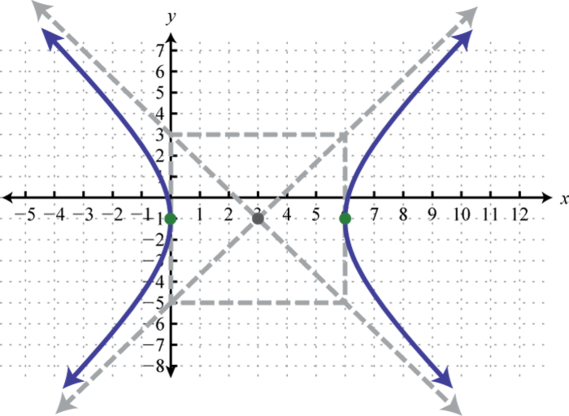
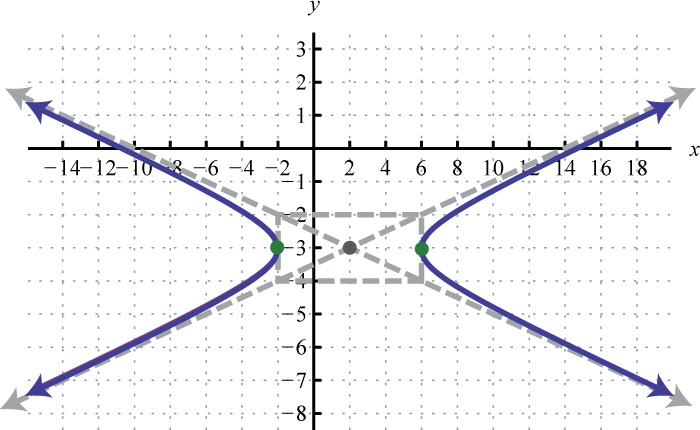
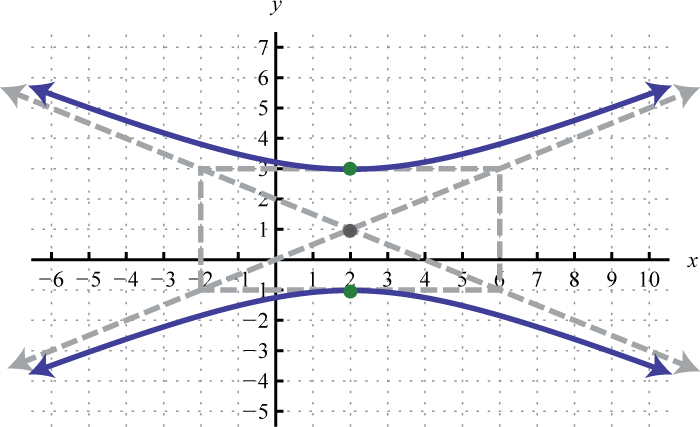
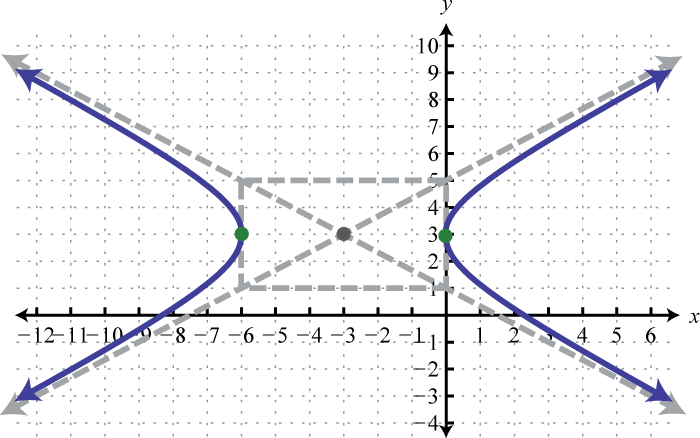
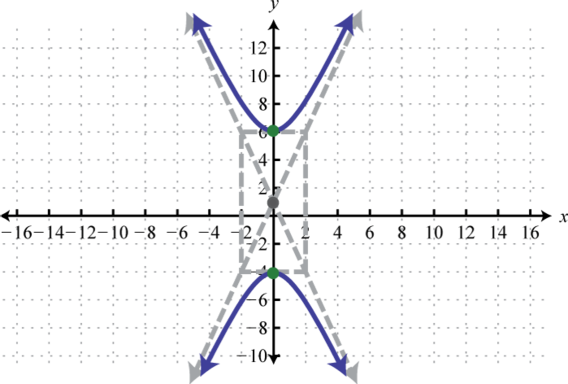
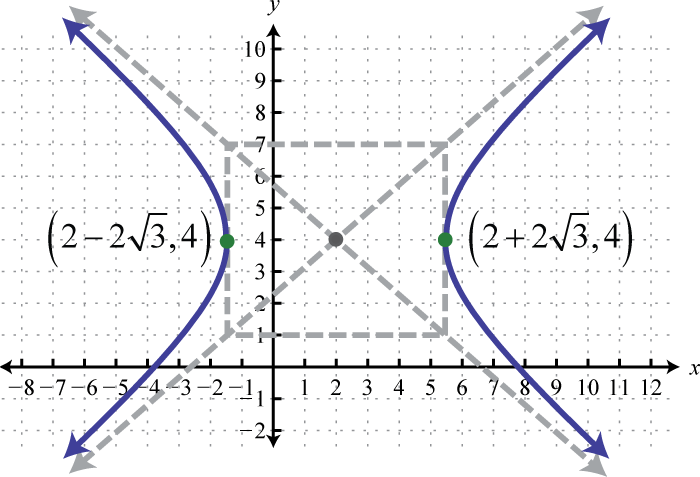
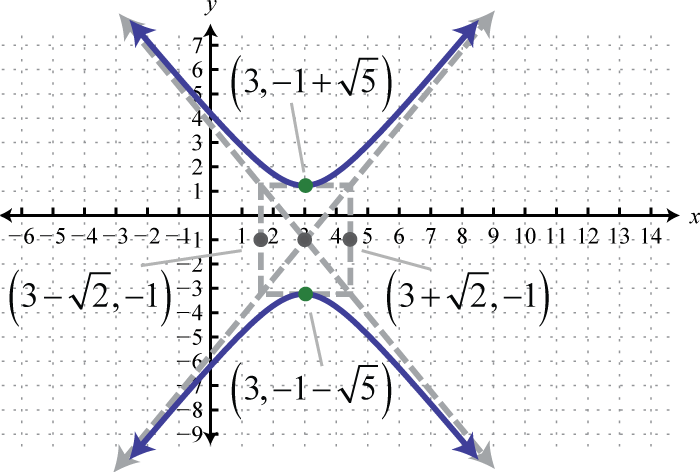
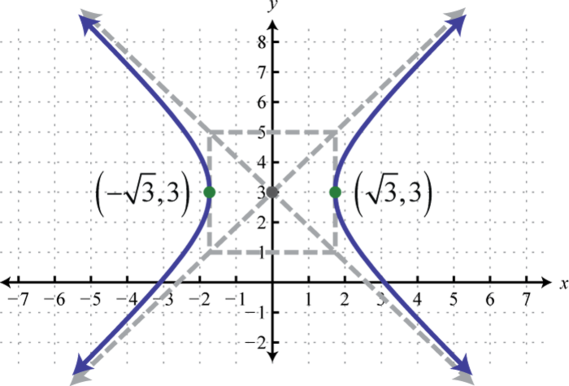
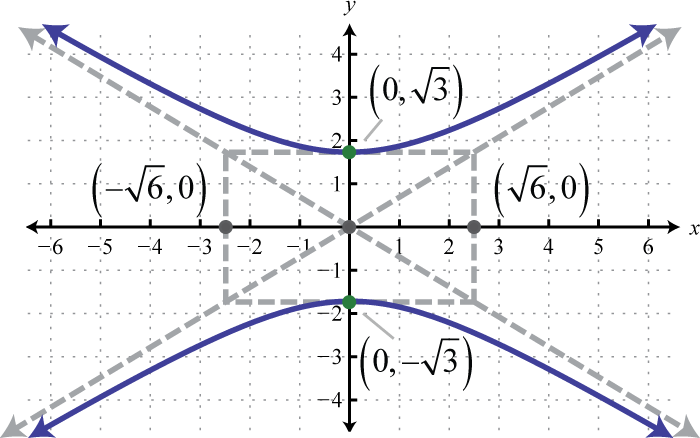
x-intercepts: ; y-intercepts: none
x-intercepts: none; y-intercepts:
x-intercepts: ; y-intercepts: none
x-intercepts: ; y-intercepts: none
;
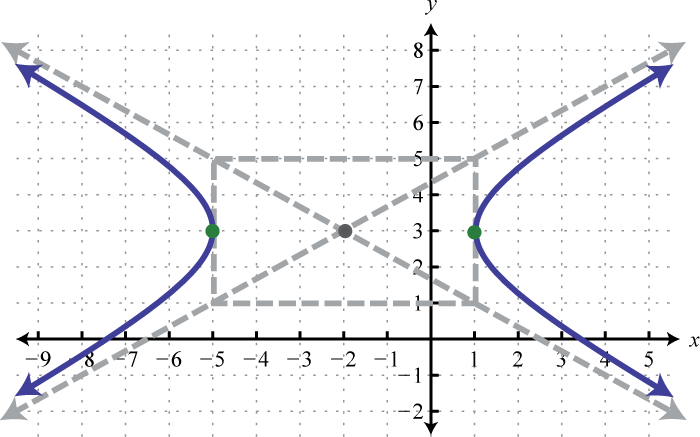
;
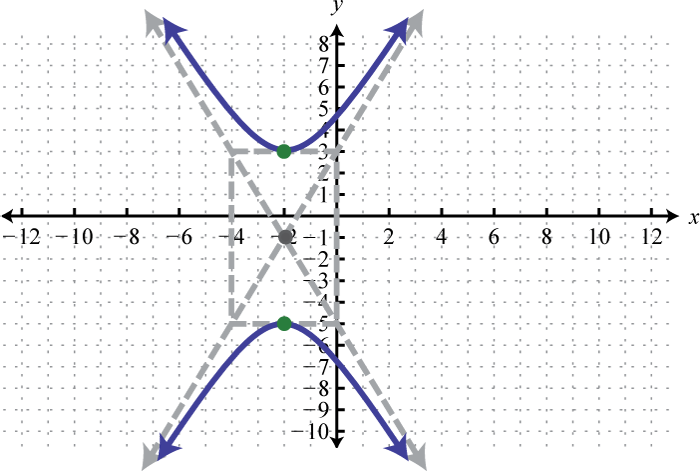
;
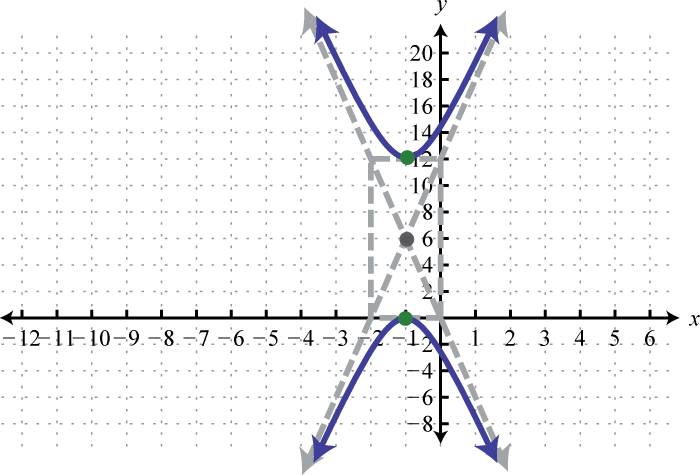
;

;
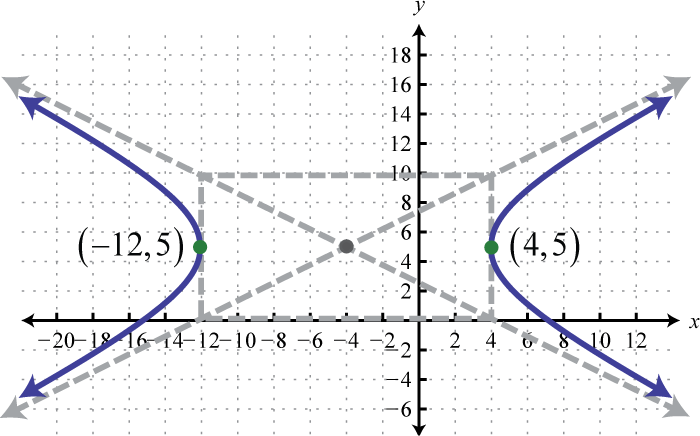
;
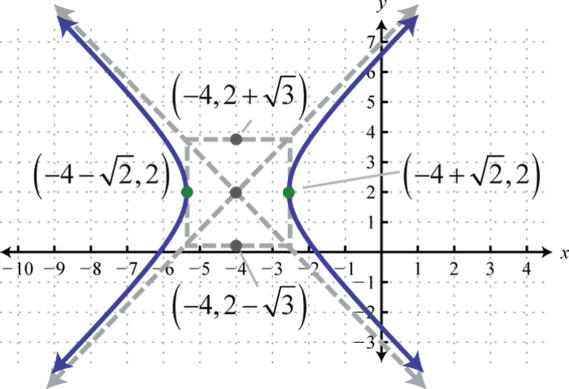
;
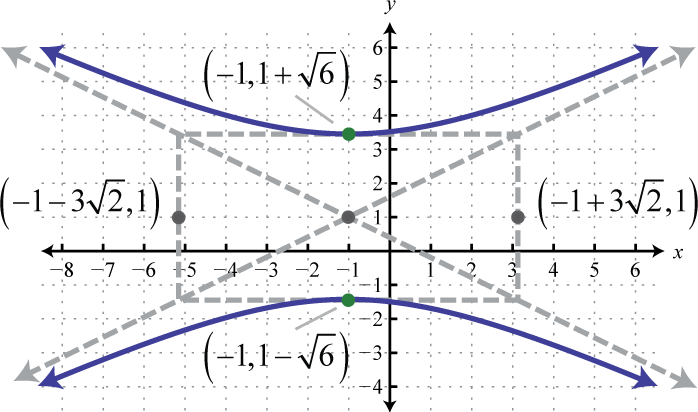
;

;
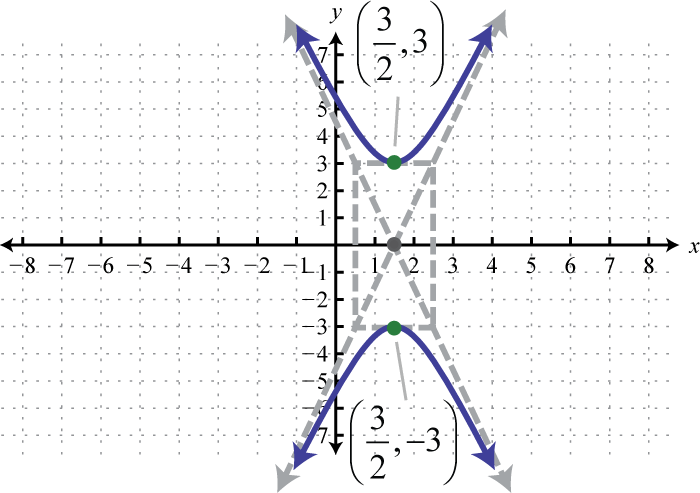
x-intercepts: , ; y-intercepts:
x-intercepts: ; y-intercepts: none
x-intercepts: , ; y-intercepts: ,
,
,
Circle
Ellipse
Hyperbola
Hyperbola
Line
Parabola;
Hyperbola;
Ellipse;
Circle;
Parabola;
Answer may vary
Answer may vary
A system of equations where at least one equation is not linear is called a nonlinear systemA system of equations where at least one equation is not linear.. In this section we will use the substitution method to solve nonlinear systems. Recall that solutions to a system with two variables are ordered pairs that satisfy both equations.
Solve: .
Solution:
In this case we begin by solving for x in the first equation.
Substitute into the second equation and then solve for y.
Here there are two answers for y; use to find the corresponding x-values.
Using |
Using |
|---|---|
This gives us two ordered pair solutions, and
Answer: ,
In the previous example, the given system consisted of a line and a circle. Graphing these equations on the same set of axes, we can see that the two ordered pair solutions correspond to the two points of intersection.
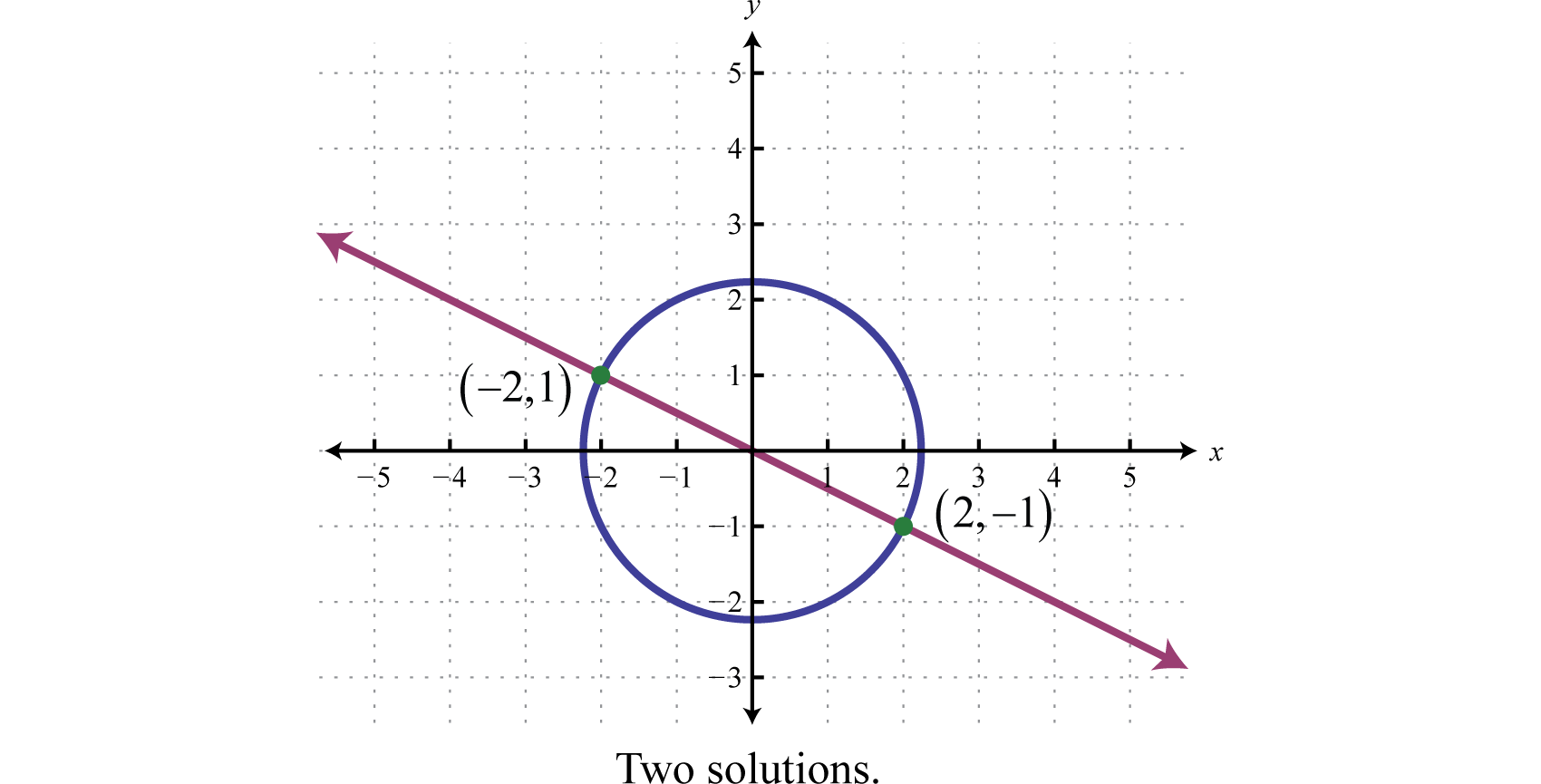
If we are given a system consisting of a circle and a line, then there are 3 possibilities for real solutions—two solutions as pictured above, one solution, or no solution.
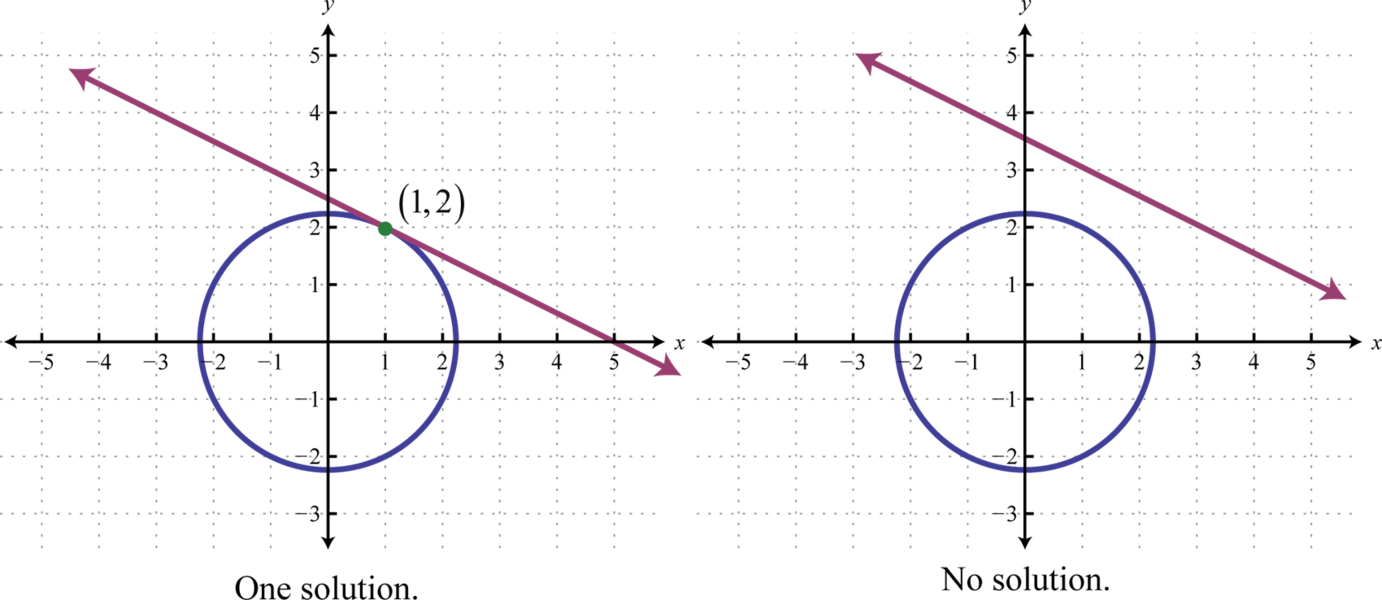
Solve: .
Solution:
Solve for y in the first equation.
Next, substitute into the second equation and then solve for x.
The resulting equation does not factor. Furthermore, using , , and we can see that the discriminant is negative:
We conclude that there are no real solutions to this equation and thus no solution to the system.
Answer: Ø
If given a circle and a parabola, then there are 5 possibilities for solutions.
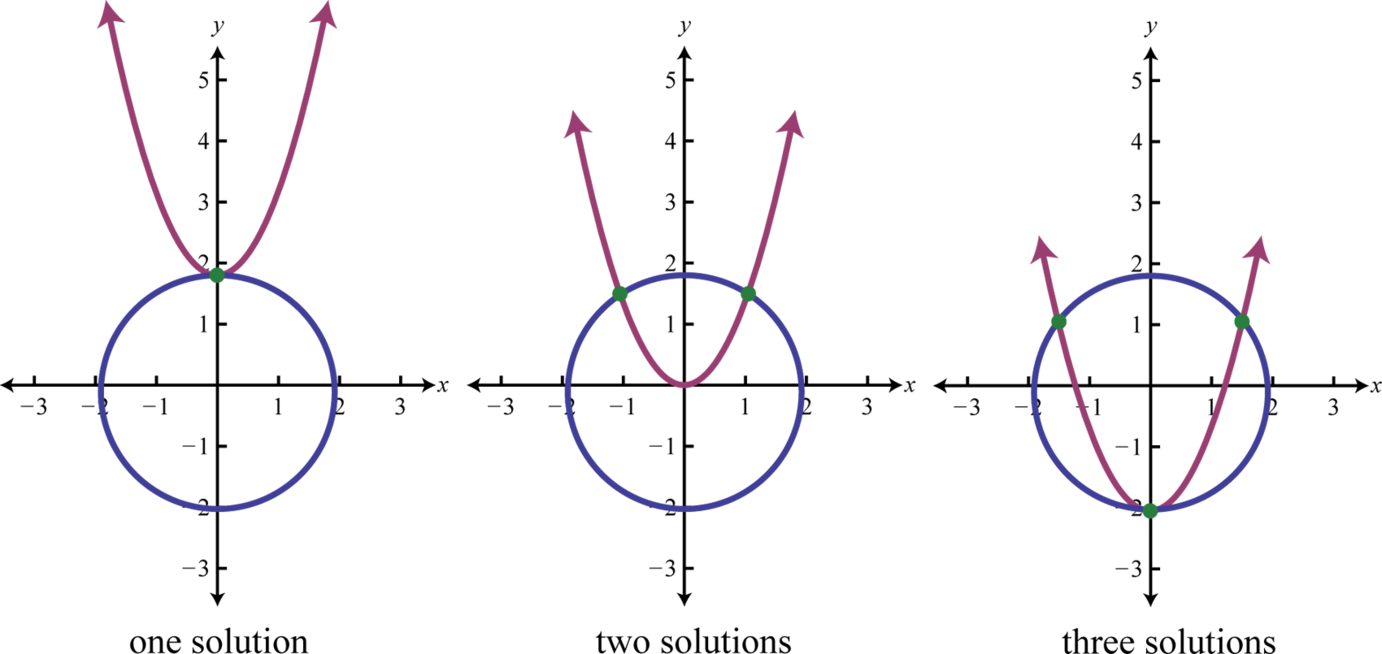

When using the substitution method, we can perform the substitution step using entire algebraic expressions. The goal is to produce a single equation in one variable that can be solved using the techniques learned up to this point in our study of algebra.
Solve: .
Solution:
We can solve for in the second equation.
Substitute into the first equation and then solve for y.
Back substitute into to find the corresponding x-values.
Using |
Using |
|---|---|
This leads us to four solutions, and
Answer: ,
Solve: .
Solution:
We can solve for in the second equation,
Substitute into the first equation and then solve for x.
Back substitute into to find the corresponding y-values.
Using |
Using |
|---|---|
This leads to three solutions, and
Answer: ,
Solve: .
Solution:
Solve for in the second equation.
Substitute into the first equation and then solve for x.
This leaves us with a rational equation. Make a note that and multiply both sides by
At this point we can see that both factors are the same. Apply the zero product property.
Back substitute into to find the corresponding y-values.
Using |
Using |
|---|---|
This leads to two solutions.
Answer: ,
Solve.
The sum of the squares of two positive integers is 10. If the first integer is added to twice the second integer, the sum is 7. Find the integers.
The diagonal of a rectangle measures units and has a perimeter equal to 6 units. Find the dimensions of the rectangle.
For what values of b will the following system have real solutions?
For what values of m will the following system have real solutions?
Solve.
The difference of the squares of two positive integers is 12. The sum of the larger integer and the square of the smaller is equal to 8. Find the integers.
The difference between the length and width of a rectangle is 4 units and the diagonal measures 8 units. Find the dimensions of the rectangle. Round off to the nearest tenth.
The diagonal of a rectangle measures p units and has a perimeter equal to 2q units. Find the dimensions of the rectangle in terms of p and q.
The area of a rectangle is p square units and its perimeter is 2q units. Find the dimensions of the rectangle in terms of p and q.
Solve.
The diagonal of a rectangle measures units. If the area of the rectangle is 12 square units, find its dimensions.
The area of a rectangle is 48 square meters and the perimeter measures 32 meters. Find the dimensions of the rectangle.
The product of two positive integers is 72 and their sum is 18. Find the integers.
The sum of the squares of two positive integers is 52 and their product is 24. Find the integers.
Solve.
How many real solutions can be obtained from a system that consists of a circle and a hyperbola? Explain.
Make up your own nonlinear system, solve it, and provide the answer. Also, provide a graph and discuss the geometric interpretation of the solutions.
,
,
,
,
Ø
,
,
1, 3
Ø
, ,
Ø
, ,
,
, , ,
, , ,
2, 4
units by units
, , ,
,
Ø
2 units by 6 units
6, 12
,
Answer may vary
Calculate the distance and midpoint between the given two points.
and
and
and
and
and
and
Determine the area of a circle whose diameter is defined by the given two points.
and
and
and
and
Rewrite in standard form and give the vertex.
Rewrite in standard form and graph. Be sure to find the vertex and all intercepts.
Determine the center and radius given the equation of a circle in standard form.
Determine standard form for the equation of the circle:
Center with radius
Center with radius
Center with radius
Center with radius
Circle whose diameter is defined by and
Circle whose diameter is defined by and
Find the x- and y-intercepts.
Graph.
Rewrite in standard form and graph.
Given the equation of an ellipse in standard form, determine its center, orientation, major radius, and minor radius.
Determine the standard form for the equation of the ellipse given the following information.
Center with and
Center with and
Center with and
Center with and
Find the x- and y-intercepts.
Graph.
Rewrite in standard form and graph.
Given the equation of a hyperbola in standard form, determine its center, which way the graph opens, and the vertices.
Determine the standard form for the equation of the hyperbola.
Center , , , opens up and down.
Center , , , opens left and right.
Center , , , opens left and right.
Center , , , opens up and down.
Find the x- and y-intercepts.
Graph.
Rewrite in standard form and graph.
Identify the conic sections and rewrite in standard form.
Given the graph, write the equation in general form.
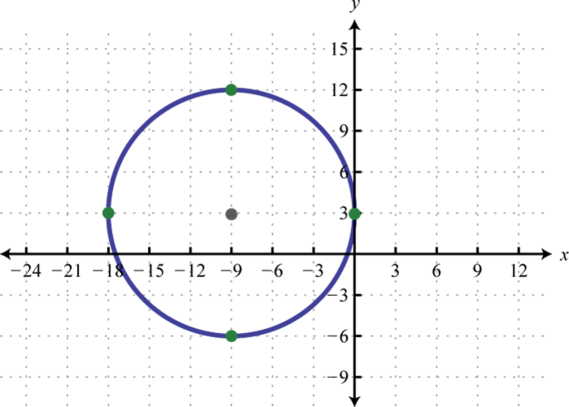
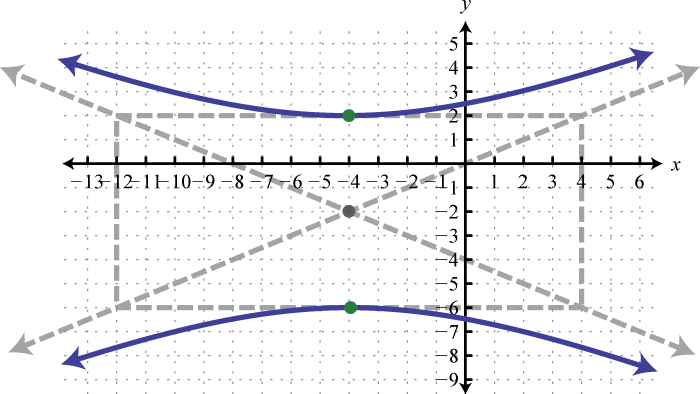
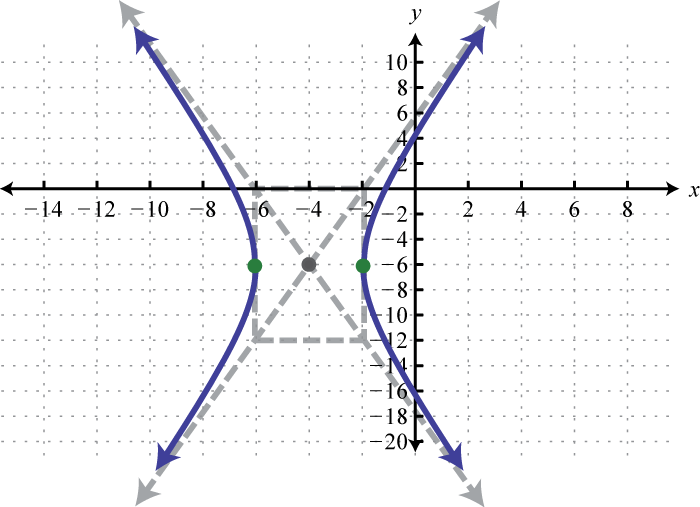

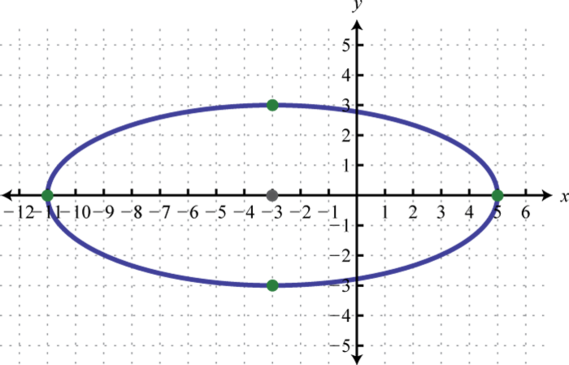

Solve.
Distance: 5 units; midpoint:
Distance: units; midpoint:
Distance: units; midpoint:
square units
square units
; vertex:
; vertex:
; vertex:
; vertex:
;

;

;
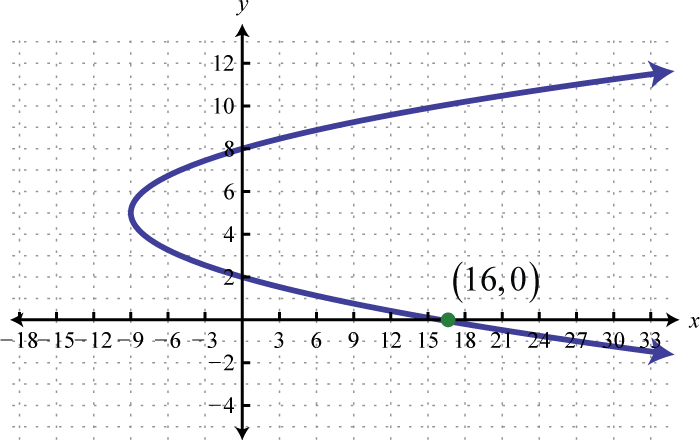
;
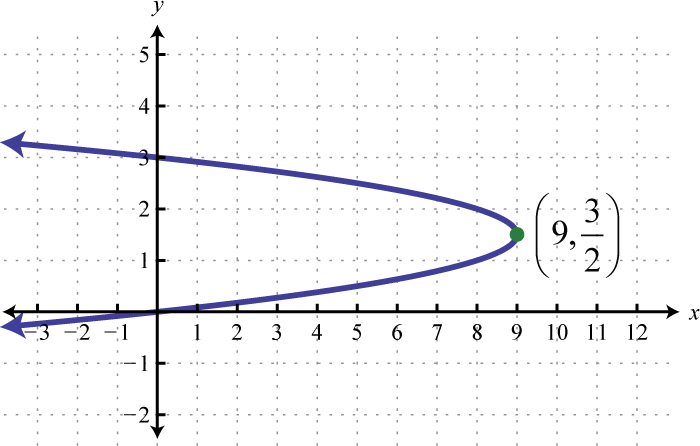
;
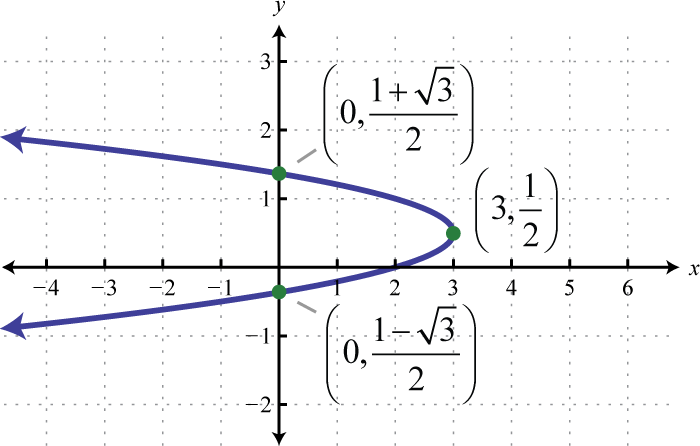
Center: ; radius:
Center: ; radius:
x-intercepts: none; y-intercepts:
x-intercepts: ; y-intercepts:
x-intercepts: none; y-intercepts: ,
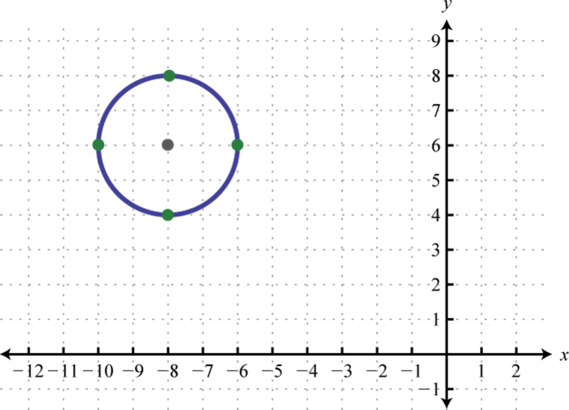

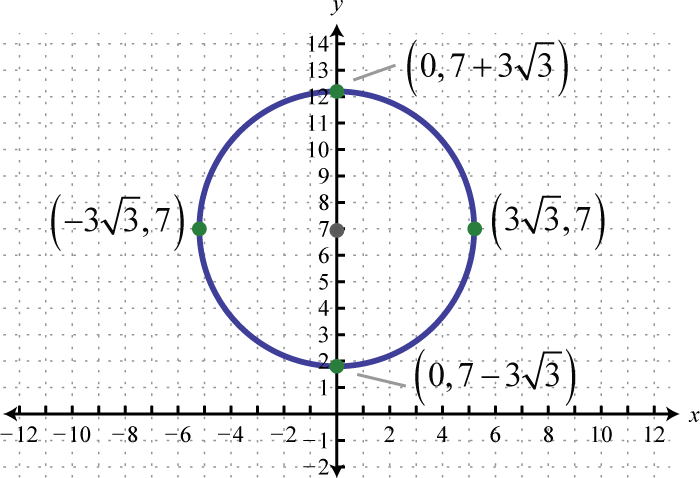
;

;
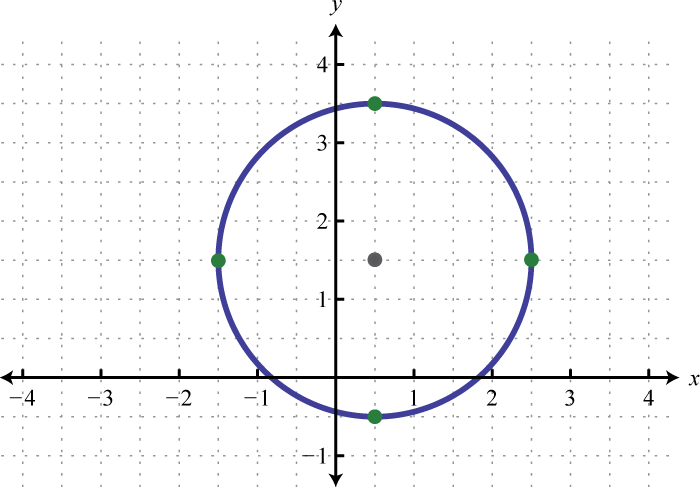
;

Center: ; orientation: horizontal; major radius: 4 units; minor radius: 2 units
Center: ; orientation: vertical; major radius: units; minor radius: 1 unit
x-intercepts: , ; y-intercepts:
x-intercepts: ; y-intercepts:
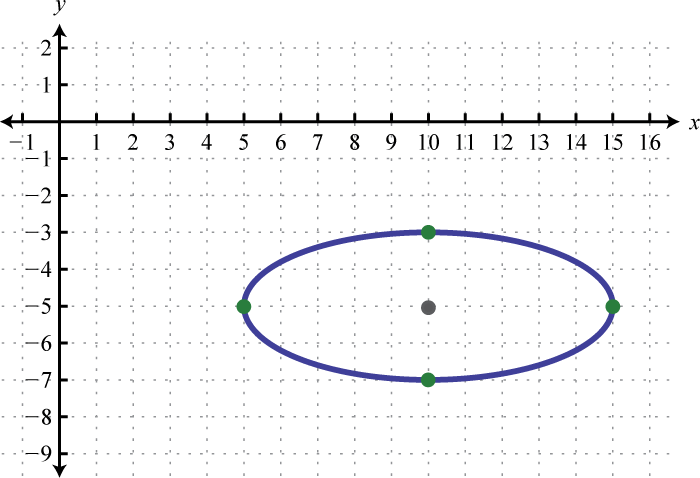

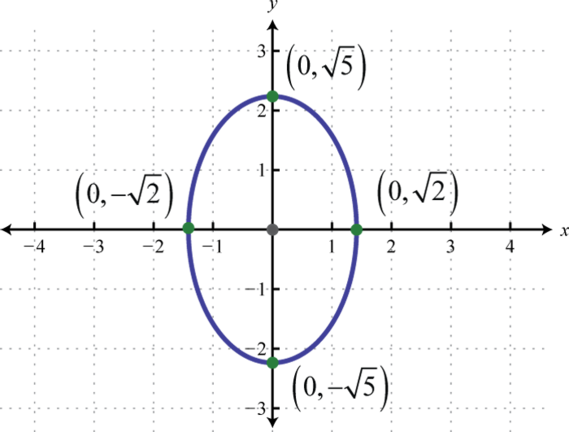
;
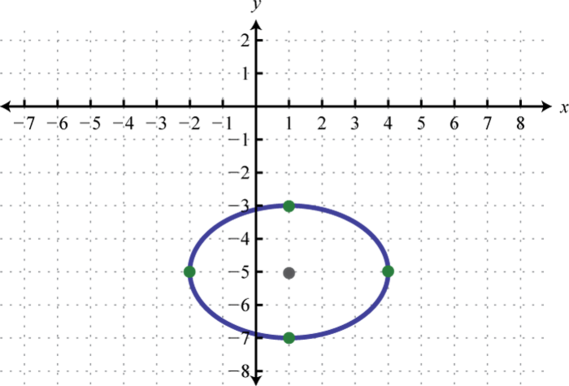
;

;

Center: ; opens left and right; vertices: ,
Center: ; opens upward and downward; vertices: ,
x-intercepts: ; y-intercepts: none
x-intercepts: ; y-intercepts: ,
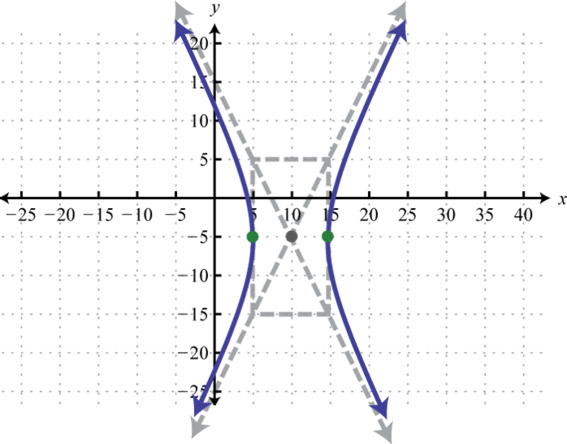
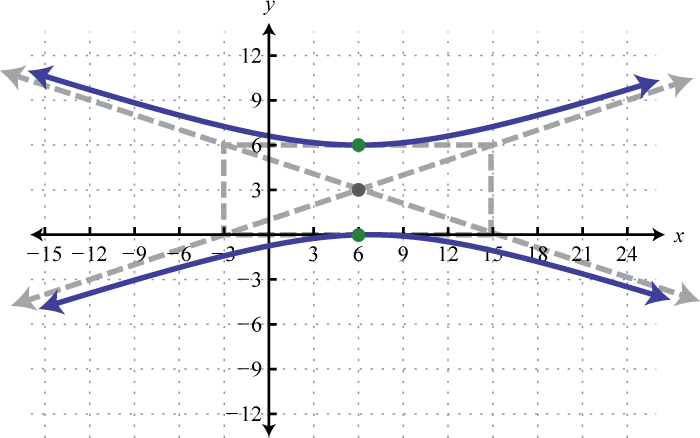
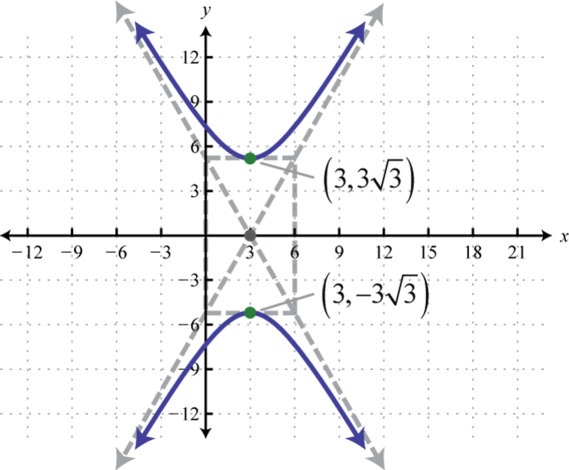
;
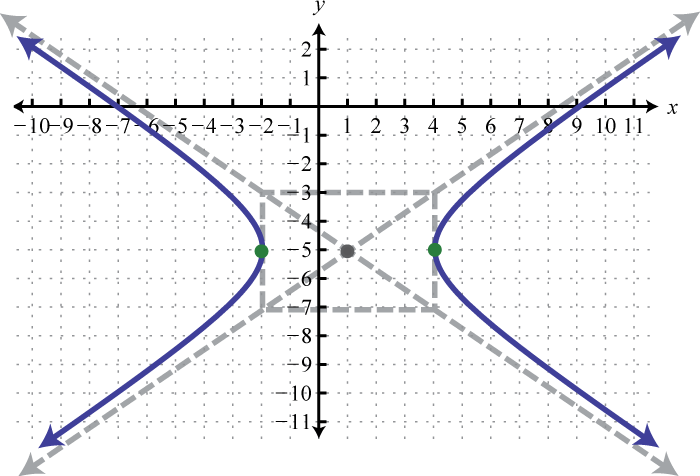
;
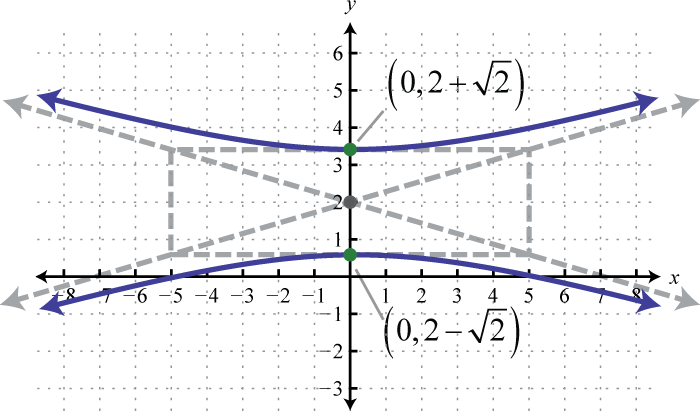
;
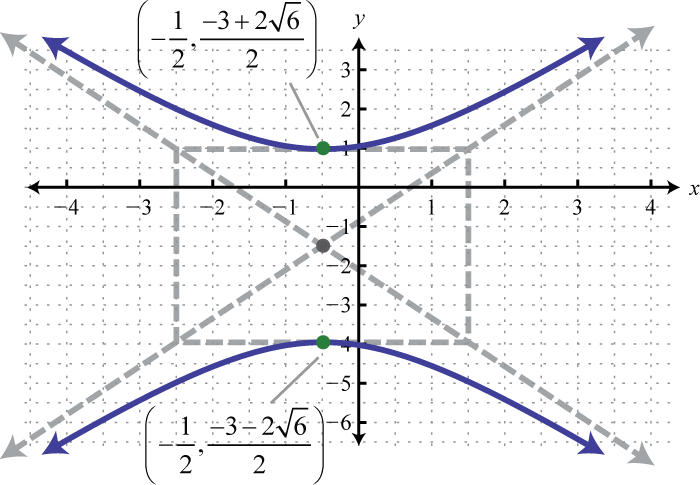
Circle;
Hyperbola;
Ellipse;
Hyperbola;
Hyperbola;
,
,
,
, , ,
, , ,
Given two points and :
Determine the area of a circle whose diameter is defined by the points and
Rewrite in standard form and graph. Find the vertex and all intercepts if any.
Find the equation of a circle in standard form with center and radius units.
Sketch the graph of the conic section given its equation in standard form.
Rewrite in standard form and graph.
Find the x- and y-intercepts.
Solve.
Find the equation of an ellipse in standard form with vertices and and a minor radius 2 units in length.
Find the equation of a hyperbola in standard form opening left and right with vertices and a conjugate axis that measures 10 units.
Given the graph of the ellipse, determine its equation in general form.

A rectangular deck has an area of 80 square feet and a perimeter that measures 36 feet. Find the dimensions of the deck.
The diagonal of a rectangle measures centimeters and the perimeter measures 20 centimeters. Find the dimensions of the rectangle.
;

;
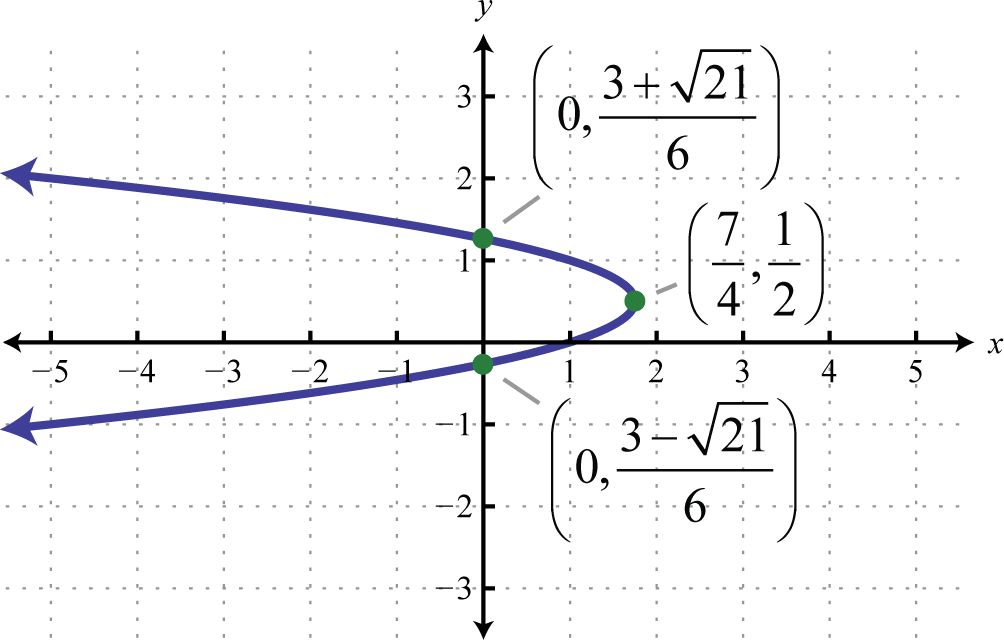
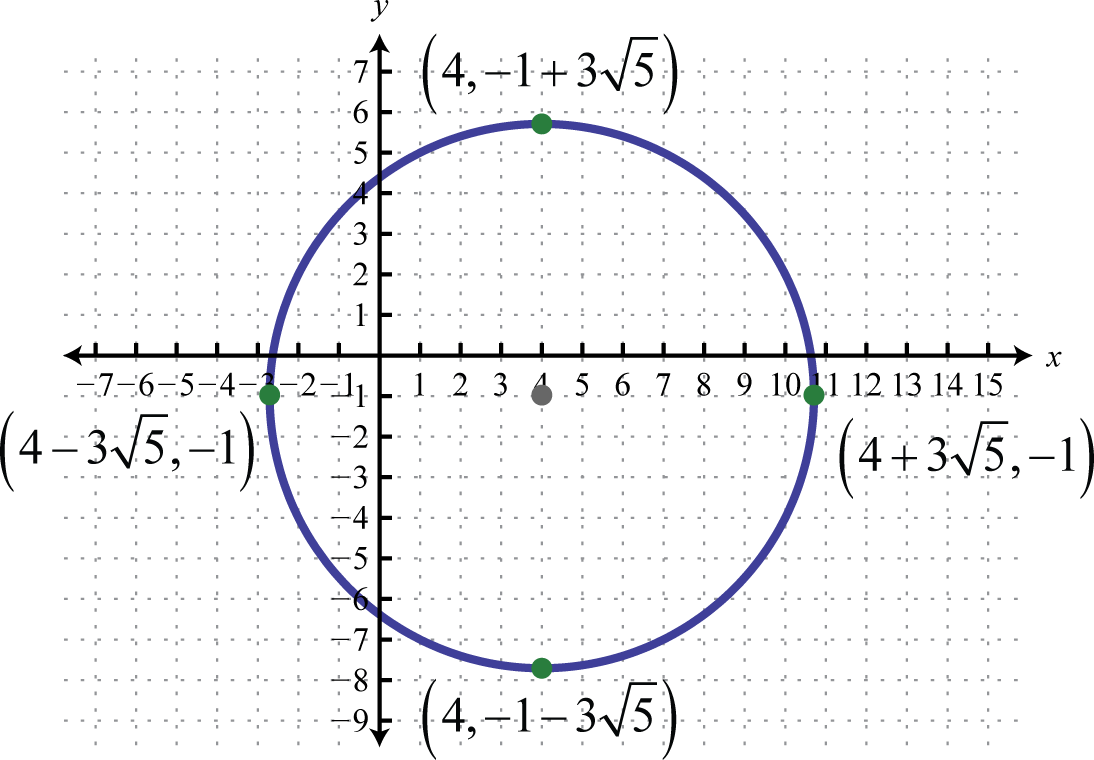
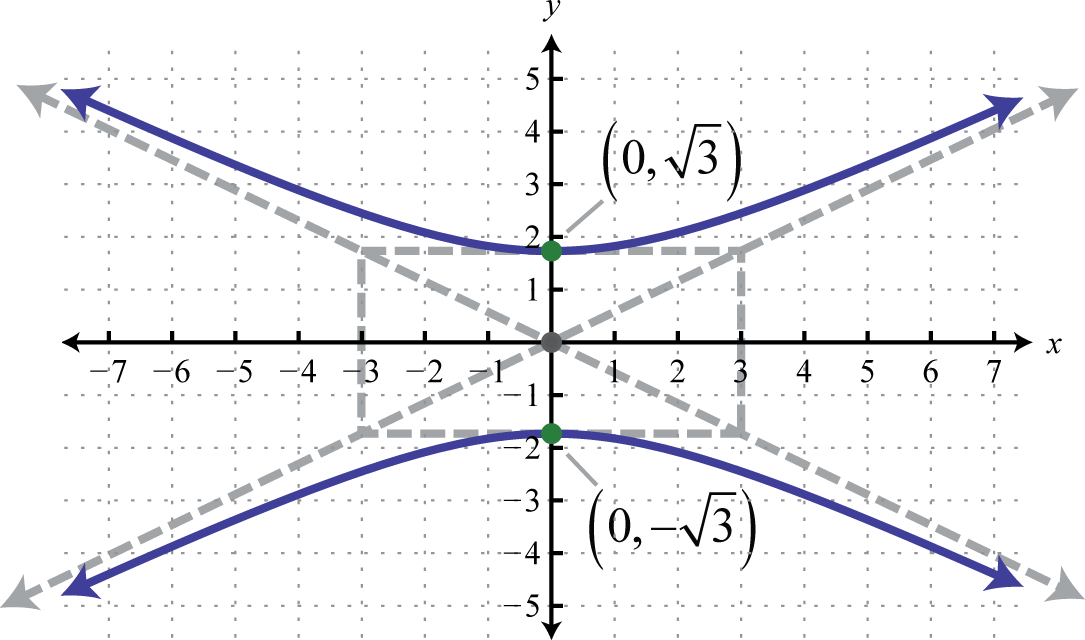
;
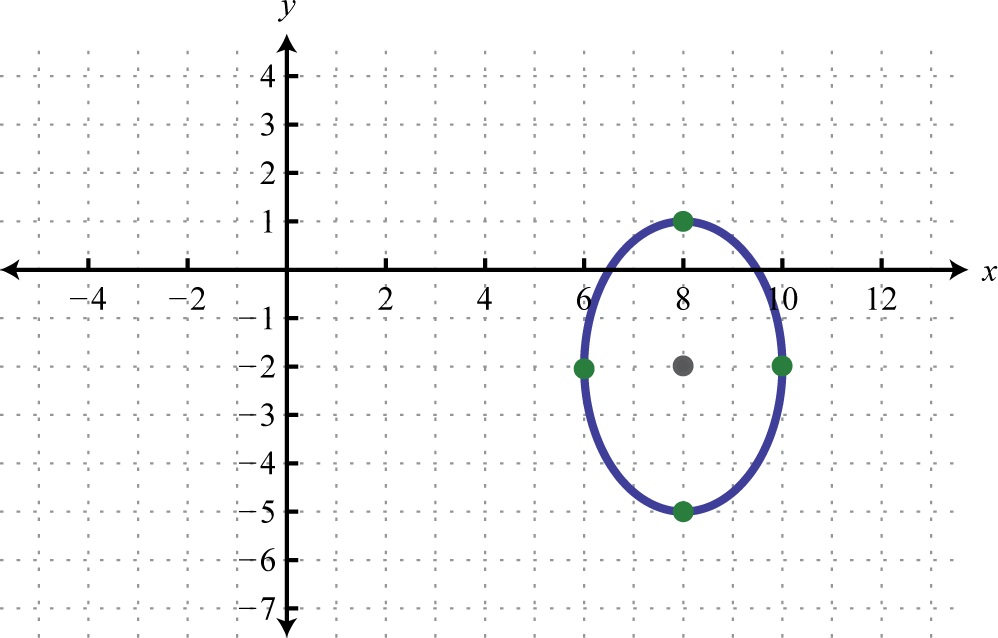
;
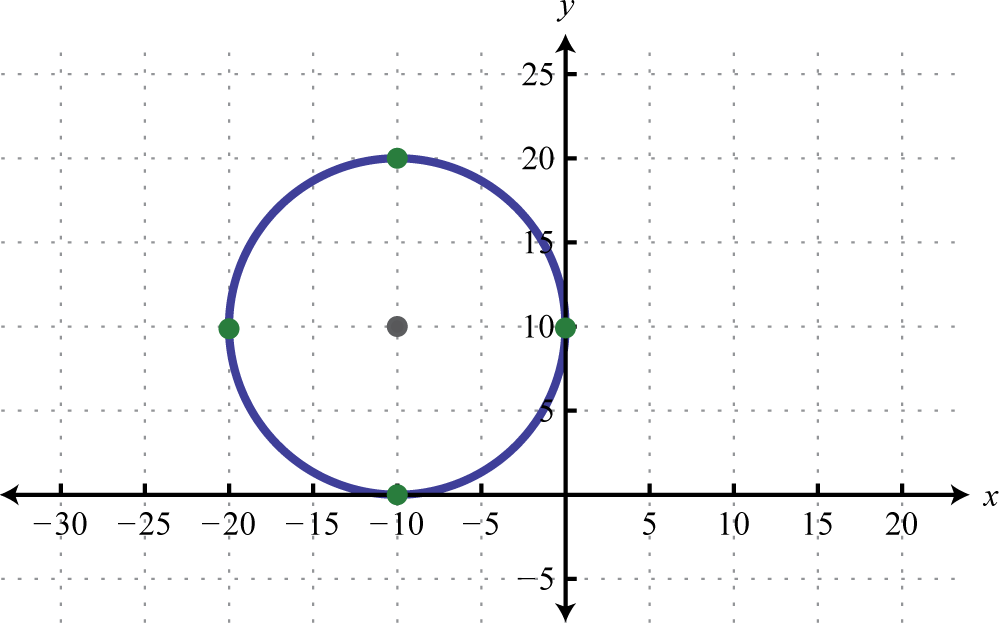
x-intercept: ; y-intercepts:
,
Ø
6 centimeters by 4 centimeters